THIS PAGE IS THE VISUAL REPOSITORY FOR THE LITTLEDEAN CELTIC HEADS. THIS IS AN UNIQUE COLLECTION OF STONE HEADS FROM IRON AGE AND ROMAN BRITAIN. THE HEADS ARE HAND HELD FOR SCALE AND ARE NOT PHOTOGRAPHED TO ACADEMIC RECORDING STANDARDS.
Whereas stone carved heads in the Celtic idiom are common in Britain and research in recent years (Billingsley) has shown they have been made throughout history into present times, some academics have become increasingly sceptical that such objects were made in Britain before the Roman Conquest. Although Celtic heads are known from Continental Europe since the 4th century BC, there appears to be no publications for heads which have been found from stratified archaeological Iron Age contexts anywhere in Britain. Dr. Anne Ross wrote the most detailed account, arguing for a Celtic cult of the head in Pagan Celtic Britain, first published in 1967. Although nowhere in that volume did she state that stone heads in Britain were an Iron Age phenomenon, she concluded that a small number of heads had the attributes of pre Roman artefacts. It is clear however that she held the view that both stone and wooden heads were objects of ritual in the pre Roman Celtic World. Critics who have argued against a Cult of the Head as put forward by Anne Ross have a tendency to overlook her caution towards the existence of heads manifested in stone in pre-Roman Britain. She actually wrote “there are very few heads in stone which we can confidently date to the pre-Roman period”. She then discusses several menhirs with heads from Britain and their Iron Age parallels on the continent, as well as incised pebbles with simple faces from the British Isles of likely pre-Roman date.
Anyone familiar with the so called Celtic Head will immediately recognise a fundamental difference in the Littledean heads. Many are small and crude with the minimum of sculpting. These are, as an overall type, generally etched into suitably shaped small to medium sized stones. Only a few can be regarded as heads sculpted in three dimensional form e.g. NO.10. and then never has the back of the head been sculpted. As a class of British Iron Age objects and with the exception of the oval face masks, they appear at this point in time to have no precise parallels. Having inspected 65 heads in October 2019 Professor Miranda Aldhouse – Green considered that, given the way many of the heads are shaped and depicted, they have an emphasis on the eyes. Miranda Green deals at length, in her book The Gods of the Celts, with the evidence from France of healing in the Iron Age at the Fontes Sequanae, at the source of he river Seine and again at ‘Source des Roches de Chamalieres’ south of Clermont Ferrand. She describes how both sites show impressive evidence of eye complaints amongst the huge numbers of wooden votives. Many of the wooden figures at the Seine sanctuary although no more than simple rectangular blocks, have the head clearly shaped: “perhaps recognition is important, or perhaps the eye problems suggested by the closed eyes on many images, caused the head to receive special attention.” Given the evidence for varied geology amongst the heads Professor Green considered the Littledean site may have been on a pilgrimage route between shrines such as Lydney, half a dozen miles or so down the Severn estuary and elsewhere, which draws a direct parallel with pilgrims travelling to the springs at the source of the Seine during the 1st century BC. More recently Ece Sayram Okay argues the case for pilgrimage as central to the healing process, entailing specific designs of Roman architecture which can be highlighted by the ambulatory. This may be seen in the Littledean peristyle temple phases which replaced the early Romano Celtic water shrine. Perhaps in Britain as in the Graeco Roman world the Celtic shrines, very much open air affairs, held perambulation ‘sunwise’ around the sacred locus. Anne Ross in discussion with the late Professor Barri Jones observed that although the Littledean site was not at the source of the river Severn, the springs fed a tributary stream. She also believed that the horseshoe bend, Barrow Hill in the isthmus and the Severn bore probably held such huge symbolic significance as to make the site pre eminent as the cult shrine of the river goddess Sabrina. We should probably consider that wooden head votives may also have been deposited at Littledean which have not survived.
Since the above was written we have recovered many more heads as a result of targetted excavations between 2020 and 2023, particularly at the western end of the temple in the levels below the site of the cella. The results of the excavations have been very exciting and include a Middle Bronze Age cemetery, evidence that the foundations of the aedicula, which we assume housed the cult statue, is possibly the remnant of a prehistoric altar and confirmation that a c. 15m timber circle came long before the temple. Particularly startling was the discovery in January 2023 of the remains of what was first thought to be a pool, then a mortuary structure of an earthen long barrow and finally in June and July, sufficient evidence had accumulated to demonstrate the remains are indeed of a complex water system possibly of the Neolithic period, which is producing evidence for the possible manufacture and deposition of figurines. Through changing periods of weather this complex evolved into the small water shrine of the Late Iron Age/Early Roman period. These remains and associated artefacts will provide new information about the development of sacred ritual sites at water sources associated with prominent hilltops. Important and significant as these finds are it is undoubtedly the quantity of stone heads of all sizes from the most miniature to half a metre high which are nationally outstanding. In March 2023 we received confirmation that Professor Ian Armit of York University had made a successful bid to the The Leverhulme Trust and been awarded a Research Grant for the heads to be studied at the University.
The photographic images also include possible and probable head fragments. Professor Aldhouse – Green’s assessment of the Littledean site as a healing water shrine places a particular emphasis on these fragments, common at some continental shrines and which may represent specific parts of the face requiring treatment. It is quite likely that many of these fragments have been overlooked or are too decayed to identify. Consequently any statistical evaluation of the Littledean Stone Heads will need to take this into account. Further field observations during post excavation backfilling will give special attention to the stone debris in case more pieces can be recovered.
Some views and opinions expressed in this Gallery are my own (Don Macer-Wright) and consequently do not represent academic authority.
HEADS ARE SCALED BY HAND AND I HOPE THAT IN DUE COURSE FOLLOWING THE RESEARCH AT YORK UNIVERSITY WE SHALL BE ABLE TO DISPLAY THEM THROUGH 3D IMAGING METHODS

Find Spot East Bank Slope Pool 4a this head came from the top of the bank slope of pool 4a, which pool was cut into the supplementary water feed to the primary spring head Pool 1. The head showed evidence of erosion from water flow, smoothing and rounding the head features. Slight traces remain of ochre staining suggesting the head was ‘painted’ in red ochre.
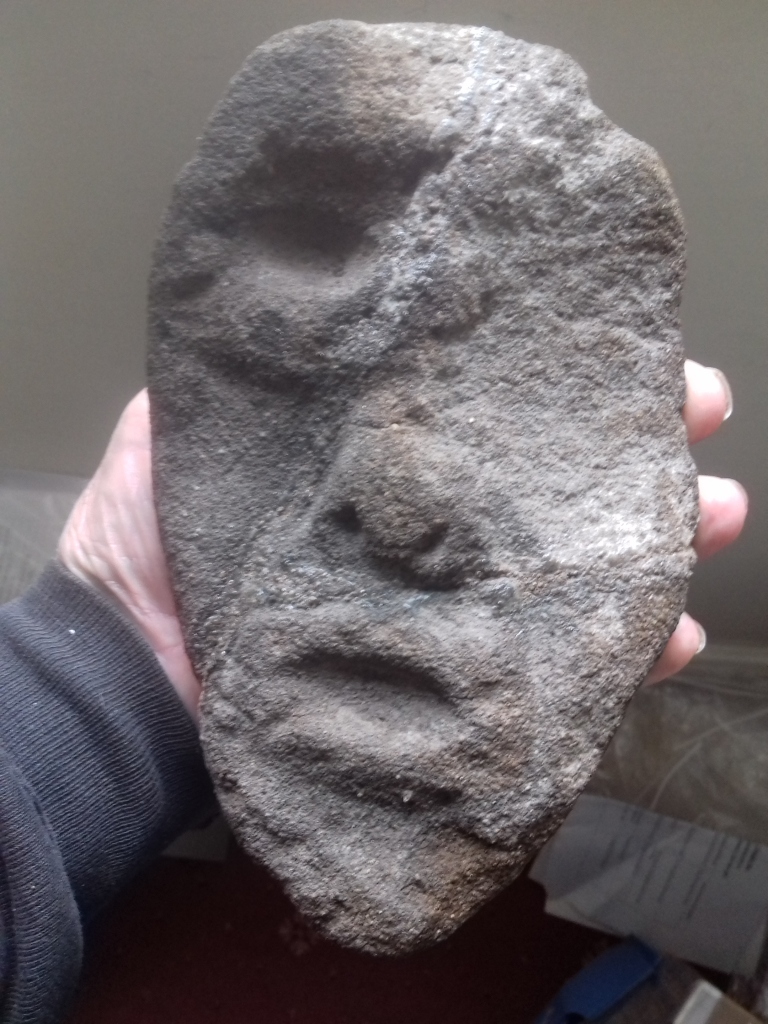
Find Spot in upcast soil during garden landscaping ponds in the walled garden west side of Dean Hall. The head was found roughly 25 metres north west of the medieval well house, where significant quantities of Roman painted plaster, pottery and opus signinum (Roman concrete) have been found. The sandstone geology, which has not yet been identified, does not appear to be local Old Red Sandstone. The mask has well defined nostrils. It is a residual find and probably Romano Celtic in date. The scar across one side of the face resulting from flaked off stone may have been deliberate and represent a real person’s accident trauma.

Find Spot Pool 5 in sandy silts at the bottom of the small pool fed by small water course flowing from Pool 1. Several other heads and fragments found (see below). Also a broken neolithic axe deposited in the pool bank slope, flint auger and iron ingots.

Find Spot Pool 5 in sandy silts at the bottom of the small pool fed by small water course flowing from Pool 1. The yellow green sandstone is very soft and grainy and has clearly become abraded from water erosion. As a Celtic face with lentoid eyes his tiny head was anomalous until Head 27. These tiny face masks may have been typical votive deposits for healing (Professor Green).
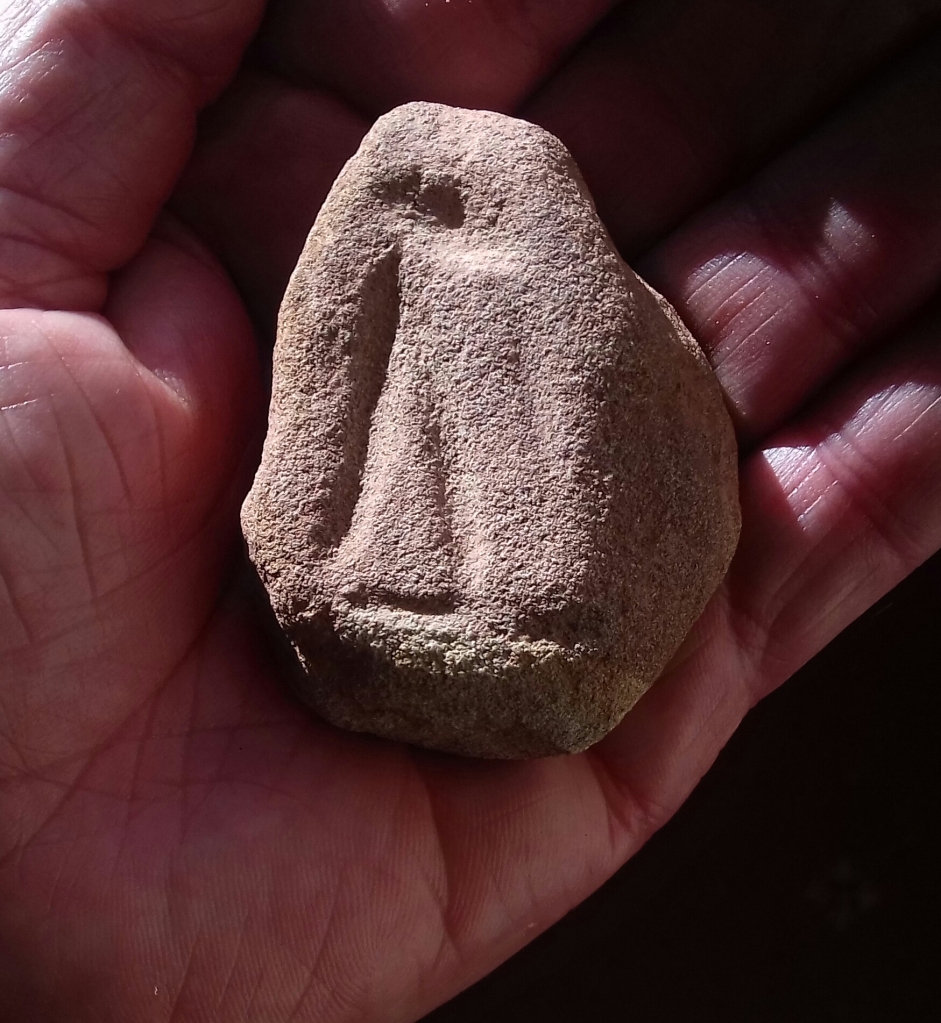
Find Spot Pool 5 in sandy silts at the bottom of the small pool fed by small water course flowing from Pool 1. This small mask came from the same context as H.4 and is identified as a face mask by association. It is worn from water erosion.

Find Spot in Post Excavation Backfill of Pool 5. This face mask also satisfies similar criteria for votive deposits. The stone appears to be slate or blue stone and most likely from Wales. The wear and polish suggests it was often handled and kept in a pocket or pouch. It can be defined as an apotropaic head deposited to fulfil a wish.

Find Spot Pool 1 below levelling layer of Iron Age pool levels prior to building the Roman nymphaeum. This is possibly a pre historic hand grinder for a saddle quern, which has been incised with ‘pinhole’ type eyes and possibly horns or antlers. However the lines over the eyes could be eyebrows and would thus represent pre Iron Age imagery. However head 8 below is clearly similar and appears to be more typically Iron Age. This suggests these crude faces may be early Iron Age.


Find Spot Pool 1 below levelling layer of Iron Age pool levels prior to building the Roman nymphaeum. This artefact may have been a pre historic hammer stone or flint knapping tool or may have been used as a pot boiler. The incisions above the eyes may be antlers. The opposite face Head 9 also looks like possible antlers. These images reworked on this artefact may be early/simple representations of the Celtic God Cernunnos, lord of the animals.

Find Spot Pool 1 sealed in clay silt deposits. This extraordinary head is a remarkable find with an iconic appearance. It is a stone head which defines what the archaic Celtic head can look like. The wedge shaped nose and lentoid eyes with empty stare and small defined mouth is categorically Celtic. The red ochre stain may be a reference to the metal smith, whose skin could be reddened by the dust of ore and ochre.
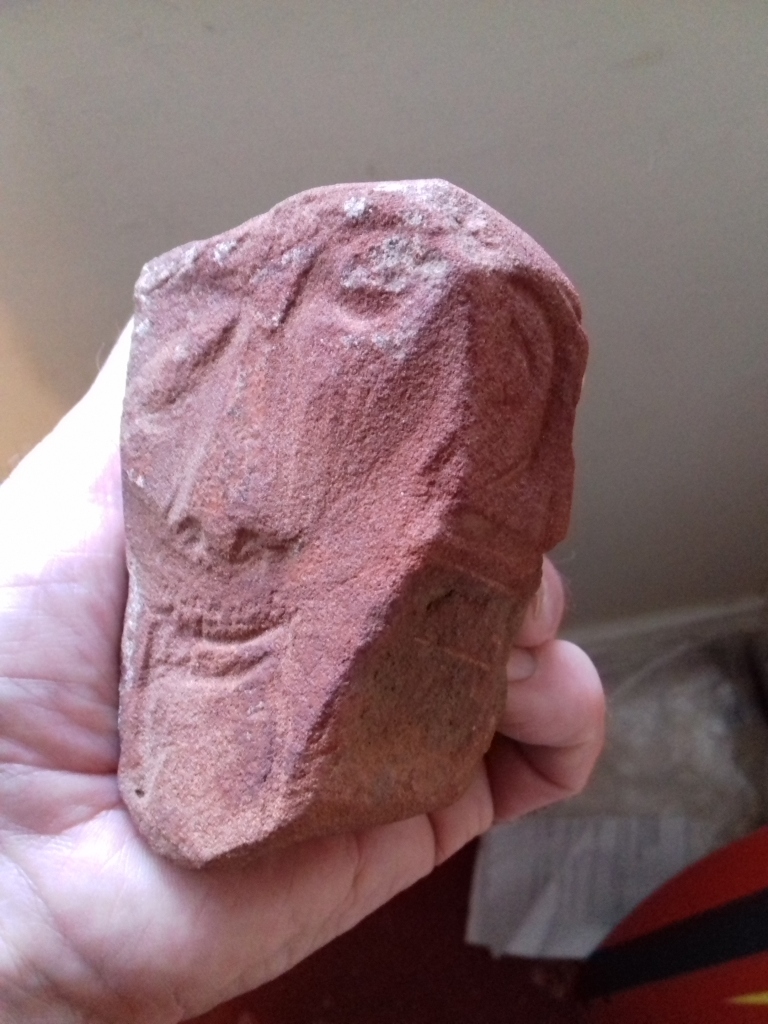
Find Spot Pool 1 from clay silt residues of pool. In unwashed stone artefacts box stored at Littledean Hall since 1984 with other red ochre stone examples from same context and with broken sandstone mace head. Another extraordinary red ochre head actually cut into red ochre stone. This head has a clearly defined ear, which is a rare feature amongst the heads, nostrils and long drooping moustache, reported in classical sources as an ethnic trait of the Celts.

Find Spot Stone Hole 3, which may have been a post pit to take a tree trunk as support for an anvil. This head had been placed in the bottom near the side of the pit with several pieces of iron slag, one of which is Head 13 below. This head was also liberally covered with ochre stain and provides compelling evidence, given the find contexts of this and Heads 10 and 11 for a ritual use of ochre relative to iron working. The pin hole and sunken eyes with clearly defined brow and slash for the mouth combine to create a powerful effect at one and the same time vacant and yet benevolent. The cranial ridge from the nose may be deliberate and appears to form a cross in the centre of the forehead. There is also the remnants of an ear on one side suggesting this was a complete depiction of a head. Given the contemporaneity of Heads 10 and 12 we can consider they may be considered exemplars of the hitherto unrecognised Celtic archaic head of Iron Age Britain possibly peculiar to the metal working district west of the Severn.

Find Spot Stone Hole 3 beside Head 12 above. This piece of slag has a similarity to a skull, not best seen in this photo, and given its association with Head 12 suggests the image of a head was seen in the slag. Several other pieces of slag, Heads 67,68 and 70 as single finds in water contexts do suggest they were placed in the water features as offerings, rather than the collective dumping of slag in ditches and disused pits which is more consistent with metal working refuse disposal.


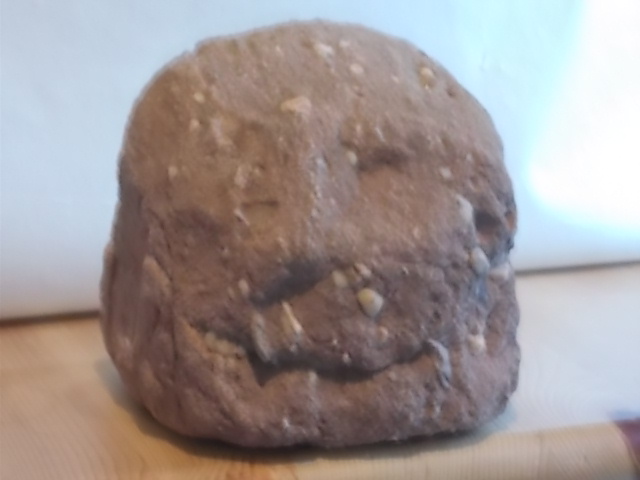
H.16 Head 16 Conglomerate Sandstone large crude ‘Bronderslev type head’ frontal face
The ‘Bronderslev type head’ refers to two Iron Age heads from Bronderslev in Denmark illustrated by Dr. Anne Ross in Pagan Celtic Britain opp pp.96. These two heads probably do not date to the 2nd C BC or earlier as previously written. They were found with masses of broken pot sherds dating from the late pre Roman and Early Roman Iron Age in Jutland. One stood on a pile of broken sherds of early 1st century pottery. It has minimal features barely describing eyes and mouth and typify the most basic representation of the sculpted human head whereby stones with natural features have been enhanced. This Littledean example satisfies similar criteria whereby the minimum of stone working has enhanced and made use of natural features in the stone. Notably this stone has a worked and slightly rounded dome for the top of the head and a flat worked base. It also has two other crude faces on the reverse and one side. It may be a triple head (triplism is noted by Ross, Green et al. as a symbolism running through Celtic tradition). The stone was built into the Roman temple outer wall at the point where the outlet drain discharged into a drainage gulley. Head 16A below has an embedded quartz pebble for the mouth and minimal ridge for nose. The left eye is visible whilst the right is nondescript. In Head 16 the mouth is obvious from a crease crack in the stone and an interesting quartz intrusion possibly representing a single tooth. The nose shows as a low ridge and the left eye is obvious whilst the right is again nondescript. Head 16B has an exaggerated mouth, a slight swelling for nose and a possible offset left eye which is a shallow depression. These faces are clearly ephemeral and, were this an isolated single find out of context, easy to objectively dismiss. However considering the contexts, both immediate and general to the site, this stone is put forward as an artefact of possible significance. Triple sided or joined heads are known as tricephaloi. Whether this is such an object is open to debate which must determine whether or not it can be considered a head in the first place. BUT see heads 87 and 88 found in a similar context in 2020. These are again of the same type. The dating evidence from Bronderslev demonstrates how careful one needs to be in drawing conclusions through style. The contexts for these Littledean heads suggests they are possibly a similar date to the heads from Bronderslev.

H.16A Head 16A Conglomerate Sandstone large crude ‘Bronderslev type head’ side face

H.16B Head 16B Conglomerate Sandstone large crude ‘Bronderslev type head’ rear face

Find Spot Furnace 6, a metal working hearth which produced a large quantity of Iron Age smithing slag. This small head was within the slag deposit suggesting it was placed within the hearth debris. Another head fragment (H18) also came from the same feature and a small worked piece of sandstone which may represent a miner’s pick. Below the hearth was another remarkable deposit of nine stone heads all filled in together with pieces of broken stone and earth. This deposit was the top layer of silt and sand fill into a circular pit which may also have taken a tree trunk for an anvil base, as with Stone Hole 3 and Head 16. The filling of pits with structured deposits including heads or other artefacts is a recurring theme at the Littledean Water shrine. This small head has a tiny hole drilled above the middle of the mouth. This is a feature of Celtic heads referred to as a ‘cigarette hole’ and is thought to have represented a point of spiritual communion with the ritual object.
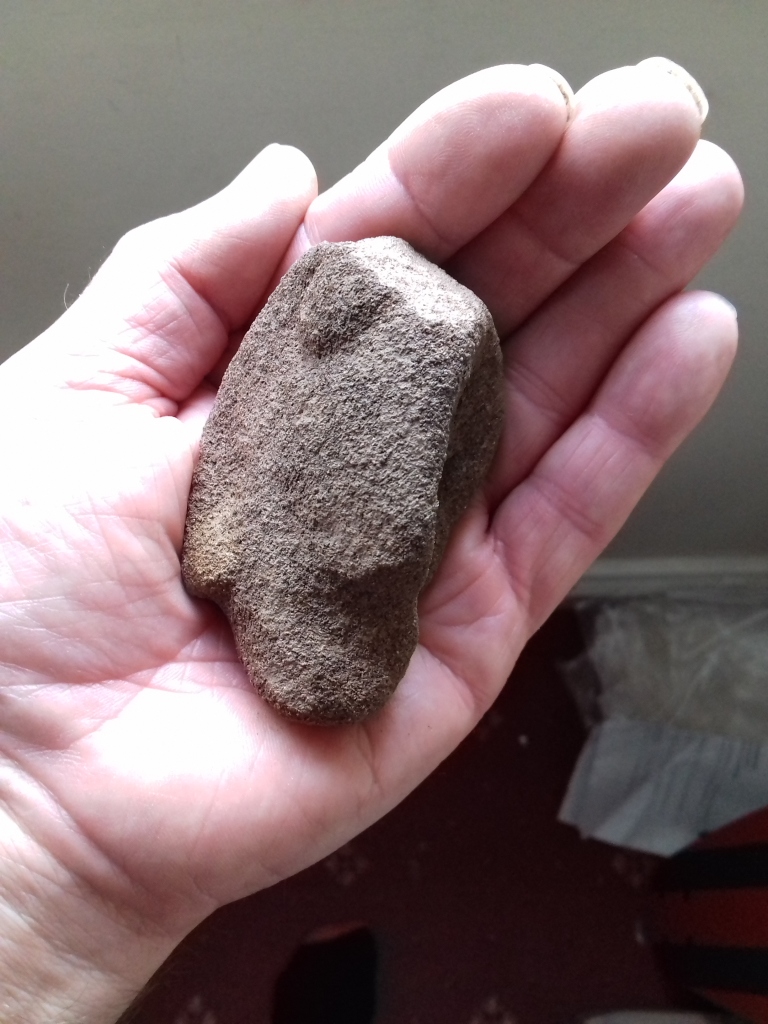
Find Spot Furnace 6. This broken fragment also came from amongst the smithing slag and hearth waste of this smithing hearth. It is the right hand side and fragment of a medium sized head with a relatively fresh break across the eye. however no other part could be found. It also has the remnant of an ear but there is only a vestigial trace of a mouth. However in its complete state it was probably a well depicted example maybe similar to Head 1.

Find Spot Well 1 in pre metal working phase stone backfill. This head is unique to the collection. It is represented in profile on one side only. It has a pecked sun emblem and other pecking marks on the flat surface of the reverse side H.19A below. It bears a similarity to a sphinx figure with a haunch and trace of a tail. It may therefore be an anthropomorphic figure or figurine and not strictly a head. However in the same fill another simple head in double profile H.54, is highly burnished and, although equally unique in its own way, probably indicates these two heads are contemporary. Given their context, well stratified and sealed amongst stone fill, they could be early to middle Iron Age or even possibly late Bronze Age.


Find Spot Base of Hearth Iron Age Furnace 2. This piece may represent an eye and is possibly an example of Professor Miranda Green’s argument for eye healing. It came from the black silt probably dredged from Pool 7 and is associated thereby with Heads 27 and 65. Contextually it satisfies the criteria for coming from a small pool in which people may have bathed their eyes.

Find spot amongst slag fill, late phase Roman ditch outlying Iron Age Bank, this head is eroded and partly broken. Probably re deposited. Lentoid eye, rectangular wedge nose and slits for mouth with furrows across the forehead, possibly with a circular feature at the top of the nose. This head is significantly larger than all the heads and may have been a largish rounded block of stone. The features are not Romano Celtic however. The detail and state of preservation is unfortunately too poor to make much of this head, which may have been a singular artefact of particular significance.

Find Spot Spoil Heap from Retaining Bank Stone Hole 1. As a residual artefact from the spoil heap this object can not be given a context. However it most likely relates to Pool 1 and may best be considered to have come from the bank of the pool at the east end. It is a small crude head with a pronounced/enlarged nose and ‘pinhole’ eyes. Possibly it represents an inflamed or swollen nose condition

Find Spot Retaining Bank Stone Hole 1 Iron Age layer 2 in east bank of Pool 1. This head may indicate where Head 22 came from. It is badly damaged and the eyes are not well defined. The nose ridge appears to have been burnished through rubbing and may again suggest a damaged nose condition. The burnishing suggests that before offering as a votive it was repeatedly held and rubbed in a pocket as an apotropaic object perhaps in an attempt to cure a sore nose. This may suggest offering was a last resort or indeed the culmination of pilgrimage.

Find Spot Retaining Bank Stone Hole 1 Iron Age layer 2 in east bank of Pool 1. The same find spot and context as Head 23. Again this small head has an exaggerated nose. It is very interesting that two and possibly three heads from the same find area differ from other heads by having ill defined but possibly swollen nose features.
Find Spot Stone Hole 6 in backfill of ‘secondary pool’ features this small conglomerate head shaped stone is an uncertain artefact. It is identified as possibly a head due to its find spot. It was found with several quartz pebbles and fragments which may have been deliberately deposited in the western pool feature of the tripartite secondary pool identified by Professor Jones in 1985. The missing small quartz intrusions may have been deliberately removed to represent eye holes.

Find Spot Outer Gulley West End. The find spot and context of this head indicates it was deposited in the Romano Celtic period, late 1st early 2nd century. It is in excellent condition and unabraded. The shaped face mask probably indicates it was designed to originally fit in a niche. The outer rim has been ground to make it smooth. The top of the nose disconnected from the eyes and bulbous nose is not typical of the Iron Age nose style, where the lines are usually taken up to form eyebrows or the top line of the eyes. It is a remarkable face mask which demonstrates the disparity of style in time and space. The shape indicates positioning in a niche as found on the Continent. It may be Early Roman period and could have been placed in the entrance portal or lintel to the original early Roman proto water shrine (see H.31). The stone can be identified as Carboniferous shale from the strata associated with the Forest of Dean coal measures. The colouring cannot be seen in this picture, but it is covered in a shiny black bitumin which oozes out of the stone when cleaned. The deep cut oval eyes may have held glass or quartz inserts.


Find Spot Furnace 1. This extraordinary tiny head came from below the base of a smithing hearth cut into black redeposited silts, which may have been dredged from Pool 7, a small terminal pool at the end of the water channel. The head probably pre dates the Iron Age metal working period. The geology has not yet been determined but it may be chalk. The shape of the small mask plaque was clearly shaped. The straight mouth is covered by a Celtic style moustache and the eyes have evidence for seating rims to take glass insets. The nose is nondescript and ill defined. Recent study (2021) provides evidence from studying statues and figures that the stereotypical Celt from Gaul with long flowing moustaches covering the mouth, as portrayed by Caesar, is not typical and the evidence from Iberia, Gaul and Central Europe suggests moustaches as single facial hair were rare. This head may in fact be neolithic and reflects the practice seen for decorating faces with beards and moustaches during the neolithic period in S.E.Italy and in Israel. Although these dating periods are thousands of years earlier than anything seen in Britain, the plastered skulls in the Lower Galilee were decorated with shells in the eye sockets.

Find Spot Stone Hole 3 Water Channel 1. Identified asa crude head Bronderslev parallel, this small broken head is an example of the Celtic unworked head, where stones were probably selected for their facial similarities and enhanced or exaggerated into crude facial detail. Two heads in Bronderslev, Denmark are cited by the late Dr. Anne Ross for this phenomenon. Such heads may date towards the middle Iron Age e.g. 5th to 4th centuries BC. One large conglomerate head H.16 reused within the Roman foundations has a direct parallel in size and appearance with the Bronderslev example.

Find Spot East Bank Slope Pool 4a. This small head came from near to H.1, it is noteworthy for its shape and simple yet effective design. It has the minimum of sculpting and yet is unequivocally a small stone head. The water worn appearance possibly caused by flowing water is the common comparison between a small group of heads and artefacts from this context. Maybe all the features were more pronounced and deeper cut before erosion took place.
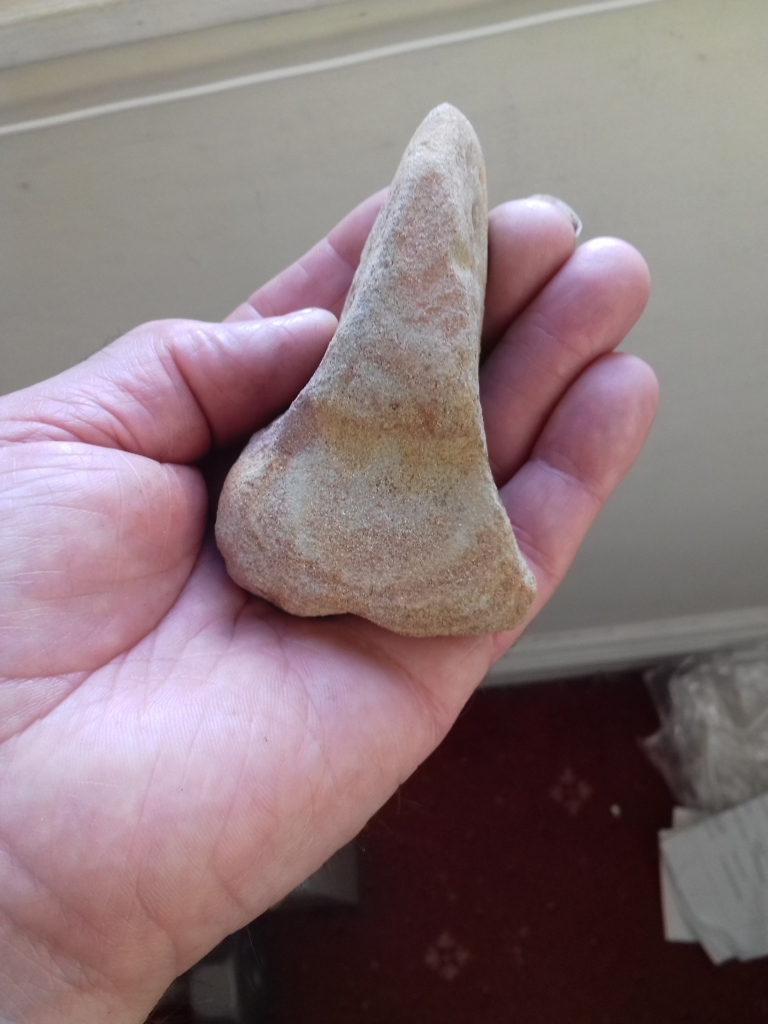
Find Spot adjacent north side of Stone Hole 3 in Water Channel 1 from Bronze Age/Iron Age horizon. This artefact is included as a head because each side profile has a pecked circle for eyes and the frontal ridge appears to represent a nose. There is no remains of a mouth except a straight line across the bottom of the nose. Remarkably the piece of stone has clearly been selected so that when shaped, there was a ring of colour around the neck from the banding of colours within the sandstone. When wet this clearly looked like a torc or neck piece. As a head it is unique as is H.19. They both come from possible Bronze Age deposits. The treatment of the eyes by dotted pecks is unique in the Littledean collection.


Find Spot water Channel 2. This head and the two which follow were buried as a deliberate deposit. The stratification was not defined enough to determine whether they were a burial, contemporary with the feature and context within which they were found, or an intrusive burial cut down through the features above. They appeared to be sealed below the Iron Age metal working surface but that cannot be proved. They were however buried before the levelling and make up for the Roman nymphaeum took place. Their deposition date could be any time since before the Iron Age metal working phase upto the early Roman period. H.31 has similarities of mask/plaque shape with H.26, including the ground and smoothed rim. There the parallels end as H.31 has distinct similarities with cephalic images from Entremont in the lower Rhone valley of France by the Mediterranean coast. The lack of eyes and single line slit for mouth is virtually identical to some of those images dating from around 500 BC http://www.entremont.culture.gouv.fr/en/f_archi_san.htm. Given the condition of this head any early comparisons could be coincidental. For example it has been pointed out that the image may represent a symbolic conflation of the human head with the horseshoe bend of the river Severn. The image appears to have been incised and then the surface has been ground to create an extraordinary polished effect, which shines when it catches the light (the artefact has been cleaned and lightly buffed to enhance its appearance). The three heads were stacked one on the other and laid on edge lengthways with a thin matrix of clay between them. Stylistically H.31 and H.32 could date from the 2nd to 3rd century BC.

Find Spot Water Channel 2. Another extraordinary and striking head. This one is incised into a piece of limestone to create an oval mask on which the head has been sculpted. It may be from a broken frieze with a number of heads all cut into separate ovals which formed part of a lintel.The portrayal of hair is particularly fine. Below the left eye is some form of damage which appears to be caused by an iron nail or spike (see H.33 below). This head is an excellent archetype for the Iron Age Celtic head.

Find Spot Water Channel 2. This head was also incised into limestone to create an oval mask. Traces of fine lines sweeping across the forehead appear to cover parts of the face and may be the result of wind erosion. A nail appears to have been driven into the nose and may have a ritual meaning, as may the similar feature on H.32. The breaks around the oval are consistent with secondary working, whereby the original setting or purpose has been altered. Clearly similar damage or alteration was carried out to H.32. As a group these three Celtic Heads are unique in the Littledean corpus of heads. As a deposit they have no parallel with any of the other heads. They would seem to have been removed from a position of prominence and on view to a position of deliberate burial. This suggests they served a different purpose to all the heads which were placed/deposited/dropped or thrown into water at the Littledean Water shrine. Head 2 and Head 26 may also have been secondary deposits. All five belong to the class of Celtic head masks which were placed on view to be seen in specially designed niches. As such they share a design purpose comparable to the sanctuary of Roquepertuse a few miles from Marseilles and not far from Entremont https://www.megalithic.co.uk/article.php?sid=29514.

Find Spot Water Channel 2 Pool 7. Lying on the silts of the sloping adjacent to the ‘bank’ of Pool 7, a later feature of the Bronze Age/Neolithic Water Channel/Boiling Trough, this head shone white when it was exposed during excavation as it was damp https://littledeanhall.wordpress.com/2019/12/09/chalk-head-no-34/. It is currently identified as a head sculpted into chalk. It is noteworthy for the single baleful eye. There is however sufficient trace of the other eye to indicate it was portrayed as tiny and it appears that the stone is not broken, but deliberately selected. The symbolism inherent in this artefact may stretch academic thought for years. The well formed and explicit mouth expresses a powerful sentiment of hurt and sadness.
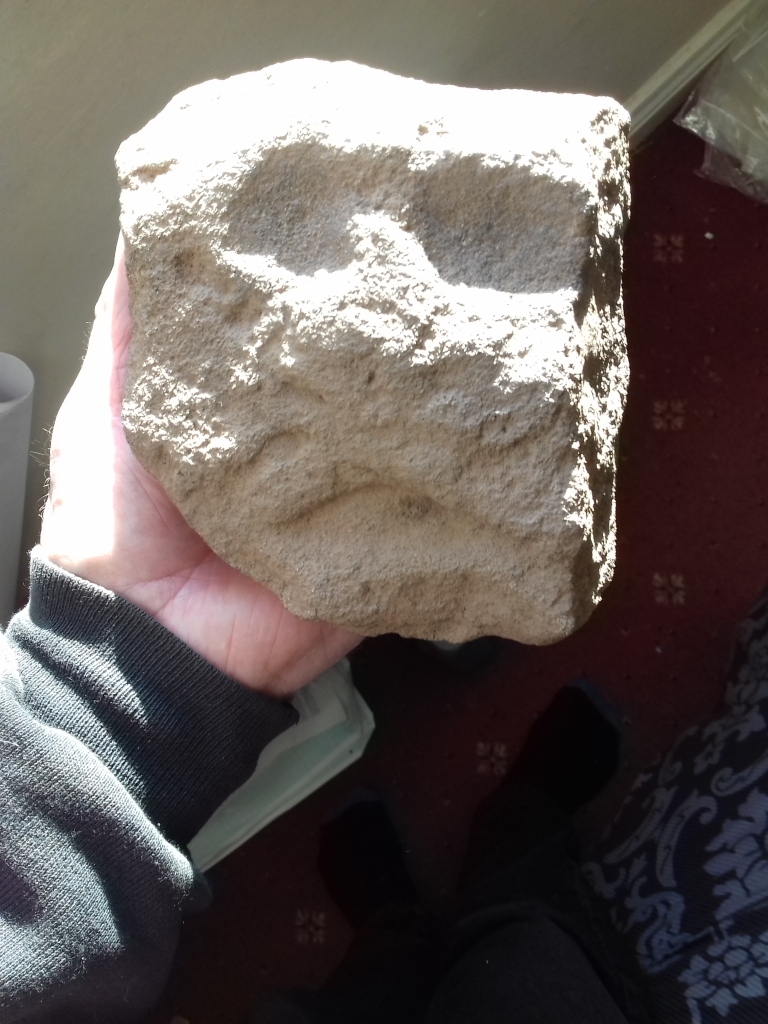
Find Spot Water Channel 2 Pool 7. Lying at base of backfill stone rubble fill to east side of H.34 this large head with prominent sunken orbs for eyes does not have the typical Celtic nose in any manner or form. The mouth is worked into a natural scar in the stone and numerous lines above it ( not showing in this picture may represent a moustache. The brow is prominent. This head is not atypical of the Littledean heads in general.

Find Spot Water Channel 2 Pool 7. In silts near bottom of pool feature adjacent south ‘bank’ this head has only one ‘baleful’ eye. The opposing side of the face at the stone’s edge is worn consistent with the shaping of the head. It is more a mask than a head. The mouth is very similar in its execution to that of H.34. Although the nose has eroded away it has some similarity also with H.34. Given these two heads are from the same general context, deposited in the small terminal pool at the end of the water channel from the primary Pool 1, Professor Miranda Green’s opinion that the spring fed waters probably held special curative properties for eye ailments, is particularly apposite with these two heads.

Find Spot deposit below base of IA furnace Fe6. This is one of nine heads in a single deposit below the base of Iron Age Furnace 6 on the north side of the primary spring head pool. They were deposited in a backfilled circular pit which possibly held a post or tree trunk for an anvil base. Secondary use involved removal of this post and backfilling with soil and sand which was capped with the deposit of stone heads and broken stone. There was no obvious trace of metal working slag amongst the deposit. The deposit was sealed below dark earth, clay and stone forming the base for a smithing hearth. The slag prills from this feature and the evidence for a furnace indicate this was a slag pit shaft furnace of the Iron Age period. H.37 is peculiar in that it has a recessed crown to the head with significant traces of red ochre staining, which does not appear on the face or head elsewhere.
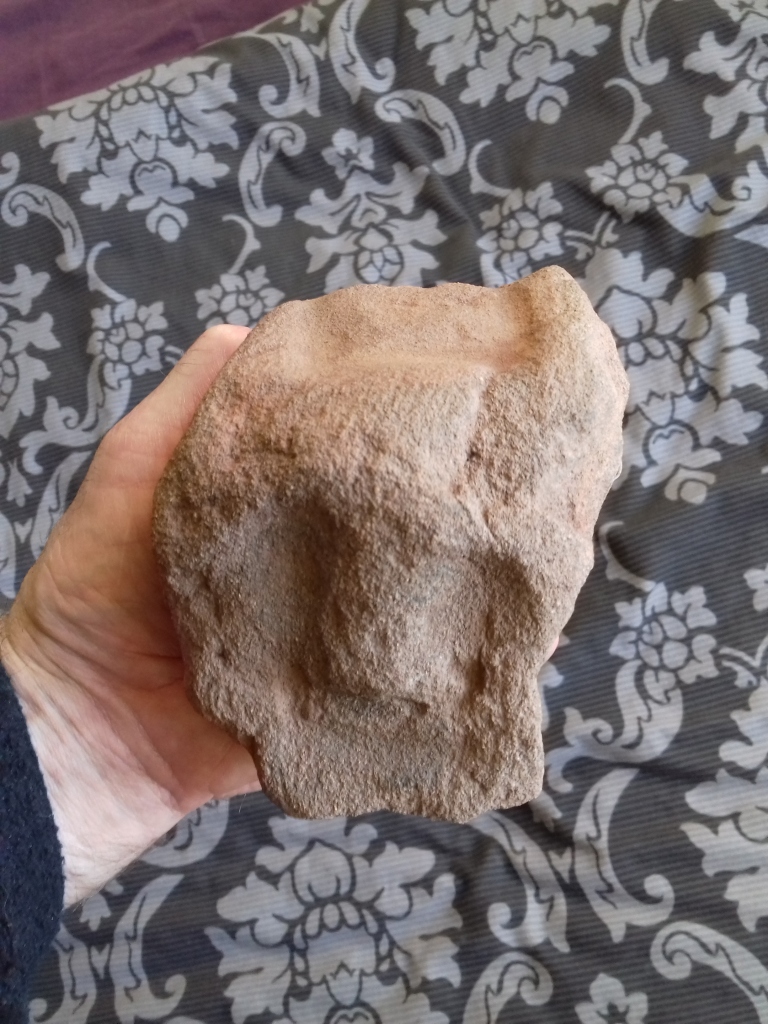

Find Spot deposit below base of IA furnace Fe6. This head from the deposit has particularly well defined eyes and eyebrows with a well shaped nose. The mouth has probably broken away.
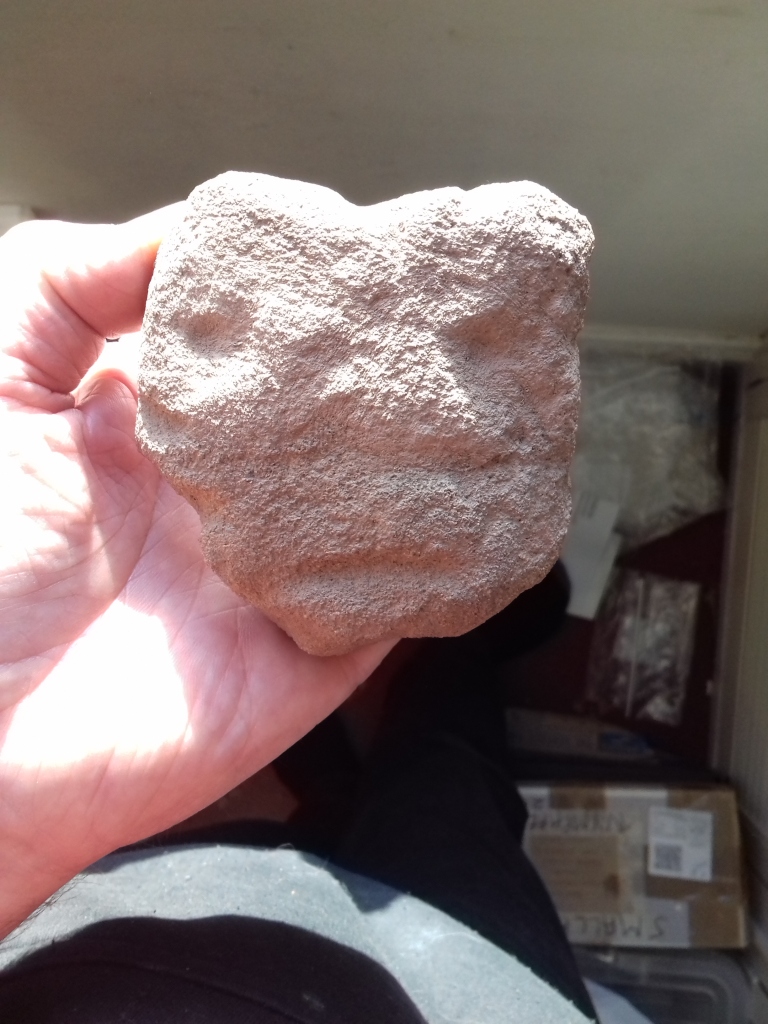
Find Spot deposit below base of IA furnace Fe6. There is a divergence with this head from the typical Celtic head represented by the Littledean examples, which has a possible relevance for Head 35. The indented forehead may be the result of damage and erosion or it may be deliberate, in which case it gives a rather cat like appearance to the whole face. On the reverse side are deep gouges or simulated scratch marks. This may be of particular significance in that a number of antefixa from Caerleon have ‘cat heads’. Ross comments fully on this particular phenomenon which she suggests may be unique to the Silures (Ross 1967). It is tempting to equate this image and the possible representative scratch marks on the rear with Cath Palug the giant water inhabiting demon ‘scratching’ cat which Ross refers to in the Caerleon contexts and which figures large in French Arthurian Romance.

Find Spot deposit below base of IA furnace Fe6. This small double sided head has simple and crude imagery childlike in execution.
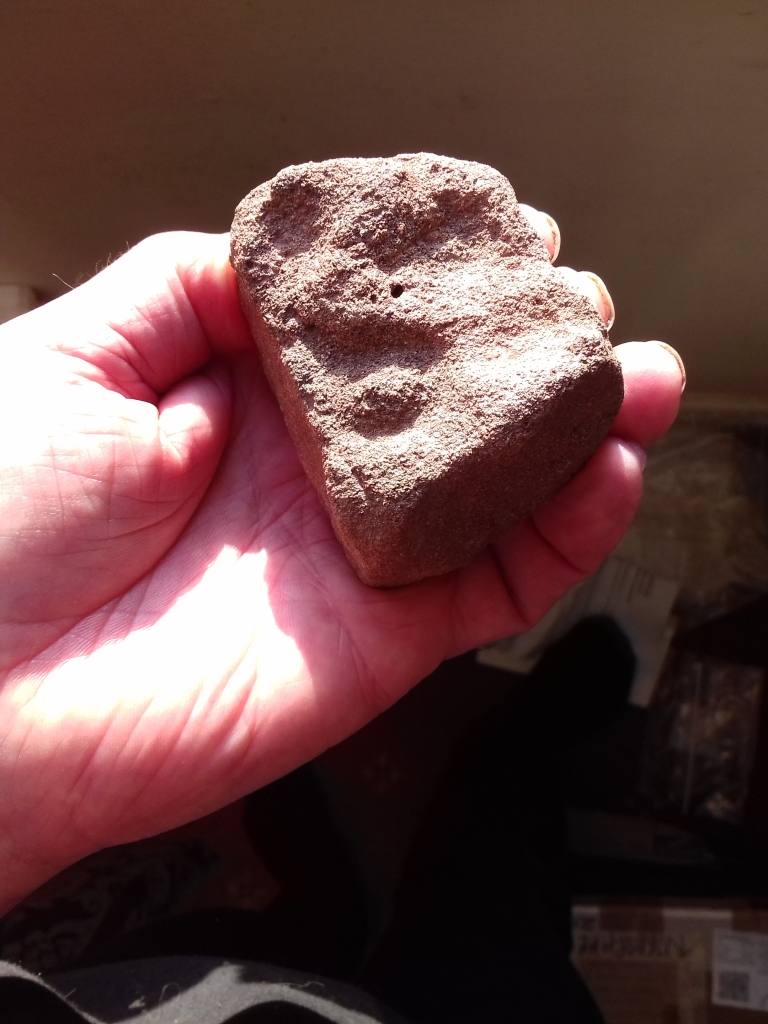
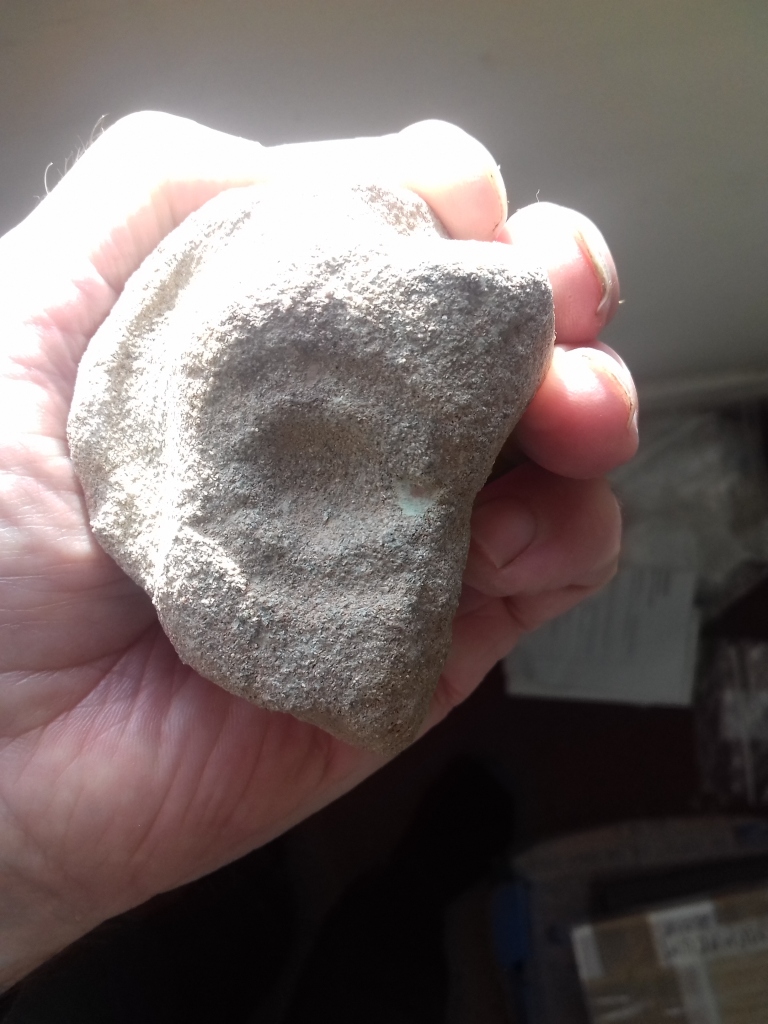
Find Spot deposit below base of IA furnace Fe6. An example of a single eye which may be as it was made or a broken abraded fragment. It is probably the former which is relevant as one must ask where is the rest of the head amongst the deposit. It is clear this object was placed with the other heads and is per se meant to represent an eye only. The rim of an ear may be an outer framing feature of the sculpted eye.

Find Spot deposit below base of IA furnace Fe6. A particularly significant head because it is clearly not human and does have the symbolic neck ‘hackles’ of a boar and tusk features. The boar was a highly held sacred animal of the Celts, as described and referenced at length by Anne Ross in Pagan Celtic Britain 1967. There is much imagery in stone and bronze throughout the Celtic world. Two possible representations of little stone boars at Littledean give credence to the possibility that other heads do represent mythical animals, of which many feature in Irish and Welsh literature.

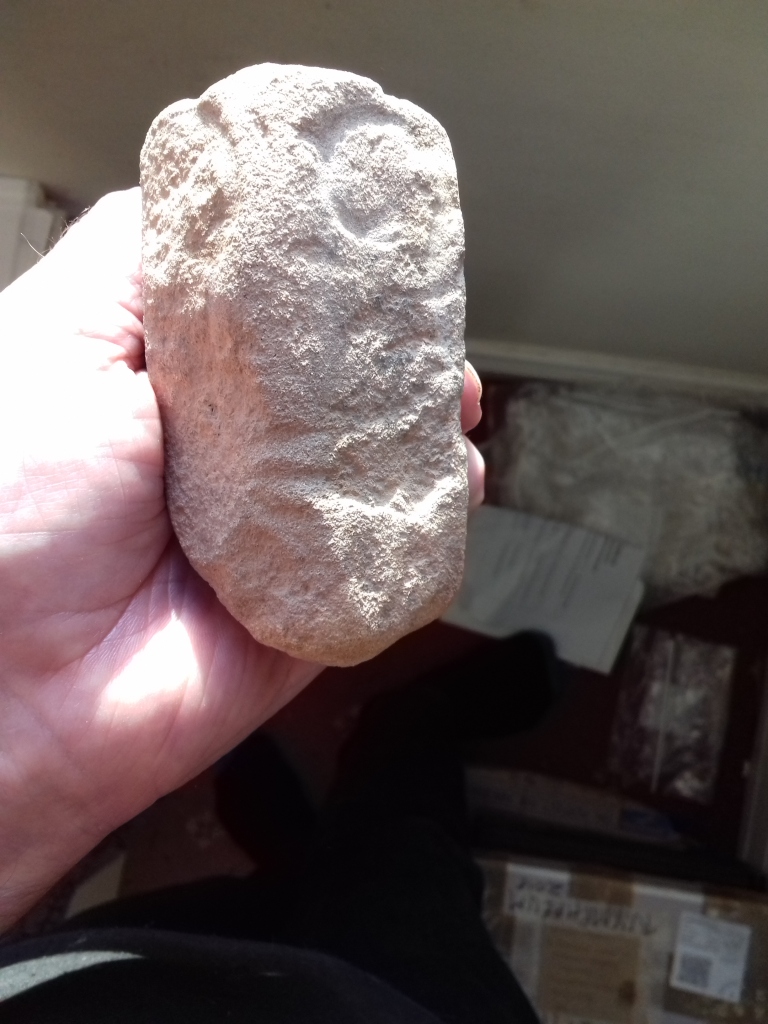
Find Spot deposit below base of IA furnace Fe6. This head is very eroded and the yellow brown sandstone is soft and no doubt easily broken down in water. The Old Red Sandstone heads are generally very well preserved, whilst more grainy recent sandstones show clear evidence for diminished features from erosion over the millenia and others indicate that some softer sandstones have probably completely broken down and destroyed over time. The circular eyes of this head are seen in several other examples e.g. H.51 and are distinctly different from the typical ‘lentoid’ shaped eye commonly portrayed in later Iron Age heads.

Water Channel 2 mid section below WC1. Dubbed ‘eagle’ head by the excavators it is a small head in double sided profile with circular eye and curving nose and no mouth, going into a narrow neck, hence the curving beak of an eagle.

Water Channel 2 mid section below WC1. One of three crude and simple stone heads with evidence of water erosion, all with basic but effective facial features and all from pre metal working fill in the water channel associated with Bronze Age stone carved material https://wordpress.com/block-editor/page/littledeanhall.wordpress.com/585. These heads were single deposits and as well as association with Bronze Age artefacts were near to sherds of Iron Age and Deverel Rimbury Middle/Late Bronze Age pot sherds. This evidence provides the earliest dating for any Littledean heads and may place these particular heads in an Early Iron Age context. Movement downwards in the silty soil from this water context cannot be ruled out however. Yet despite this it is reasonable to consider a date in theearlier centuries of the Iron Age for these heads. They may be the earliest stone head artefacts which can currently be identified in Britain.

Water Channel 2 mid section below WC1. Water eroded early Iron Age stone head. See previous entry H.47

Water Channel 2 mid section below WC1. Early Iron Age stone head. See previous entry H.47

Water Channel 2 mid section below WC1. Possibly another symbolic boar’s head closely associated with sherd of Iron Age pottery.

Water Channel 2 mid section below WC1. This head came from a similar context to Heads 47 – 49 and is important as it has the round eyes which may have had inserts of glass although the seatings are very eroded and no glass has been found for these fairly large inserts. Upward movement of glass in the soil is commonplace however, in the same way as it is with flint and much of the Littledean flint came from the topsoil (this is typical of flint movement in the Stonehenge landscape Parker Pearson), as did the glass fragments. The mouth line is notably simple and an early date for this artefact seems tenable.

Water Channel 2 mid section below WC1. Another crudely minimalist eroded face and head from the same contexts as Heads 47 – 49 underscores the seven heads from the middle section of Water Channel 2 and the Bronze Age silts, of which four may have been deposited in the Iron Age during or before the emerging Hallstatt culture in Britain prior to the 6th century BC

Find Spot Deposit below base of IA furnace Fe6. An interesting head which Professor Miranda Green identifies as having a growth on the right cheek. The downturned mouth compares with other heads with single/damaged eyes e.g. H.34. The sandstone is very grainy which is typical with some heads from wet or damp contexts where erosion of the surface has taken place.

Find Spot Well 1 in pre metal working phase stone backfill. In the stone fill of the well near Head 19 ‘sphinx’ head. Both heads were sealed amongst the stone fill with no iron slag contamination. This simple profile head is highly burnished and clearly dissimilar to all the diagnostic Celtic Iron Age heads from Littledean.

Find Spot Well 1 in pre metal working phase stone backfill. It currently seems impossible to propose an attribute or identity for this head. The eyes are set in the sides and the nose and head are executed in one continuous curve or sweep, most suggestive of a bird or falcon.
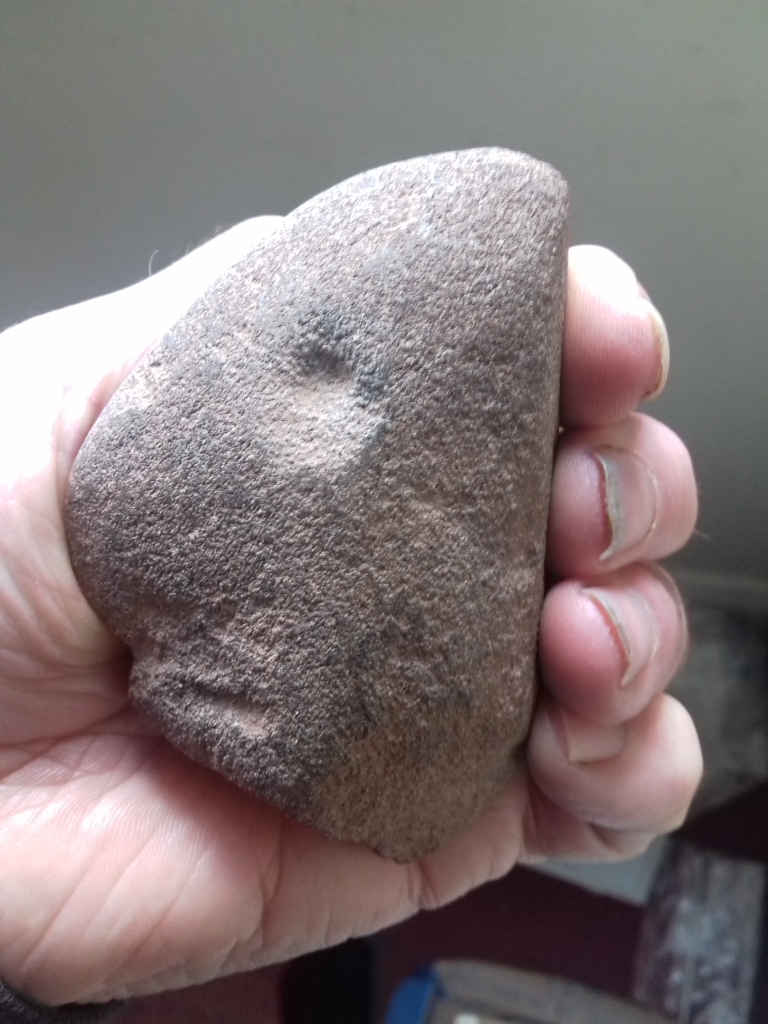

Find Spot Water Feed to Pool 1 this object has a worn and abraded waist. Two faces are inscribed one overlying the other. It may be a figurine from a far earlier period

Find Spot Residual in mole hill by hedge south side south wall. This head has a similar texture to Head 53. Whilst lacking the detail due to erosion there is a suggestion that the eyes were treated differently to each other. The find spot was some 20 metres to the east of the Celtic nucleus of the Water Sanctuary.

Find Spot Spoil heap Stone Hole 1 IA level 5b. This head was not found in situ and was missed as an artefact and only revealed on cleaning and washing away the impacted clay. It was collected from the spoil heap relating to the layer of the Iron Age path approaching the entrance to the Water Shrine of the early Romano British period. It is possibly a very important piece for several reasons. Firstly its size. It must have been an oval of around 20 x 30 centimetres, which would make it the largest head plaque or mask from the site. Secondly the depiction of hair is consistent with female gender. Thirdly the pupil is drilled and has very slight trace of a threaded seating suggesting a mount was screwed in, which no doubt would have had a coloured glass inset. It is possible therefore this was a face mask of a water deity mounted over the entrance portal of the water shrine. Evidence indicates there may have been a square posted portal at the east end, with an orientation towards the equinox sunrise. A typical treatment (Entremont, France) would be to have a wooden lintel and at the centre of this could have been fixed this stone plaque as an image of the goddess. Given the associations of equinox and Severn bore and orientation to the horseshoe bend it makes for a compelling argument that this was the face of Sabrina. It is therefore such a great shame that we do not have the other pieces.
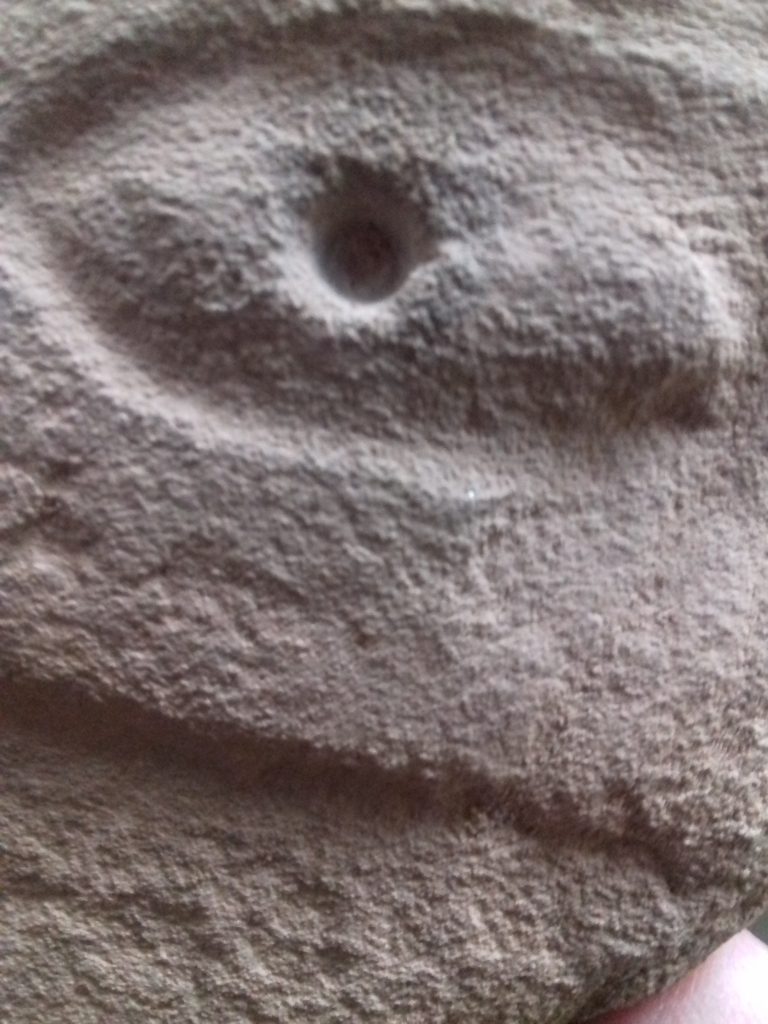

Find Spot Stone Hole 2 Soil/stone sample cleaned 05/10/19. Another remarkable red ochre head carved into a piece of red ochre stone and deposited with several large pieces of whetstone or sharpening hones in the fill of Stone Hole 2. SH2 is an important pit which may have held a standing stone roughly 1.5m (5ft) high over which the winter solstice sun rises when viewed from an alignment through the centre of Pools 2a and 2b, which may originally therefore held standing stones. The face has the iconic expression of downturned mouth and expressionless lentoid eyes and, in this case, slightly triangular wedge shaped nose. The forehead was clearly decorated with a crown of hair.

Find Spot Water Channel 2 Pool 7. Another anomalous head from the small terminal pool where Heads 34 to 36 came from. This head has well executed sunken pupils surrounded by rims and outer incised oval frames drawn out at the corners. The nose is drawn down to a central beak like rib and in place of a mouth is an upper and lower chevron pattern.

Find Spot Water Channel 2 mid section. A small crude head with pin hole eyes, pointed nose and single line upturned mouth creating a happy looking face. Perhaps an offering from a ‘satisfied customer’!

Find Spot Springhead pool south bank rim Pool 1. Small tablet with one eye and trace of a single eye. The bottom face feature might be either a nose or mouth. Very soft piece of stone heavily water eroded.

Find Spot Water Channel 2 mid section below WC1. This small piece came from an early to mid Iron Age context and appears to represent only a nose and mouth and is possibly broken from a larger piece. It may however been made to only represent these facial features and as such is typically votive.

Find Spot Pool 5 Amongst other small heads finds including Heads 3 and 4. It is an example of the anthropomorphic type heads on pebbles referred to by Anne Ross in Pagan Celtic Britain 1967, although in this instance and the one below there is no carving. The eyes and nose are fairly obvious and a frontal swelling below adds to the symbolic head shape. Dating is by association with the Iron Age Celtic type Head 4. However Neolithic objects with this tiny pool, no more than a metre in diameter, can’t rule out this head being Neolithic.
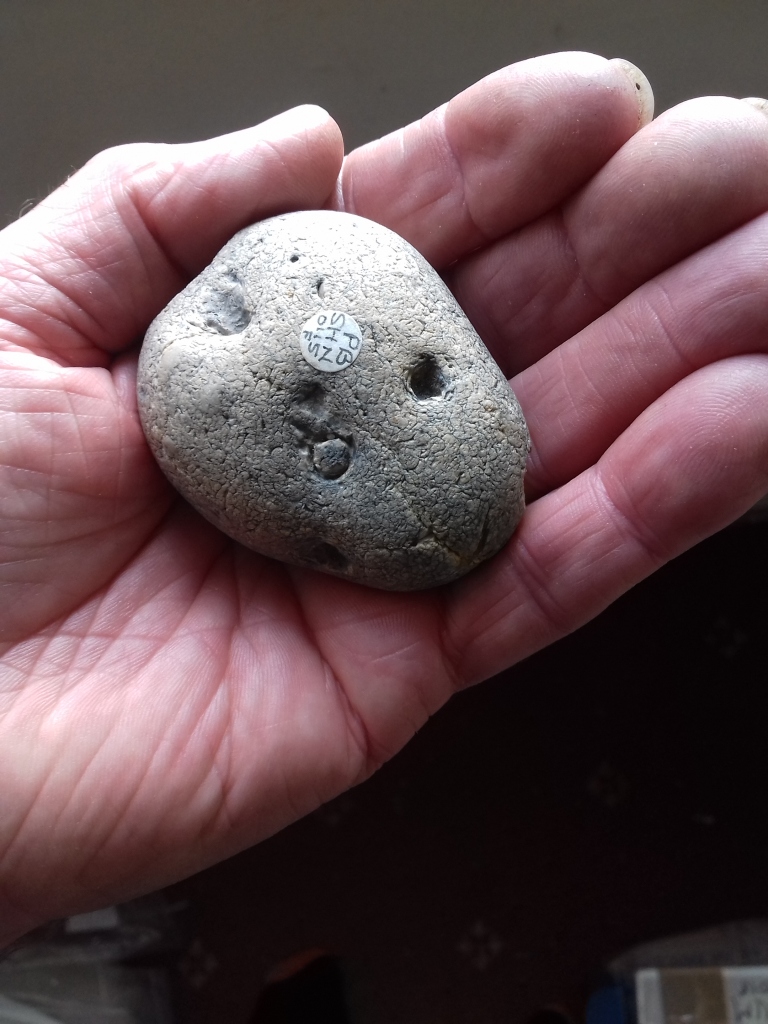
Find Spot Springhead Pool 1. One of the many flint pebbles found in the Springhead pool and on its north bank during the excavations of 1985. This is the only one with natural features forming a face.

Find Spot Pool 6 in edging stone. This remarkable head only becomes obvious when studied. It is small, worn and in places shiny. There can be little doubt that it is atropopaic and carried around as a talisman before it was finally deposited as an offering. It was found below the silts dredged from Pool 7 filling the water ‘basin’ or feed to Well 1. The silt was spread covering these earlier water features and eventually became a working area for smithing hearths. This head and Head 27 were therefore buried below the metal working layers. Close study of the one side shows a well formed eye and a badly formed eye, a short stubby nose and an open mouth. The incisions in places carry very fine lines which can be seen on the reverse side also, demonstrating the piece was executed at one point in time. That is not to say there wasn’t an earlier image on the reverse which was subsequently re worked.
The reverse side appears on first impressions to have a single eye. It may originally have been a face on the rear with one smaller eye, nose and slit for a mouth. This is not convincing however. With the aid of a magnifying glass it becomes clear that the oval shaped eye has rays coming of it. Running from top to bottom to the left of the eye is a ladder feature divided int three ‘fields. This can be interpreted in several ways. An eye with rays has no immediate parallel. Thus it may be more likely it is a sun image and the rays are falling onto depiction of fields. This may symbolise the sun’s fertilising powers. As an artefact it is possibly unique and like many of the Littledean heads will require much research and argument to reach a considered and acceptable interpretation.


Find Spot Pool 6 in edging stone. From near to Head 65 this small object is very worn and was in delicate condition. However enough survived to warrant a light cleaning with a fine artist’s paint brush. On drying the features of a face became clearer. It is a salutary example, where original eye, nose and mouth detail has been almost lost and as such it acts as an exemplar for demonstrating how many heads have undoubtedly been lost, from decay and encrustation, in wet or damp seasonal conditions.
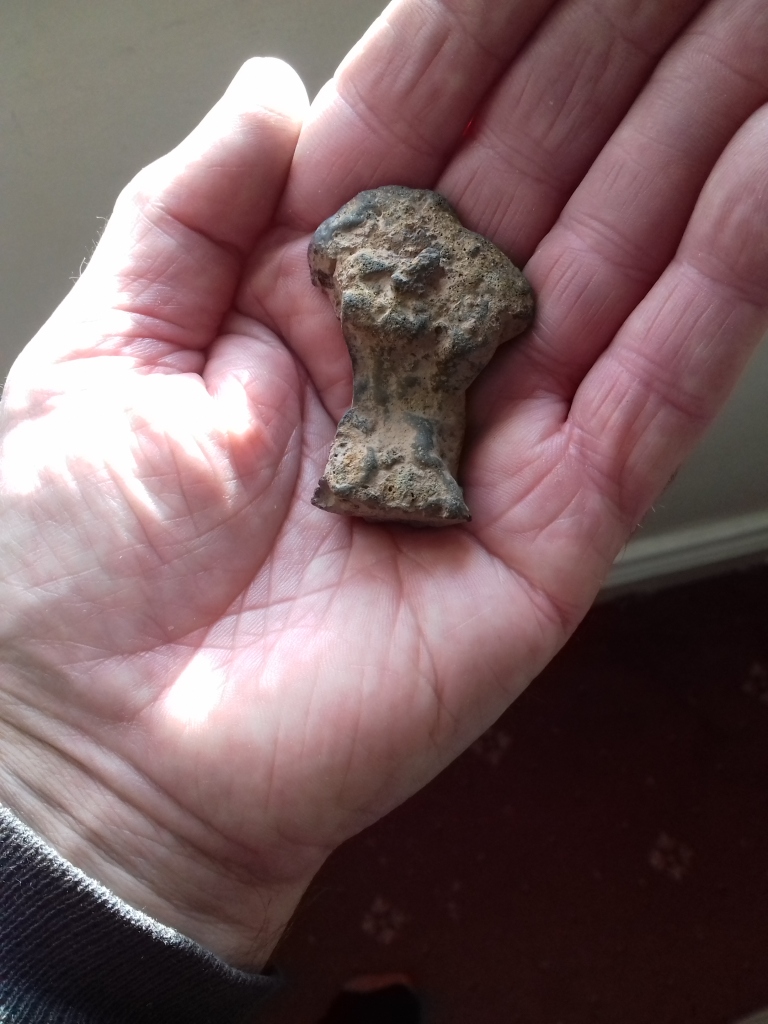
Find Spot Stone Hole 3 west side. This example of a possible ‘phallic’ head refers to a class of heads found in Celtic Europe fashioned into menhirs, particularly with La Tene decoration (Ross 1967 et al.). It is a slag run from an iron furnace and has solidified in an unusual way, giving a similarity to a neck and a head. Along with other items of slag which have solidified to give impression of heads these are included in the Littledean corpus of Heads due to their find spots and contexts. The excavators consider these are not items of slag waste/rubbish but have been selected for their human shaped attribute. For a metal smith they provided the means whereby he could make regular offerings relating to the quality of his work and to seek help from the metal smithing god Gofannon in his perfection of skills. It is a concept which we are pursuing at the Littledean site and which has support from Bryn Walters B.A. The association for Roman Archaeology.
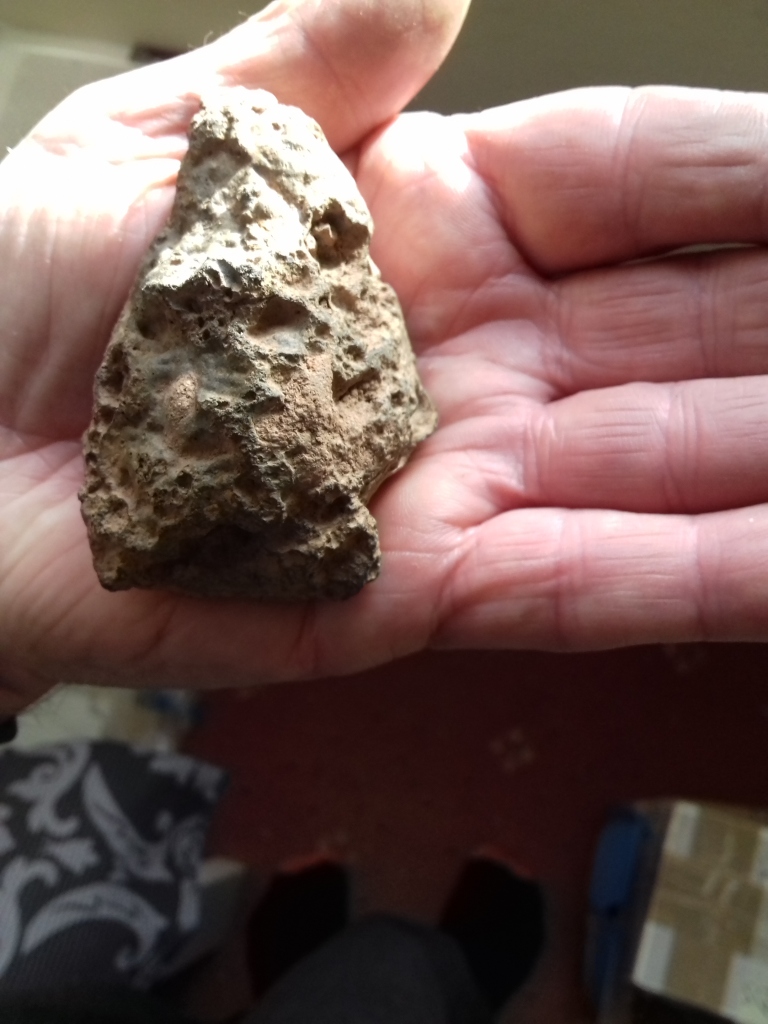
Find Spot Pool 7 south end lowest silt. Possible iron slag votive head securely sealed in lower pool silts.
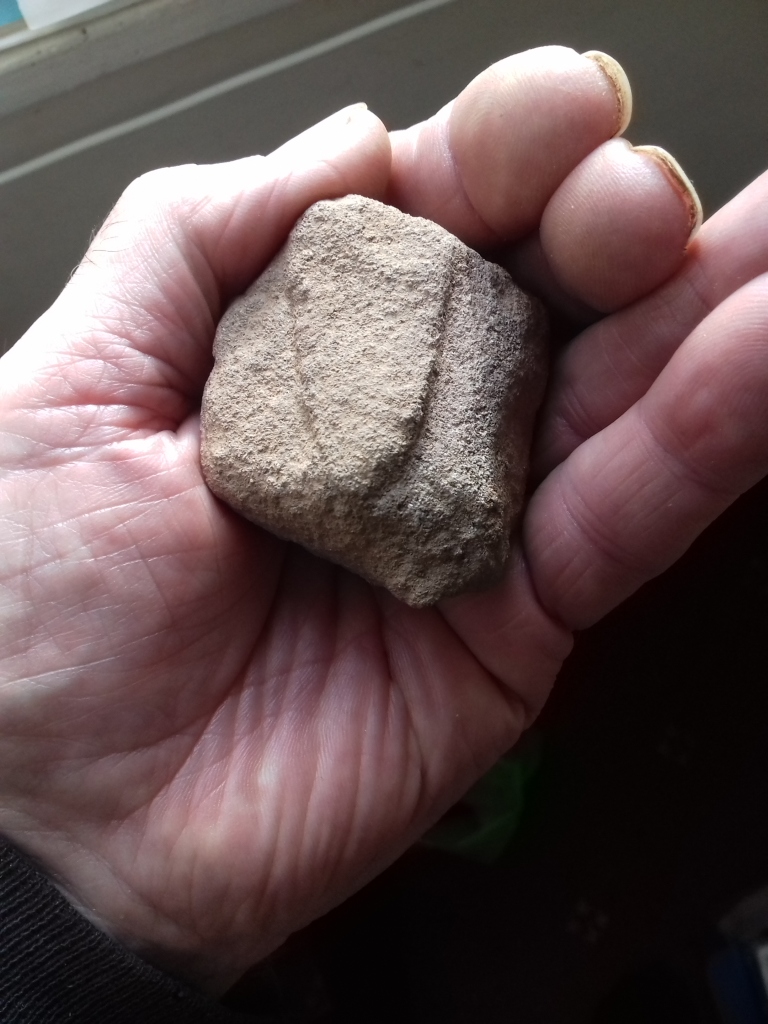
Find Spot Pool 7 South End. A fragment or possibly essentially complete example of votive offering relating to a nose ailment. Similar concept to Head 62.
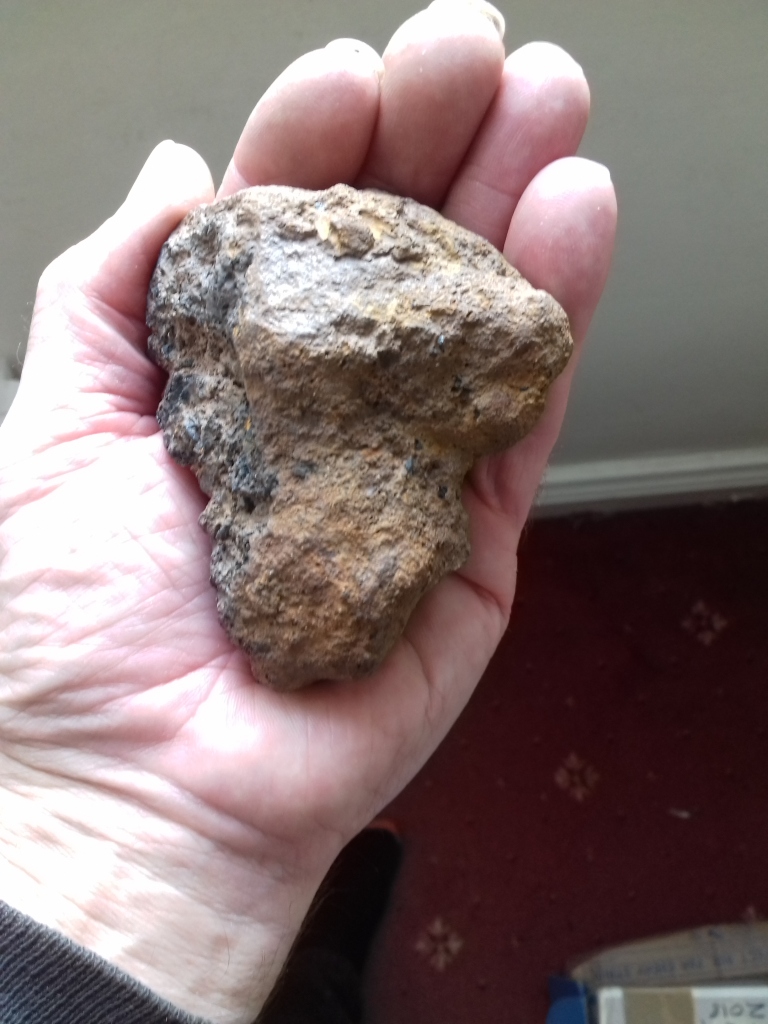
Find Spot Stone Hole 3 west side.Possible iron slag votive head securely sealed in lower pool silts

Find Spot Pool 4a East Bank Slope. Another typical Littledean small water worn votive head
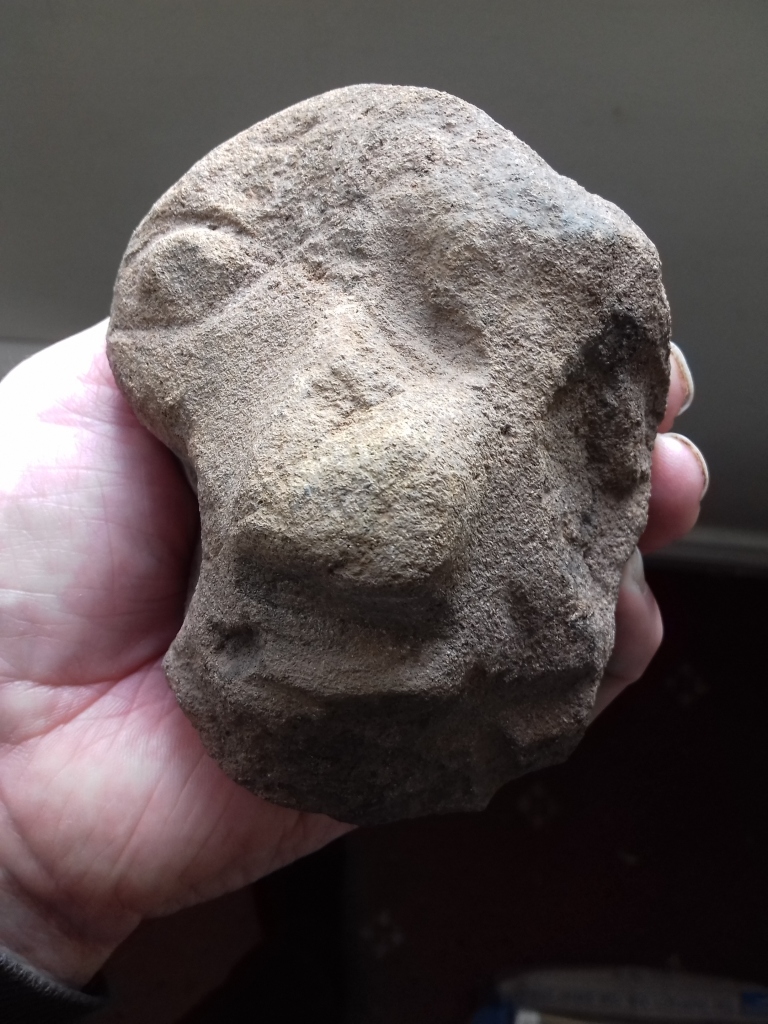
Find Spot Pool 7. This head possibly redeposited is a graphic example of Professor Miranda Aldhouse-Green’s observation that the Littledean Stone Heads are “All about Eyes”. The head is cut into an easily worked brown sandstone. With the caveat we may be looking at damage, the one eye survives in excellent condition whilst the other appears to be lost. Perhaps it is carved to represent healing. The nose actually looks twisted and the cheek bone appears smashed towards the ear. The mouth also looks like it has been damaged. We can imagine a scenario for this head. Does this head represent medical history? The dome of the head seems fine but the face above the bridge of the nose and the missing eye may tell us of a massive trauma event in battle, which failed to kill the individual. Are the lines running from the good eye scars? This head is important as an example of an hither to unexplored aspect of Celtic beliefs and practice.
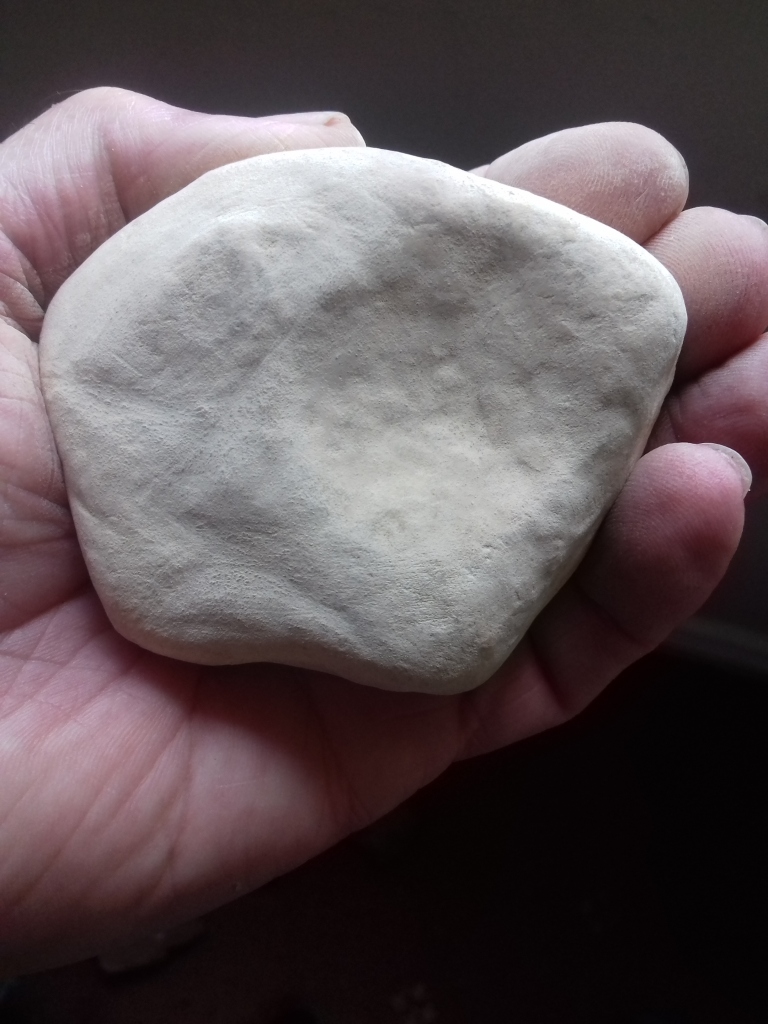
This small block of gypsum came from the fill of a water conduit associated with the west bank of Pool 5. Although heavily eroded and indistinct there appears to be the right side of a facial image with downturned mouth and wedge shaped nose and the remnant swelling of an eye. The left side is missing, which may be deliberate or eroded. If the material is gypsum (verification required) it would have been highly susceptible to water. However given part of the image remains it seems unlikely the whole left side would have disappeared in an undisturbed context.

This block of gypsum came from the fill of a water conduit associated with the west bank of Pool 5 and next to H.73. These are the only two finds of this material from the site. The indistinct and highly eroded facial features are illustrated in sketch outline 74A. The eroded hollow at the base is identified as a mouth and curving lines above as a moustache. The basic wedge shape for a nose carried up over the eyes is typically Celtic. The eyes are too ill defined to determine their original shape with certainty although they appear to be oval rather than lentoid. Contour modelling may confirm with more certainty whether this is a head or not. It is included because of context and association with other heads from Pool 5 and the rarity of the material.


Find Spot Deposit 2 below base of IA furnace Fe6. This fragment may represent an eye. As a single random find it would have little significance. However as one of eleven further heads and fragments from from the silt deposits below the principal deposit below the base of IA furnace Fe6, this example and others from the same context are treated as worked parts of heads.

Find Spot Deposit 2 below base of IA furnace Fe6. This head is another object which would probably be dismissed were it not for context and association with other heads as well as the shape and stone colourations. The eye orbs appear to have been ground out.

Find Spot Deposit 2 below base of IA furnace Fe6. Another uncertain object identified as a facial part as in a nose, based on context. The piece appears to be a nose with nostrils. The lines scratched across appear to be relevant.

Find Spot Deposit 2 below base of IA furnace Fe6. Another head fragment representing an eye with radiating lines.

Find Spot Deposit 2 below base of IA furnace Fe6. Although this is a crude head it has a defined ridge for a nose underscored with a distinct mouth and pinhole eyes, the right one of which has several evidences for a rimmed outer circle which is totally missing in the left eye. This suggests special attention was being placed on this eye and provides further support for the theory that it is the eyes which have the most emphasis in the Littledean corpus of stone heads.

Find Spot Deposit below base of IA furnace Fe6. This head has some similarity with H.3 a small face mask from Pool 5 which lies c. 36m to the west of Pool 1. Whereas the nose etching of this head is faint the mouth appears to have been large with left hand side broken away. The mouth of H.3 is also large.

Find Spot Deposit below base of IA furnace Fe6. This tiny face mask has no impression of a mouth. Although there is some damage around the right eye, the linear incision marking the right side of the nose may be accentuated from the pinhole eye. It possibly represents a tear line as with H.84. as pinhole eyes do not have the nose feature carrying up to form the eyebrow.

Find Spot Deposit 2 below base of IA furnace Fe6. A crude and simple head very similar to heads 48 and 49 from Water Channel 2.
Find Spot Deposit 2 below base of IA furnace Fe6. this head is split down the middle and the left side has not been recovered, possibly because it was fragmented. The rarity of broken heads suggests this breakage was accidental and may be consistent with re depositing from elsewhere and damage in the process. This is unfortunate as it could have been stylistically very important and unique to the Littledean head corpus. it is exceptionally and uniquely long and narrow having a marked similarity to several of the wooden heads from Le temple de la Foret d’Halatte, Oise in France.
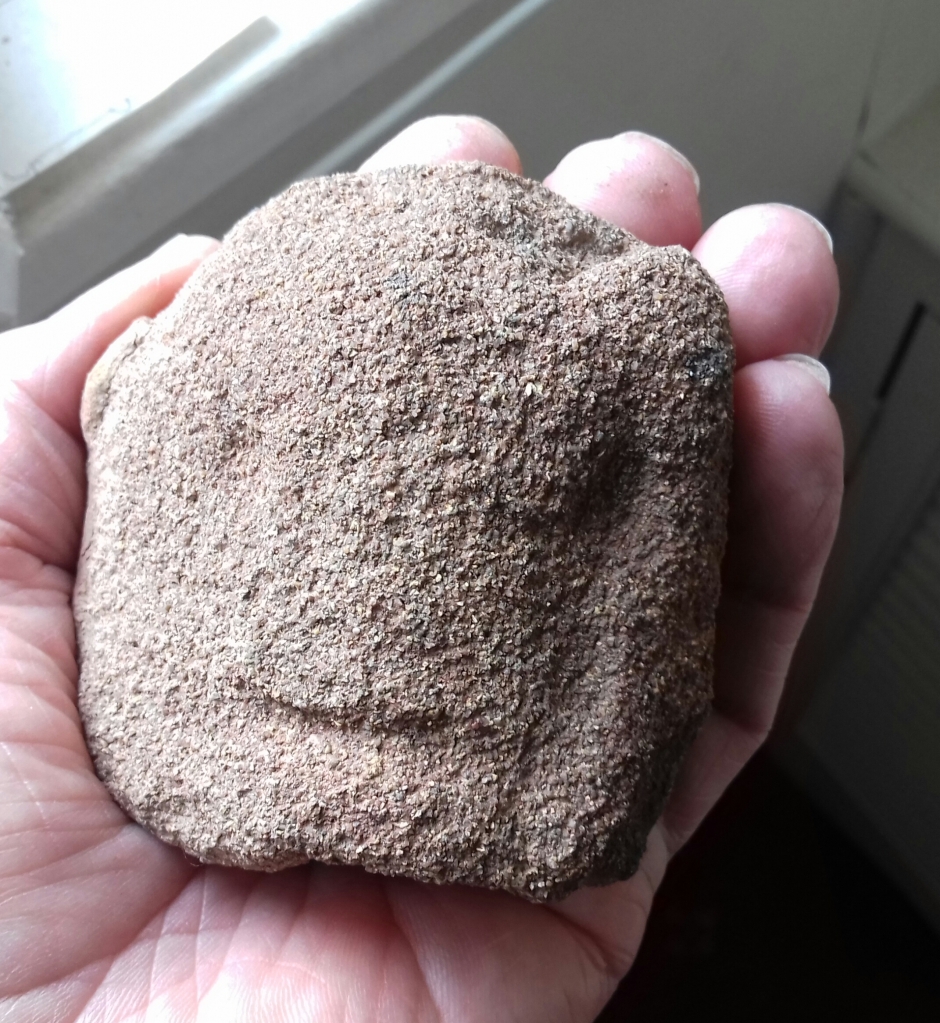
Find Spot Deposit 2 below base of IA furnace Fe6. Another extraordinary crude and simple, but effective head in a very gritty sandstone. The channel from the left eye seems to be original and creates a compelling appearance of sorrow od distress/pain.

Find Spot Deposit 2 below base of IA furnace Fe6. The fourth crude head from this context except the eyes have been given more detail and looks like both had raised pupils, the left significantly smaller than the right.

Find Spot Deposit 2 below base of IA furnace Fe6. Whereas the other examples of eyes from this context are debatable were it not for context, this example is more convincingly an eye. The outer incised rim and sunken pupil appears to be a more basic form to the beautifully developed eyes of Head 59.

Find Spot in fill of boulder lined pool (Pool 8) incorporated into the west end of the north wall of Roman temple. This large quartz veined block, of as yet unrecognised geology, is scored with many incisions and pecking marks. It has a worked domed head and appears to have been ‘dressed’ to enhance an head like shape. The left eye which shows as a shadow has a faint circular rim at top and bottom of the eye. it is noteworthy that with the ‘face’ turned to the sun it becomes invisible and only when turned away, so that shadow falls over the features, does it become visible. The find of this head in April 2020 and particularly H.88 which follows adds credulity to the identification of H.16 as the ‘Bronderslev’ type. The group all came from within a metre proximity to each other. Of all the corpus of Littledean stone heads they may be pivotal to the origins of the Celtic stone head in Britain. Their crudity and simplicity evades current understanding and places this group of artefacts in a profound position. At the best we can only expect to interpret them through informed judgements based to a large degree on myth and the early descriptives of Welsh and Irish literature.
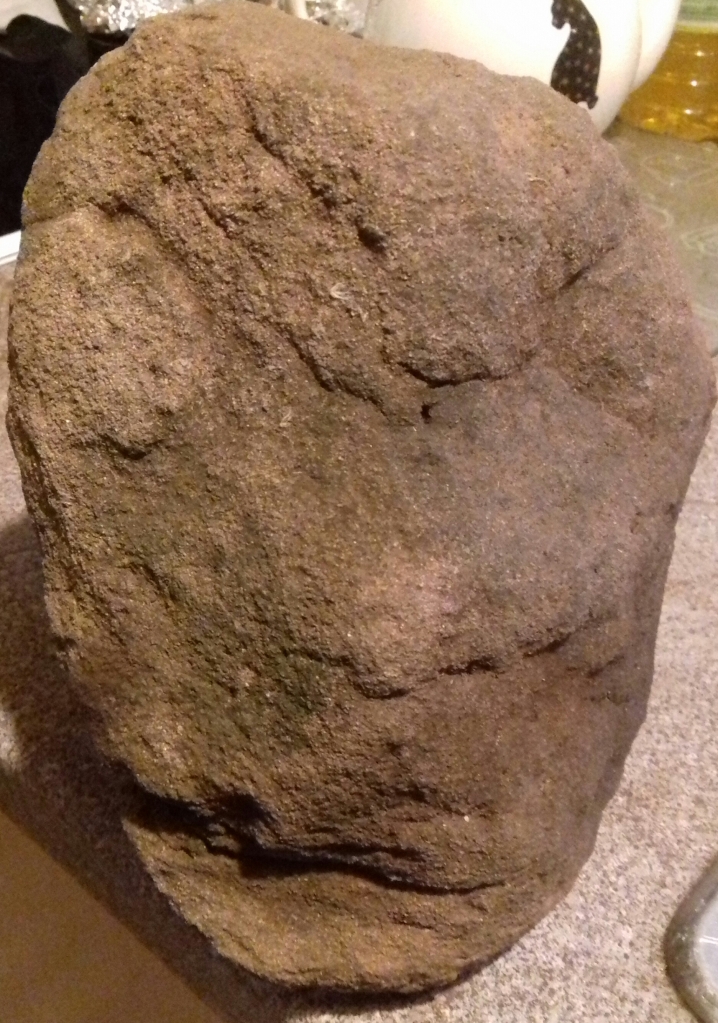
Find spot face down in Roman foundation between the drain outfall and pool (Pool 8) described under H.87. This coarse grained sandstone head with pronounced natural crease for a mouth, has slight traces of secondary retouching to better emphasise both left and right eyes, which appear to be features natural to the stone. The forehead is pronounced and the dome of the head has been ground to shape. How much natural erosion has taken place accentuating cracks and grooves over the millennia is impossible to say. The base is ground as is part of the back, which in the latter case is unusual. A significant ground out shallow hole in the back seems significant. It is noteworthy that the base is ground so that the face is looking towards the sky when stood up. The hole in the rear may be to take a supporting stick to steady the head in this position. It is the only head from Littledean which inclines to the sky when stood. This is suggestive of belief in the Supreme Being and the gaze into the infinity of the night sky. As a primitive head it transcends the Bronderslev type in that it has evidence of lentoid eyes and an inherent head shape, factors both missing from the minimalism of the Bronderslev type. Heads 16, 87 and 88 may at this point in time be a set of three heads, representing triplism so often quoted by the academic authorities.
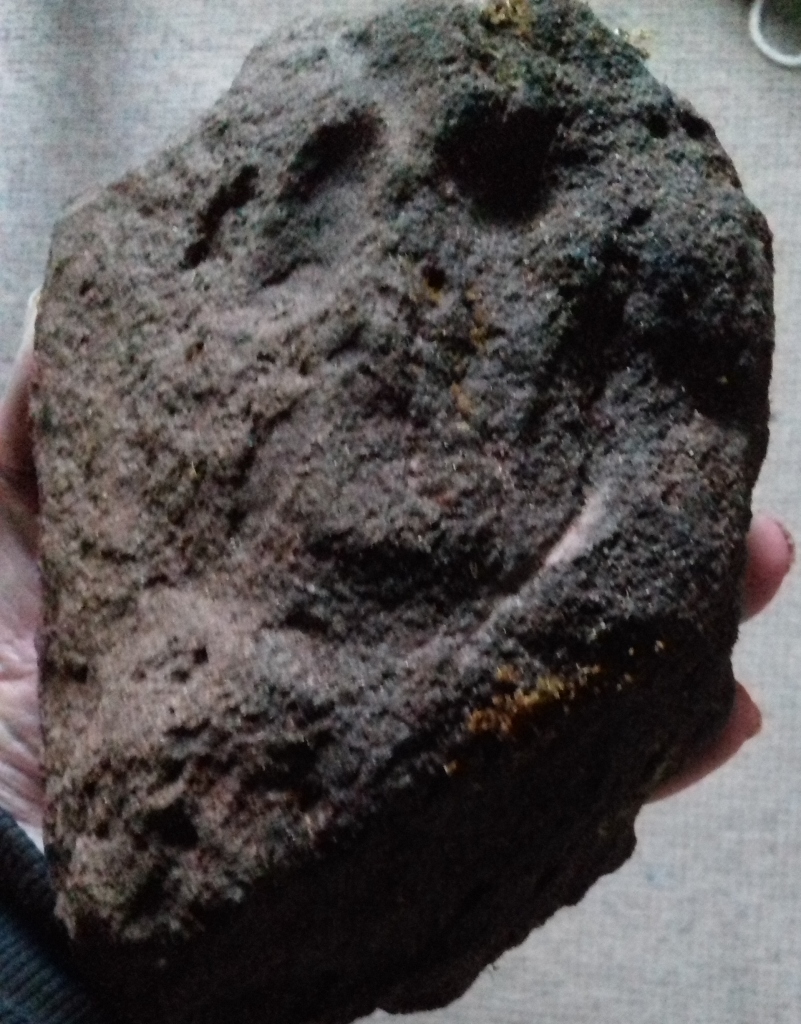
Find Spot in fill of boulder lined pool (Pool 8) incorporated into the west end of the north wall of Roman temple.This medium sized grainy sandstone head is crudely mask like. The facial features are entirely natural with a minimal grinding for the mouth at the base of ‘the nose’. The left hand ‘smiley’ mouth possibly has ochre embedded in the natural crease. The eyes are probably natural water erosion which have been enhanced with grinding. The ragged pit to the right of thr right eye is a break. It is not free standing and accordingly not placed with heads 16, 87 and 88.

Find Spot in fill of boulder lined pool (Pool 8) incorporated into the west end of the north wall of Roman temple. Small gritty face mask votive head.

Find Spot in fill of boulder lined pool (Pool 8) incorporated into the west end of the north wall of Roman temple. Small owl like face votive head.

Find Spot in fill of boulder lined pool (Pool 8) incorporated into the west end of the north wall of Roman temple. The reverse side of H.91

Find Spot in fill of boulder lined pool (Pool 8) incorporated into the west end of the north wall of Roman temple. Small votive head with only one eye, possible oblique lines across right side eye implying eye disease.

Find Spot in fill of boulder lined pool (Pool 8) incorporated into the west end of the north wall of Roman temple. Another head depicting damage or disease to right eye

Find Spot in fill of boulder lined pool (Pool 8) incorporated into the west end of the north wall of Roman temple. Another head possibly depicting disease to left side of face (left blank). The right side has probably been damaged.
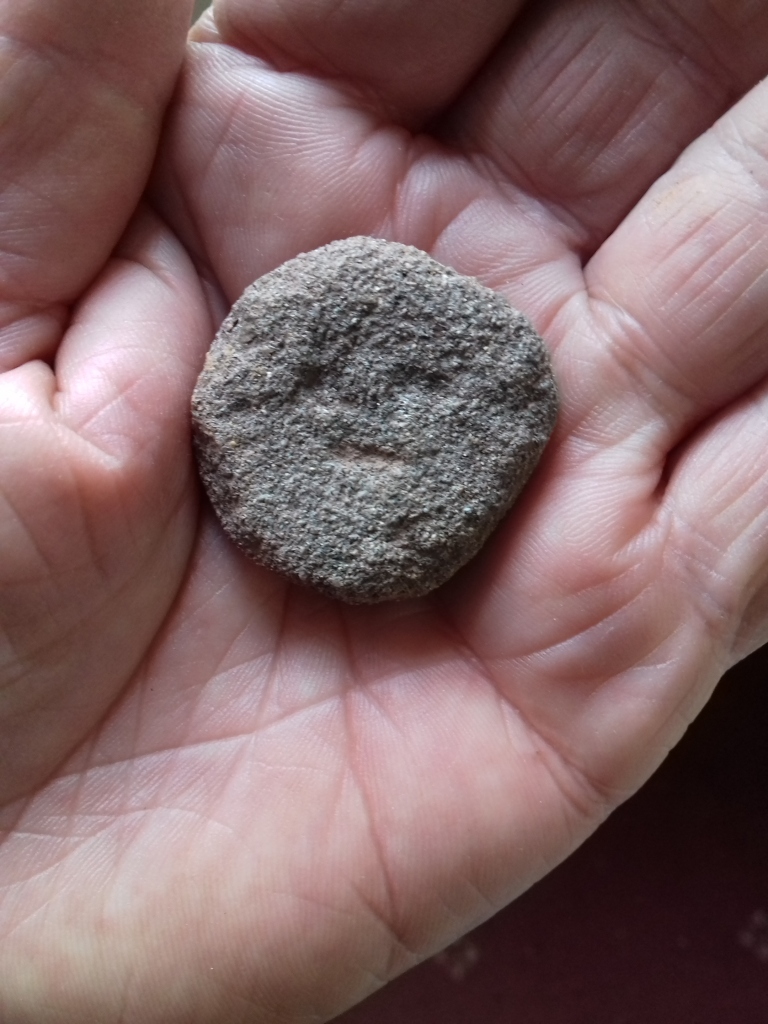
Find Spot in fill of boulder lined pool (Pool 8) incorporated into the west end of the north wall of Roman temple. Miniature votive which possibly has tears emanating sideways from the eyes.
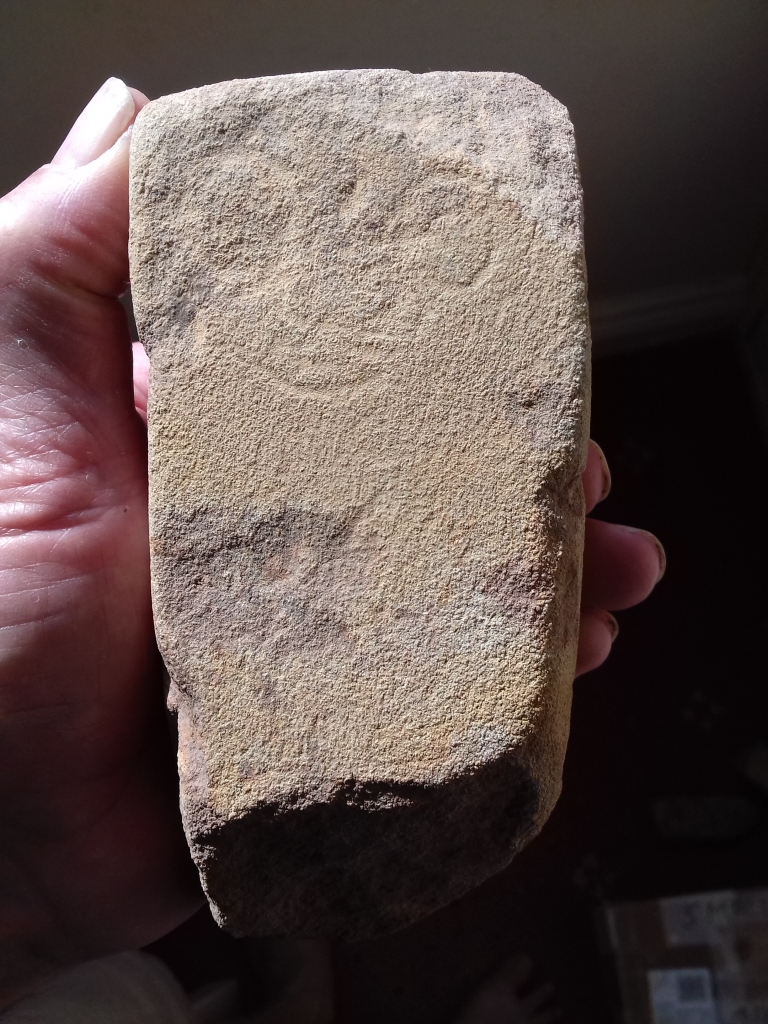
Find Spot Stone Hole 2 this artefact is the top part of a whetstone. It was found with two other pieces from the same whetstone in the top fill to Stone Hole 2, where a standing stone possibly previously stood for the winter solstice sunrise. The ochre stone head H58 came from the same deposit. The whetstone is 6cm x 5.5cm in cross section and 33cm long. Although the image is now very faint it does appear to be two eyes and trace of a nose with an open mouth below. The significance of this artefact is yet to be considered. However the whetstone compares with the few longest whetstones found in Ireland. The Littledean Whetstones and Hones Gallery is currently under construction.

Find Spot in fill of boulder lined pool (Pool 8) incorporated into the west end of the north wall of Roman temple. This head was amongst a deposit of whetstones filling the top of Pool 8. Representation of the nose is abstract, while the mouth is quite ephemeral in outline. The nose is marked by the frontal ridge of the stone. The mouth by the faint outline of a large downturned mouth, only revealed by careful and prolonged cleaning of the slight incisions blocked by hardened (baked?) clay. Or it may represent a moustache and the natural crack the bottom of the mouth, which can just be made out as an oval above the crack. It is the single eye set almost in the centre of the head which is most significant. From the single eye rays fall towards the earth. Head 16 from the drain outlet ay also be depiction of the single eye. These do not seem to be heads having anything to do with healing but a lot to do with the myth of Balor of the Evil eye. This artefact was discovered in 2020 when anomalies at the west end of the north wall foundation were investigated. Evidence quickly accumulated demonstrating that an Iron Age paved pool, with in situ stone revetting, still survived at the base of the foundation of the nymphaeum temple. Numerous heads were found including two more heads of the ‘Bronderslev’ types (H.87 and H.88). These endorse H.16 which was located within two metres of 87 and 88.
T
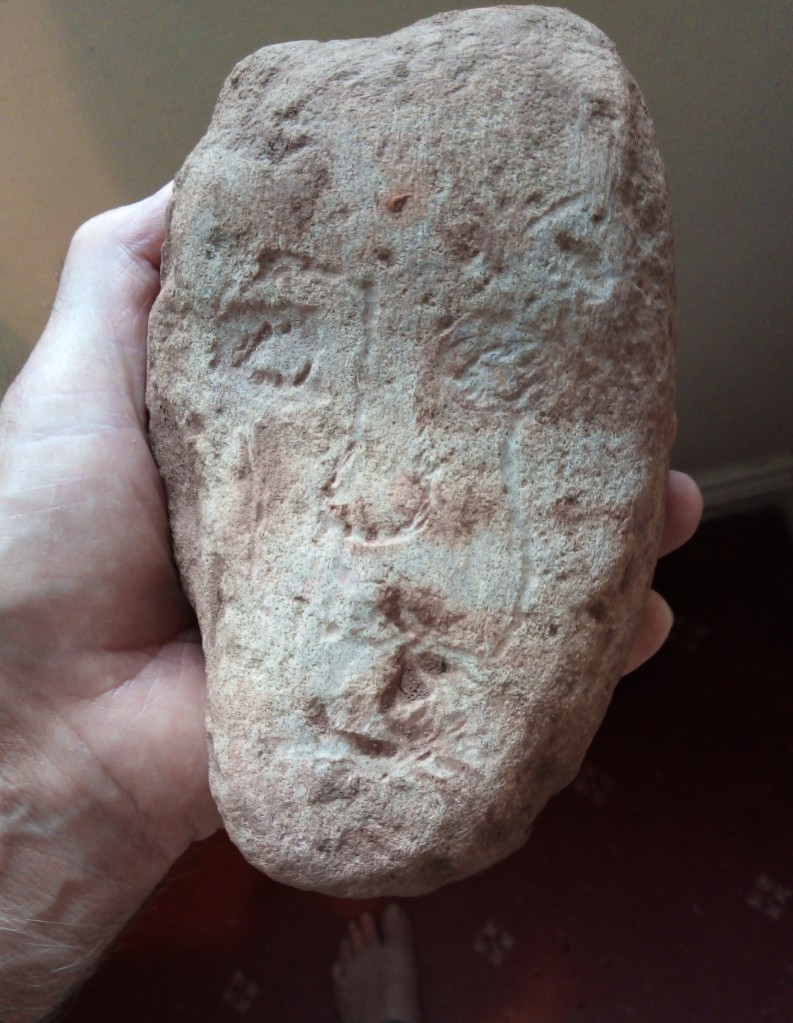
Find Spot in drainage gulley at base of period 2 wall foundation and apparently either part of the revetting of Pool 8 or laid in the edge of the pool. The context is uncertain therefore, as it could be late Iron Age, Early Roman or later 1st century, if not an even later deposit. All things considered and given its somewhat crude style it may be early Romano Celtic. The head is particularly interesting for its geology (not yet determined) and its complex etching of facial features.

Find Spot buried in wall foundation of the north west corner of the temple beside Pool 8. Probably coeval with Period 2 temple. The stone appears to be spotted dolerite (bluestone) with the nearest outcrops on the Preseli hills. The stone has an indistinct and much weathered face on one edge. Also there is a declivity in the top of the stone. One broad side of the stone is covered in a quartz seam. It may have been an altar stone and was probably set up in the ground on a plinth. The burning question is how did it get from West Wales to Littledean. It suggests that the Littledean site was known about by the inhabitants of West Wales (see further below.

Quartz seam on one broad side of spotted dolerite (bluestone) erratic block
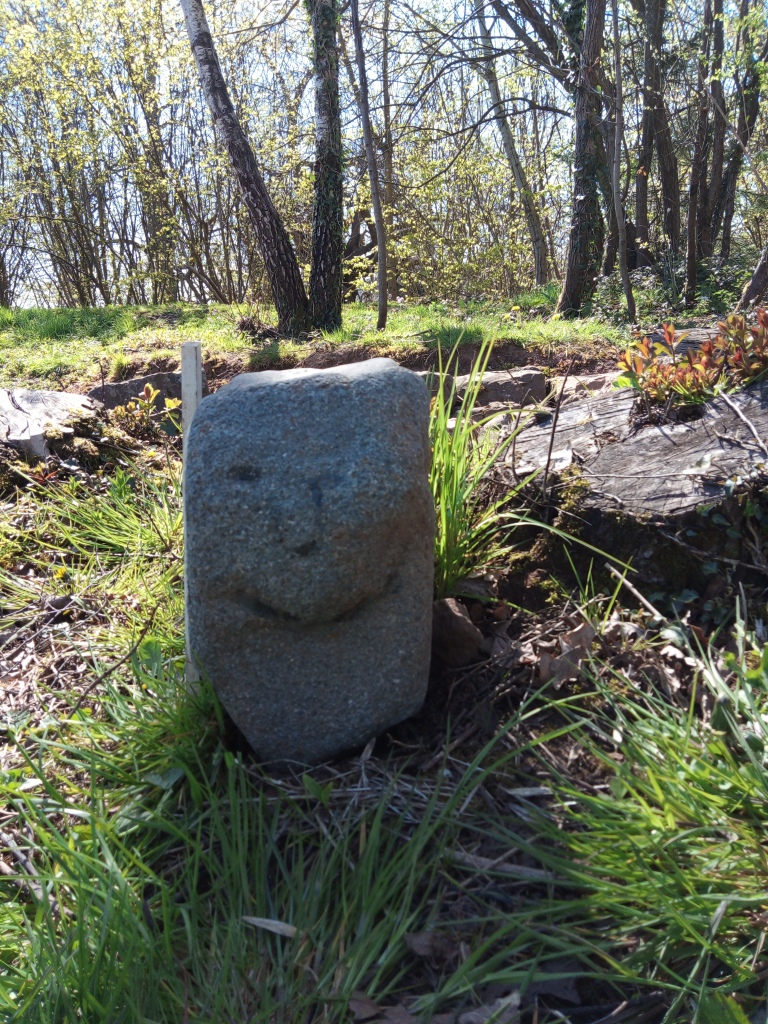
Recent research at Littledean (April/May 2022) has established a high probability for Neolithic miniature heads at Littledean. This has focussed attention more directly on the concept of the Bronderslev Head, which may be a red herring for Littledean. The eyes and nose clearly visible on this image of the spotted dolerite (bluestone) erratic boulder may well be neolithic. An analysis of the facial imagery on many of the Littledean heads is likely to demonstrate closer similarities with neolithic facial imagery than Celtic. This will have a profound consequence as it is likely to shift the understanding that the Littledean heads are a Celtic phenomenon to one that suggests the greater majority of the heads reflect a Neolithic practice.
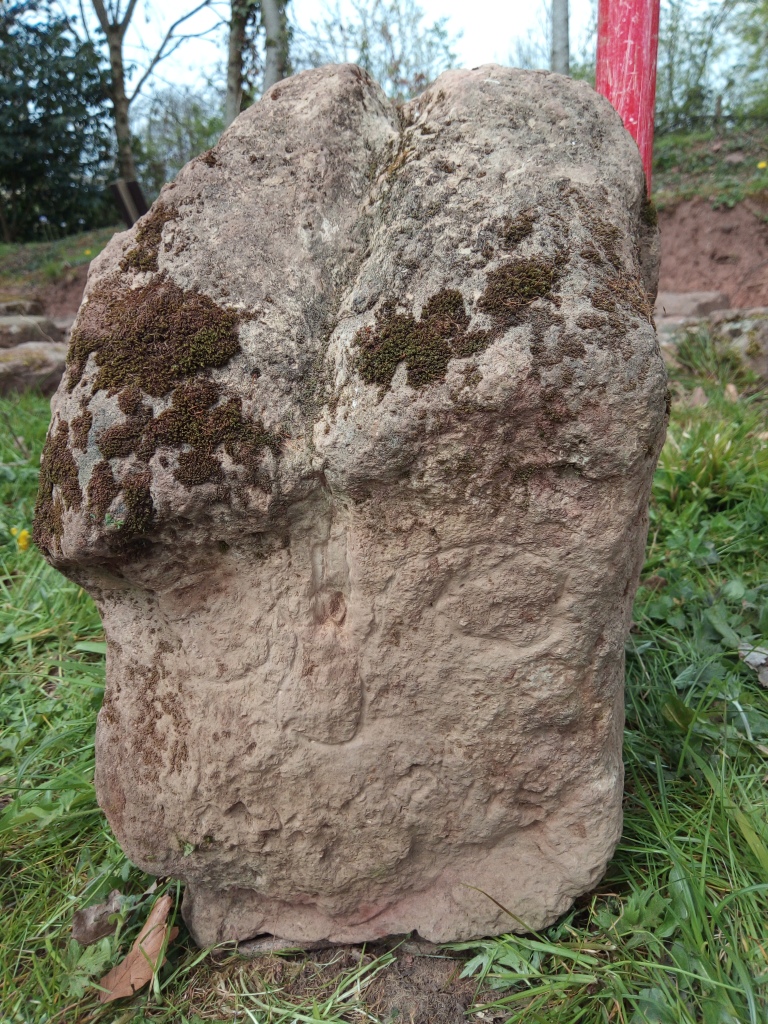
Find Spot in wall foundation of Period 2 wall adjacent to Pool 8. This is a large shaped block of ‘whitehead limestone’ probably from the iron ore mines on the eastern edge of the Forest of Dean above Littledean and about a mile across the valley from the temple site. The limestone has areas of red ochre pigmentation which occurs naturally in the limestone. It is a good example of a ‘phallic’ head and the tallest head from the site. It appears to have broken off a shaft and may have been the top of a carved standing stone. The stone was covered in moss and clay dirt. Recent claning has revealed the nose and eyes of a face. Water erosion down the centre indicates it was in a vertical position. Striations in opposing directions over the head may represent hair braids and may date the head to the late Iron Age. Its position in the wall foundation, as with H.99 indicates it predates the later 1st century AD and the erosion suggests it may be pre Roman. It is one of the most important artefacts from the site.
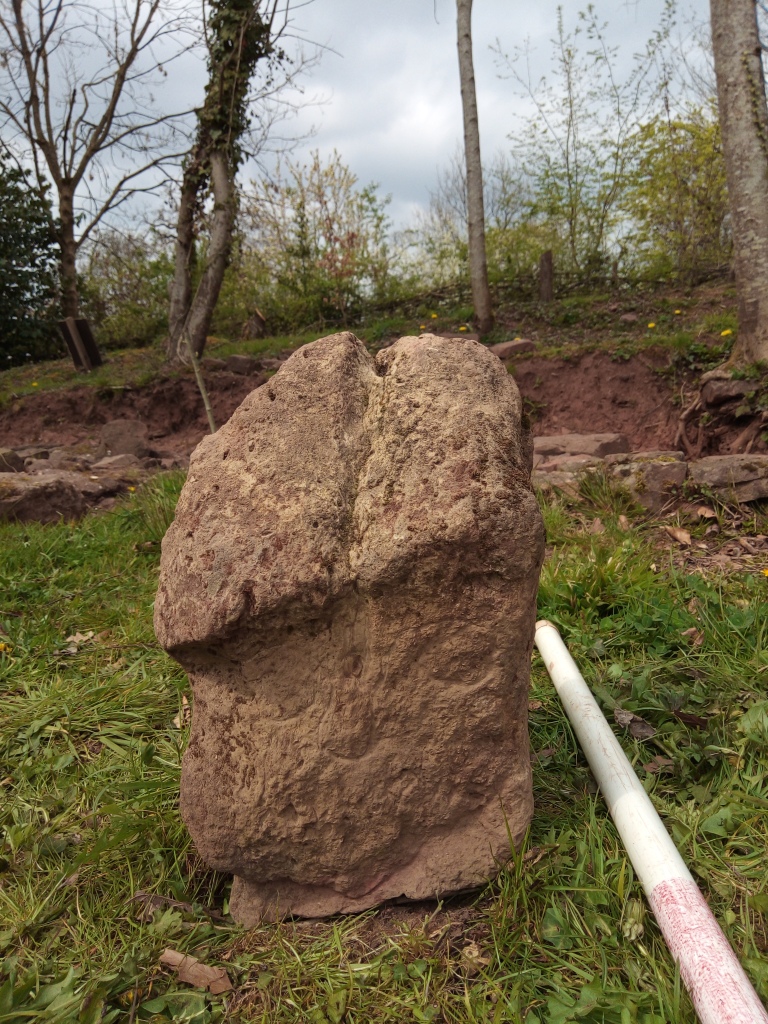

Find Spot at base and below the south west embankment of the Period 1 pool on the base of Water Channel 2. This large sandstone head has features and expression very typical of Iron Age heads. It is one of several (see following) heads from a certain Iron Age/pre Roman context and probably dates to the 1st century BC or earlier.

Find Spot at base and below the south west embankment of the Period 1 pool on the base of Water Channel 2. This large quartz pebble is identified as a head by association with other heads all from the same context. This group of heads definitively date to before the quenching phase of Pool 1 and before c.43AD. Traces of etching indicate an attempt to create an eye and nose features and the natural crease a mouth. The base of the head has an intriguing slight protrusion suggestive of a ‘severed head’ symboloism.

Find Spot Water Channel 2 below south pool bank overflow. This extraordinary head is thought to possibly represent a dog’s face with long nose and fur lines below the eyes. Dogs were considered healing animals. Or it may represent a wolf’s face, the wolf being one of the Welsh moon goddess Arianrhod’s familiars (Anthony Beeson pers. comm.)

Find Spot Water Channel 2 below south pool bank overflow. This head, although associated with heads 102 and 103, which are definitively dated to the Iron Age through context and several slag dedosits, appears to belong to a few heads with abstract facial features. It may be much much older and from an earlier tradition. The Water Channel was constructed in the late Neolithic or Early Bronze Age.


Find Spot in rubble surrounding a rectangular post pit and forming the west bank of Pool 1 before the metal quenching phase. The rubble appeared to have been hard standing around a post, possibly a votive pillar which had been approached by many people over a long indefinite period of time.
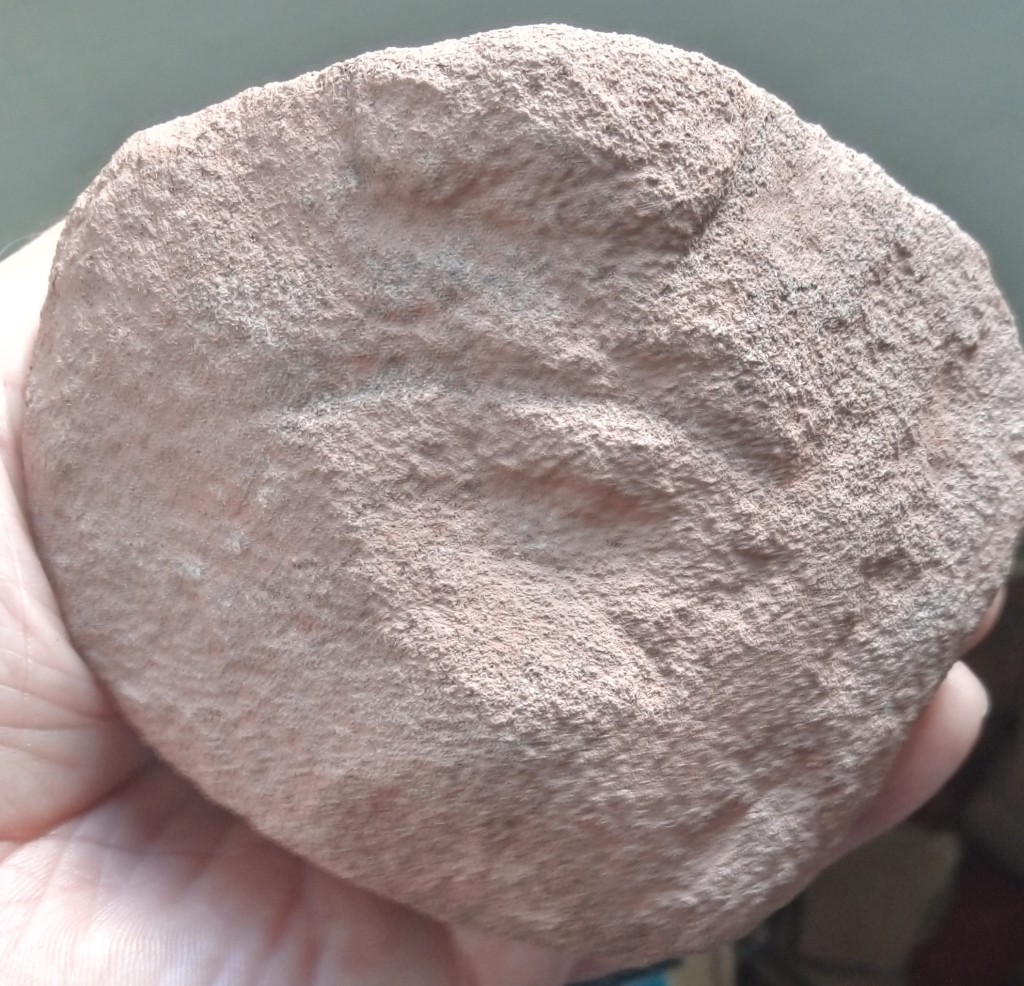
Find Spot in rubble surrounding a rectangular post pit and forming the west bank of Pool 1 before the metal quenching phase. Same find spot as H.105. This is a fragment of a largehead and is clearly the lower half of a damaged face.

Find Spot in rubble surrounding a rectangular post pit and forming the west bank of Pool 1 before the metal quenching phase. This is from another broken head. It does not fit H.106


Find Spot in rubble surrounding a rectangular post pit and forming the west bank of Pool 1 before the metal quenching phase. This may be from another broken head or it may have been a votive to wish for healing an eye complaint.

Find Spot in rubble surrounding a rectangular post pit and forming the west bank of Pool 1 before the metal quenching phase. From the same rubble compacted surface as the last heads described. It appears that stone heads were trampled or beaten down into the ground at the base of the post. Either they may have been placed around the post and became subsequently damaged and subsumed into the ‘cobble’ ground surface or were deliberately smashed and beaten into the surface. We suspect more of the compacted stones in this context may have been heads. The cobble surface sloped down the bank slightly and it may originally been an artificial plinth around the possible votive post.

Find spot in base of Water Channel 2 at south end near H.102 this is a putative Neolithic head with remnant of patterning lines.

Find Spot in base of drainage gulley from temple. This head was on the edge where the temple drainage gulley flowed into the outer gulley, along which water flowed away from the temple area. The context suggests the head was placed in the gulley in the late Iron Age.

Find Spot in base of drainage gulley from temple. This head was buried in a pit in the floor of the gulley at the point where it flowed into the outer gulley. The pit was cut through the clean floor and not through the silt layers filling the gulley. The deposit context can be dated to the Roman construction phase when the gulley was probably refurbished. It is a very fine head with smoothed surfaces and worked along an edge of the stone. The sub circular eyes and mouth are finished in an apparent haphazard manner. However one should perhaps not read anything into this as lack of attention to detail but more as an expession of meaning lost to us today. Possibly late 1st century or 2nd century Romano Celtic.

Find Spot in wall foundation by Pool 8. This interesting abstract art is considered a head by medical experts, who see it as representing one good eye and one blind eye, or an eye affected by very severe migraine. The presumed nose and mouth is completely unique in the Dean Hall corpus of stone heads as is the face mask as a whole. It can be dated with reasonable confidence to the Roman period and possibly the period 3 rebuilding of the temple in the late 2nd or early 3rd century. However all the heads redeposited in the foundation area are seen to be late Iron Age and were probably placed in the foundation in the period 2 construction of the first large temple. Thus this abstract face mask may be from the same construction period.

Find spot Hearth Area 2 to the south side of (HA1). This particularly interesting and important head etched as a face mask into sandstone has a possible hair band and above the hair band a chevron frieze for hair. The facial features are interpreted by medical Doctors Nick Summerton and Michael Grant the Baron de Longueuil, independently of each other, as representing Bell’s Palsy. As such it is an artefact of great potential significance. Bell’s Palsy can recover spontaneously and thus the head provides the possibility for a ‘miracle cure’ whereby the head was offered at the temple, the cure took place naturally and was seen therefore as a successful healing with huge kudos for the temple. The drooping eye and eyelid and mouth are typical indicators for the condition.

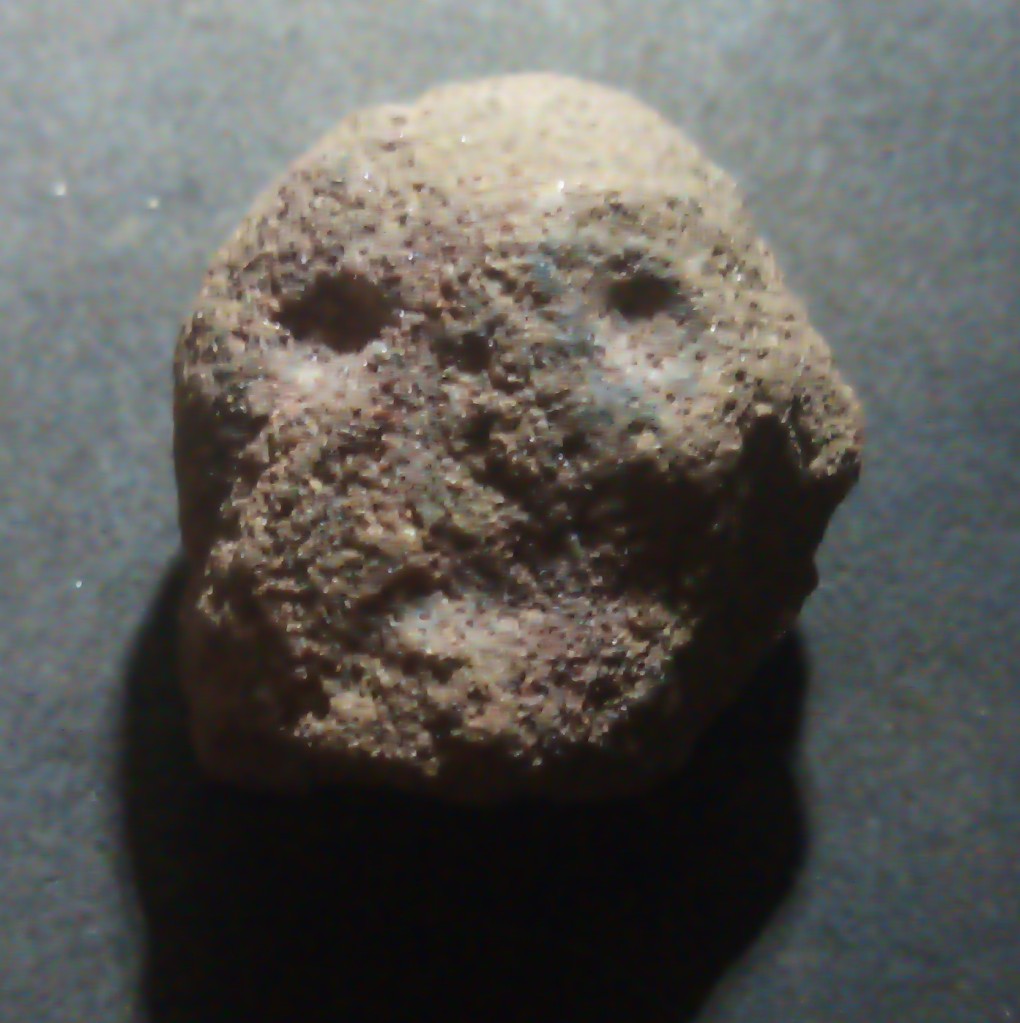
Find spot Hearth Area 1 (HA1). A miniature sandstone head with well defined ‘pin hole’ eyes recovered with a number of other votive objects from in front of the prehistoric ‘altar’. This is the first head found which shows clear proof for simplistic features of eyes, nose and mouth.

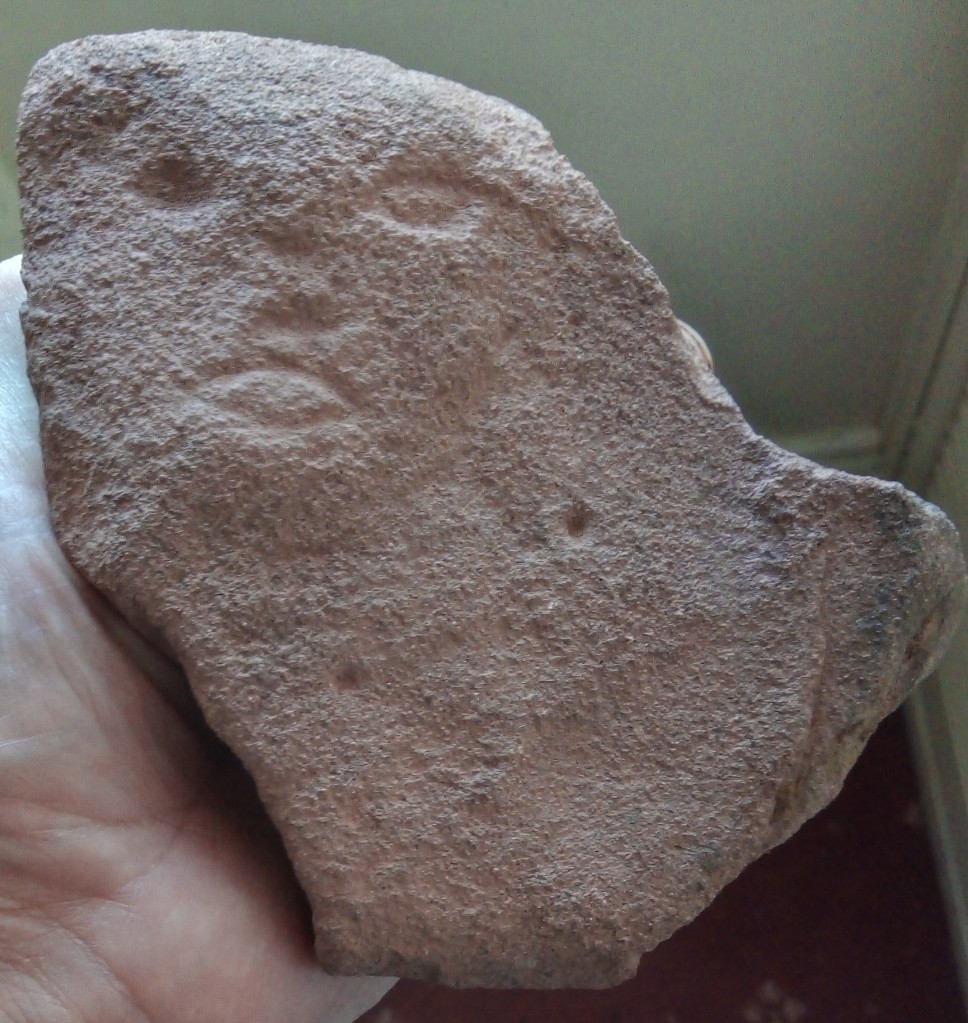
Find spot overflow to south end of Bronze Age Water Channel WC3.

This head is possibly etched onto a grinding or hone stone as it has a smoothed dished area. The stone has been broken whilst retaining the face in the top left corner of the stone. It may be a decorated whetstone and if so very rare or perhaps the face was etched in after the stone broke and buried as an offering. The eyes are etched differently to each other.

Find spot adjacent to heads 123 to 125. By association this is a possible head fragment

Find spot of H.118 in the east side construction edge at the outfall of the 3rd period flushing drain of the Period 3 Roman temple of the late 2nd/early 3rd century above Heads 123,124 and 125. Probably a Romano Celtic face mask c.200 AD.


Find Spot in outer bank, east end, of Pool 8 on edge of drainage channel from Period 2 drain. Deposit date late 1st to early 2nd century AD. Image of a possible genius culcullatus with hooded cloak. Same context as H.120.

Find Spot in outer bank, east end, of Pool 8 on edge of drainage channel from Period 2 drain. Deposit date late 1st to early 2nd century AD. A fragment of a probable Romano Celtic head (Anthony Beeson) with ‘flame’ type hair imagery.

Find Spot Wall foundation north west corner period 2 below slag deposit See H.88. Bronderslev type head.
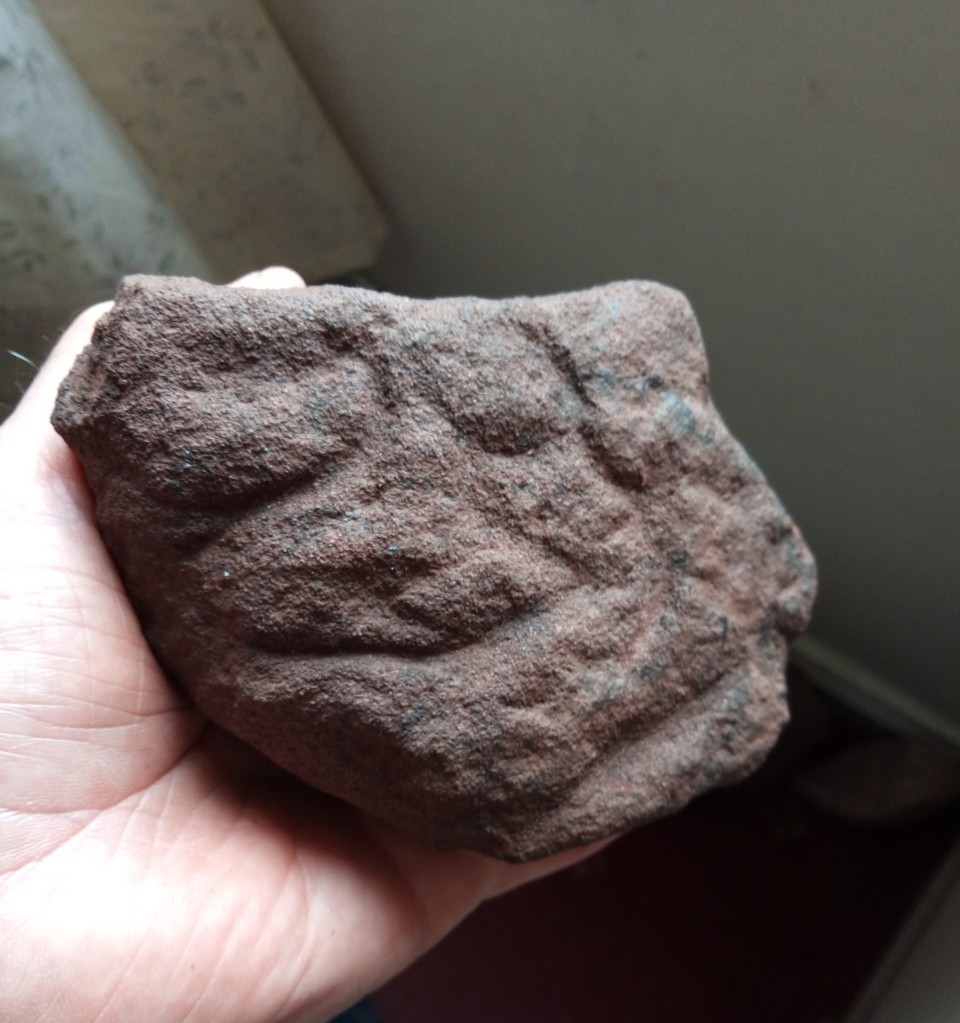
Find spot Water Channel 2 towards south end at very base penetrating the natural clay. This is a significant artefact which, because it was impressed into the clay floor at the base of the water channel, below all the silt layers, may be considered Neolithic or early Bronze Age. The abstract decoration is possibly suggestive of facial features.
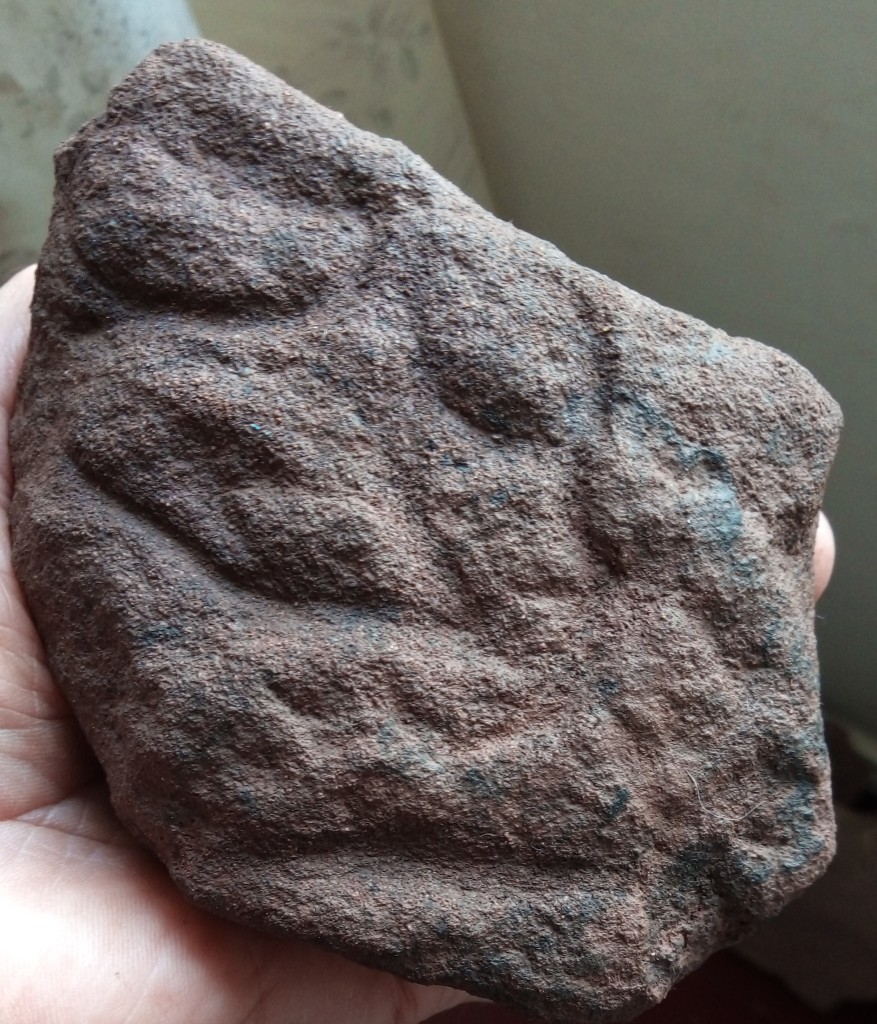

H.123 Head 123 Miniature sandstone face mask

H.124 Head 124 Miniature sandstone face mask
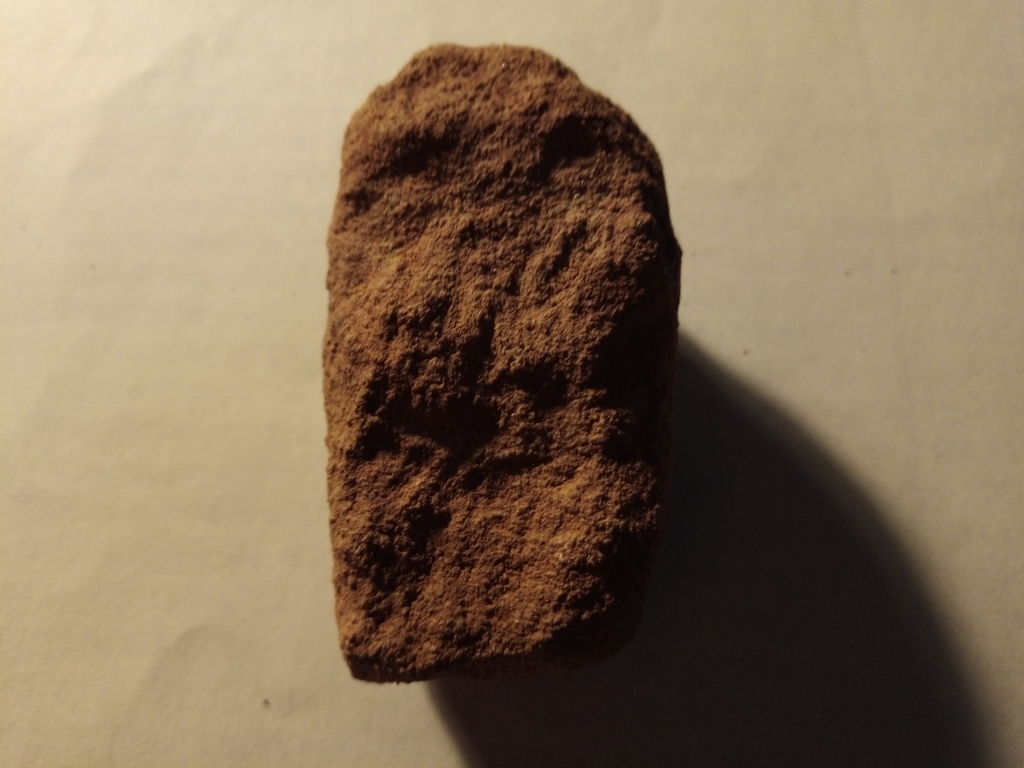
H.125 Head 125 Miniature sandstone face mask
The find spots of H.123,124 and 125 were all together in the east side construction edge at the outfall of the 3rd period flushing drain of the Period 3 Roman temple of the late 2nd/early 3rd century and lay below H.118 and adjacent to H.117 and H.105. It is the grouping with the obvious head 118 which makes it very likely these are miniature votive offerings accompanying a wish to the water goddess. Significantly the context indicates they were deposited after the later 2nd century AD long into the Roman period. A similarity with other miniature Littledean heads from certain Iron Age pre Roman Conquest contexts is striking.


This head is particularly interesting. It has only recently been recognised. It probably came from the eastern end of the temple in the eastern outer court with other random building stones, which were gathered up during excavations in 1986 and stored in a stone pile. This one was liberally covered in moss in 2019 and encrusted with dirt. The general shape alerted me to its possible interest and after cleaning away the moss and dirt the facial features emerged. Current ongoing study suggests it may have been carved into a roughly rectangular block of conglomerate sandstone and reworked in the late 2nd or 3rd century AD as a keystone. One tiny patch of mortar suggests it was used in a construction context.


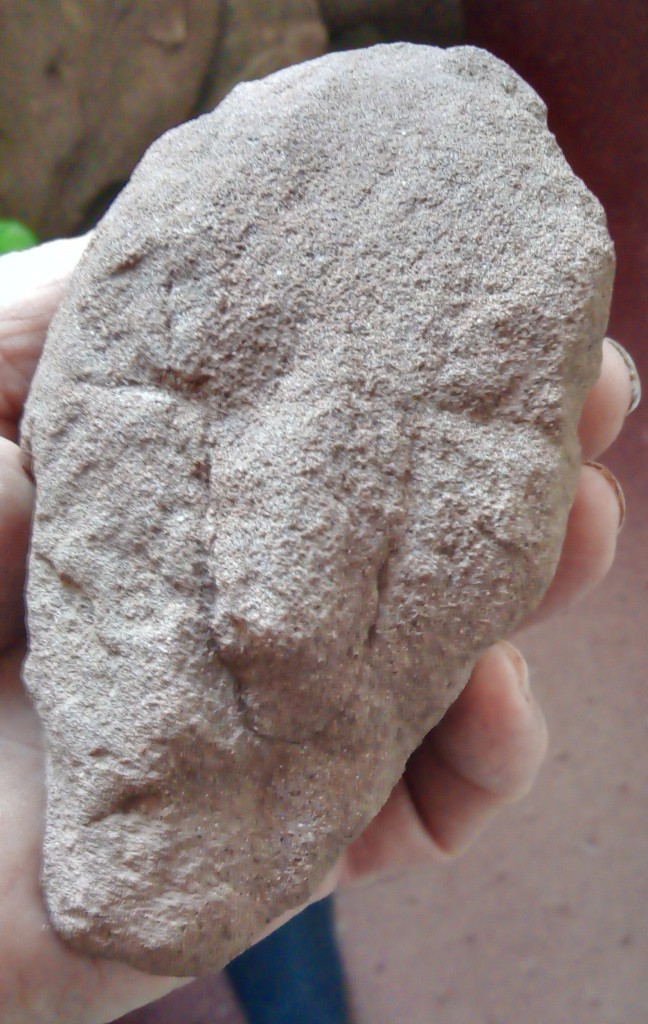
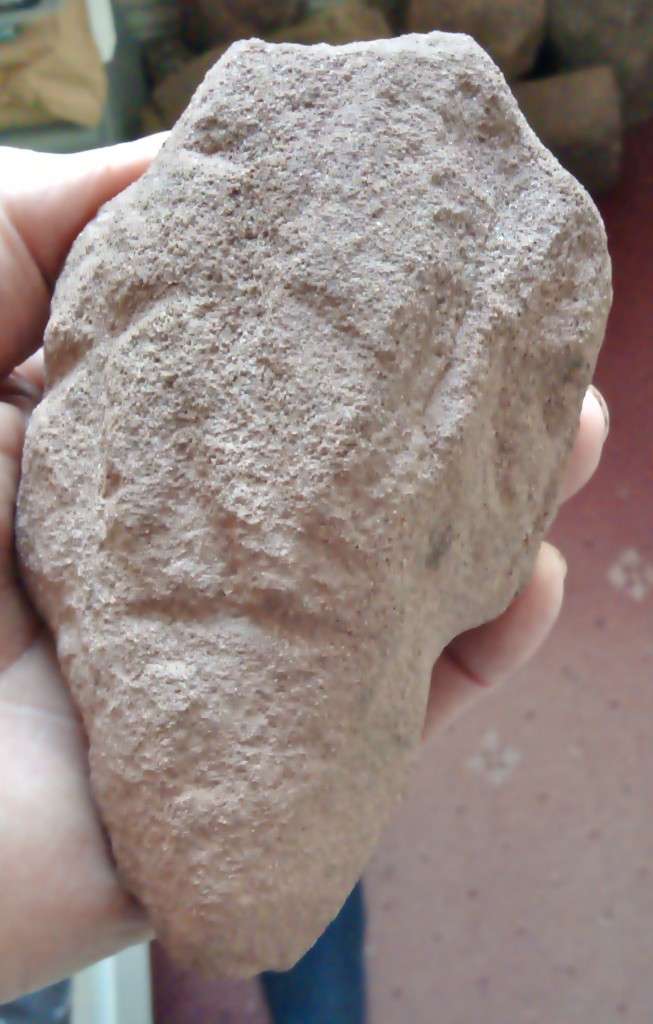
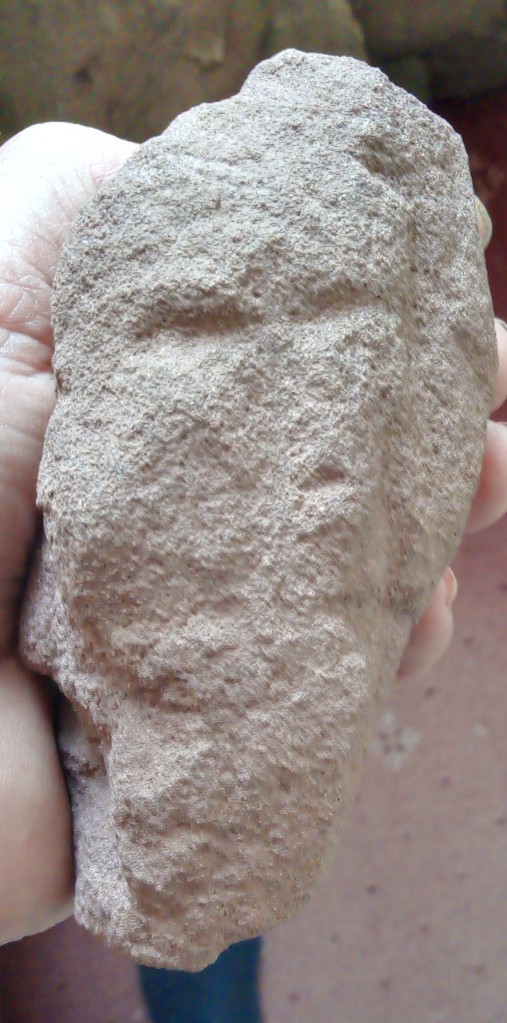
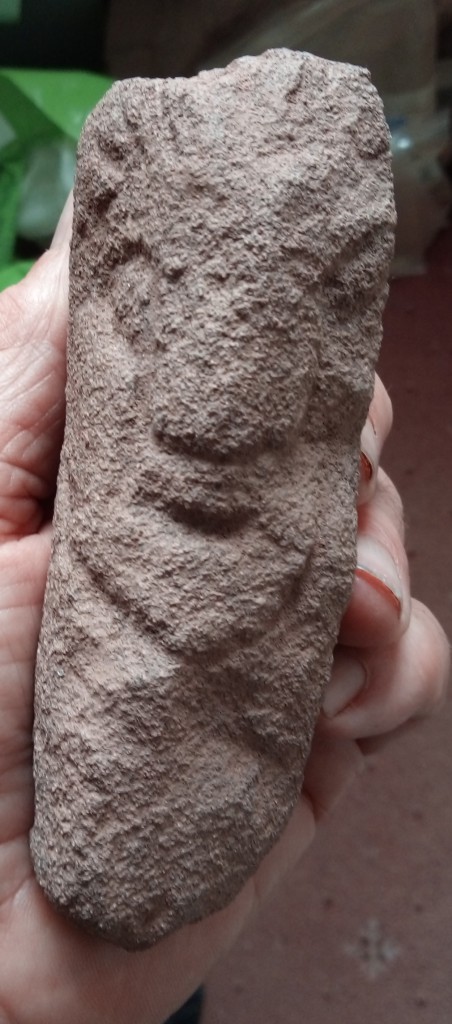
This head has a similarity to wooden heads from Le Temple de la Foret d’Hallatte in France


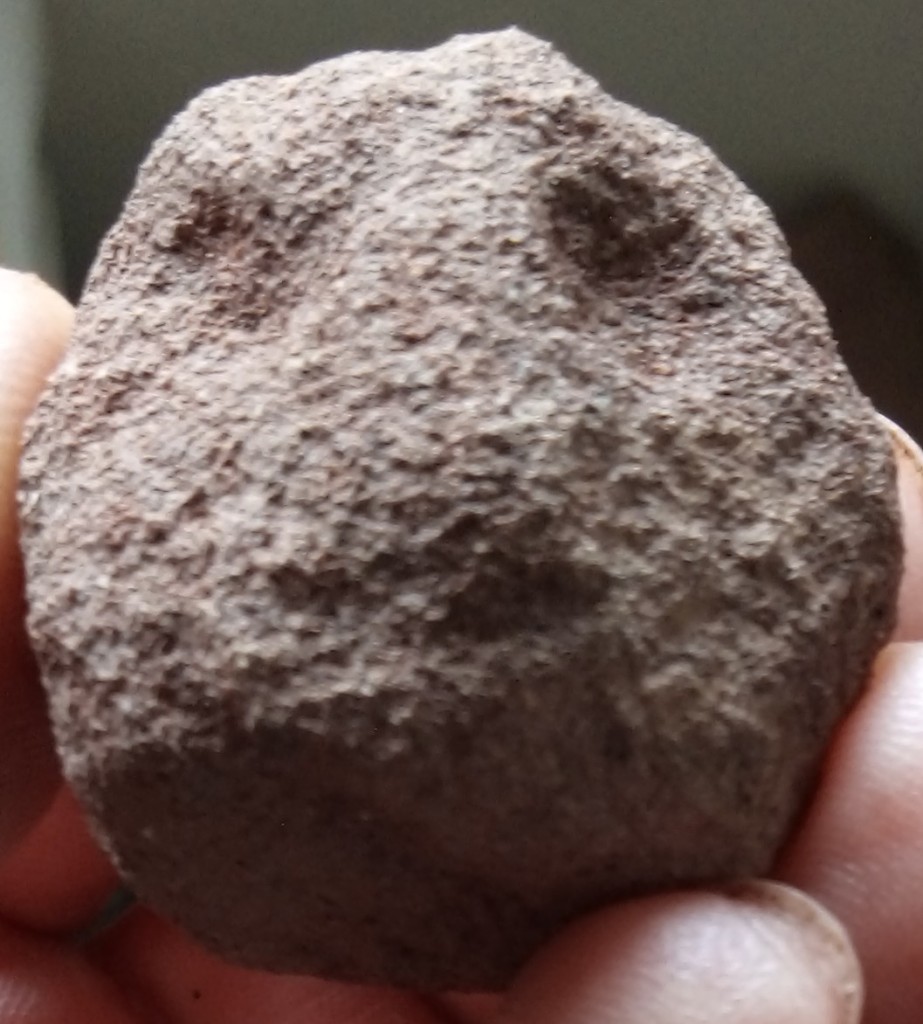



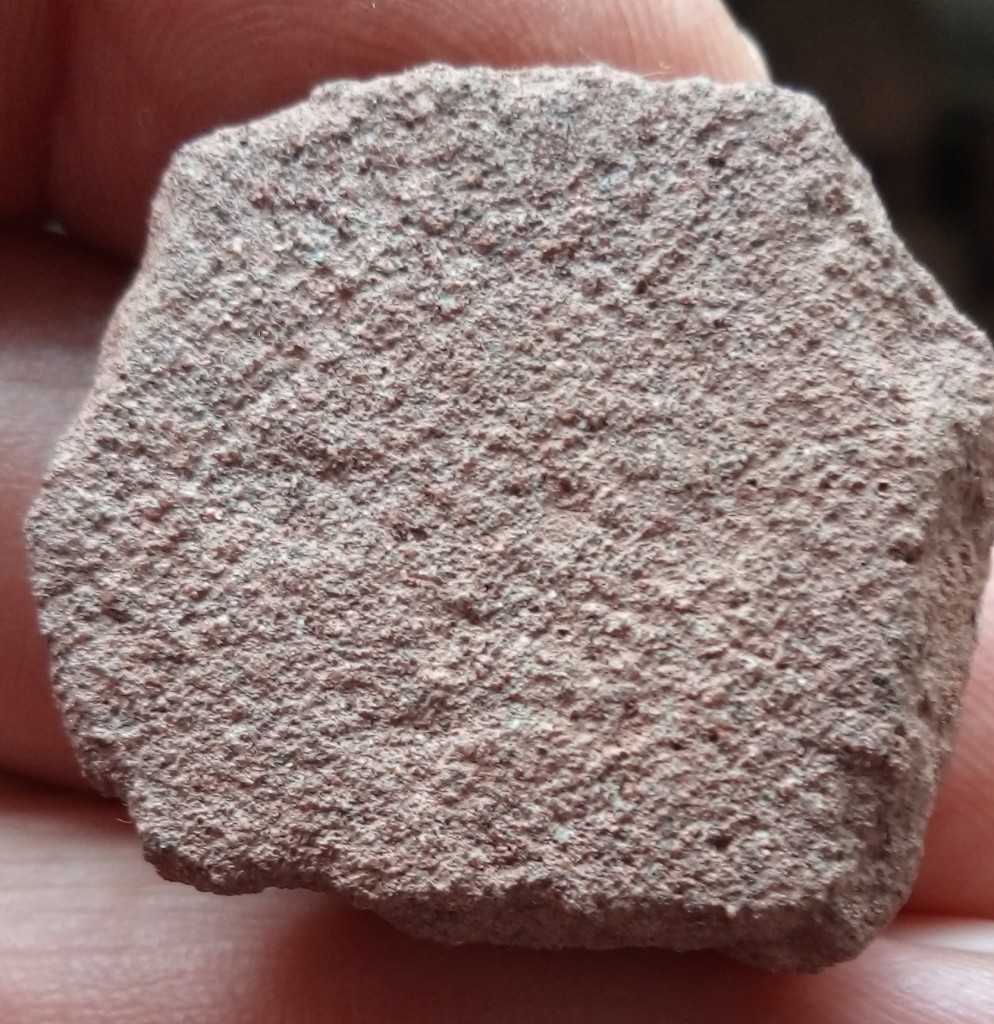



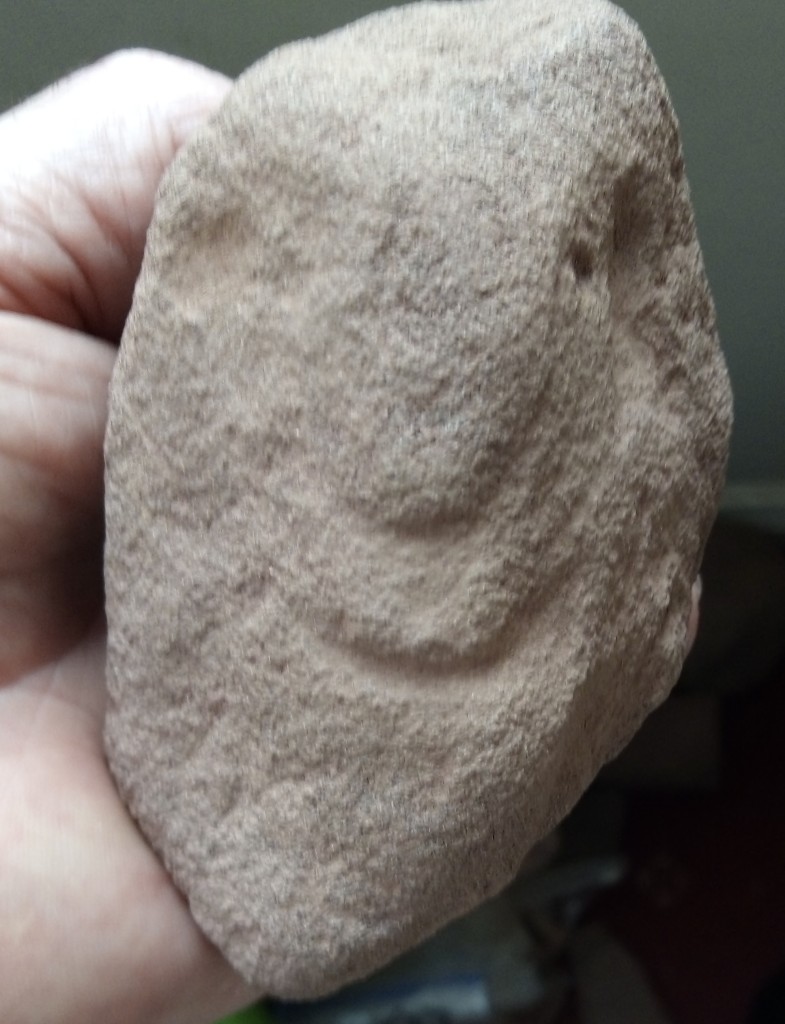






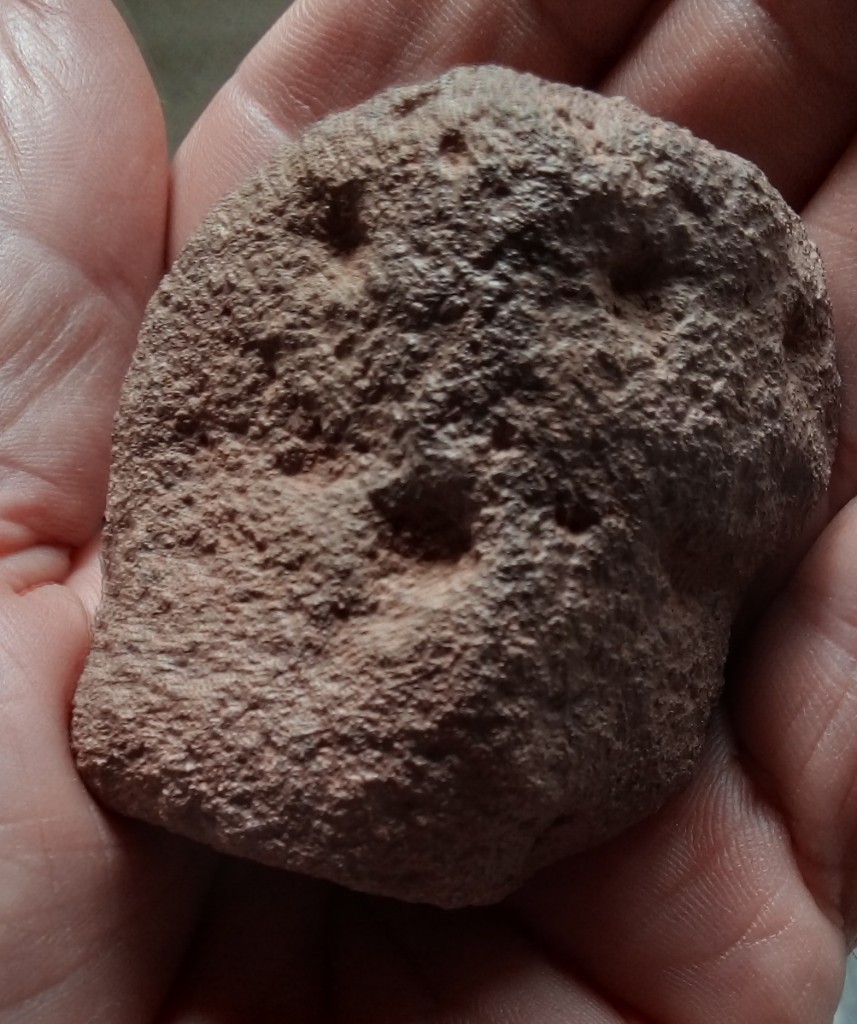
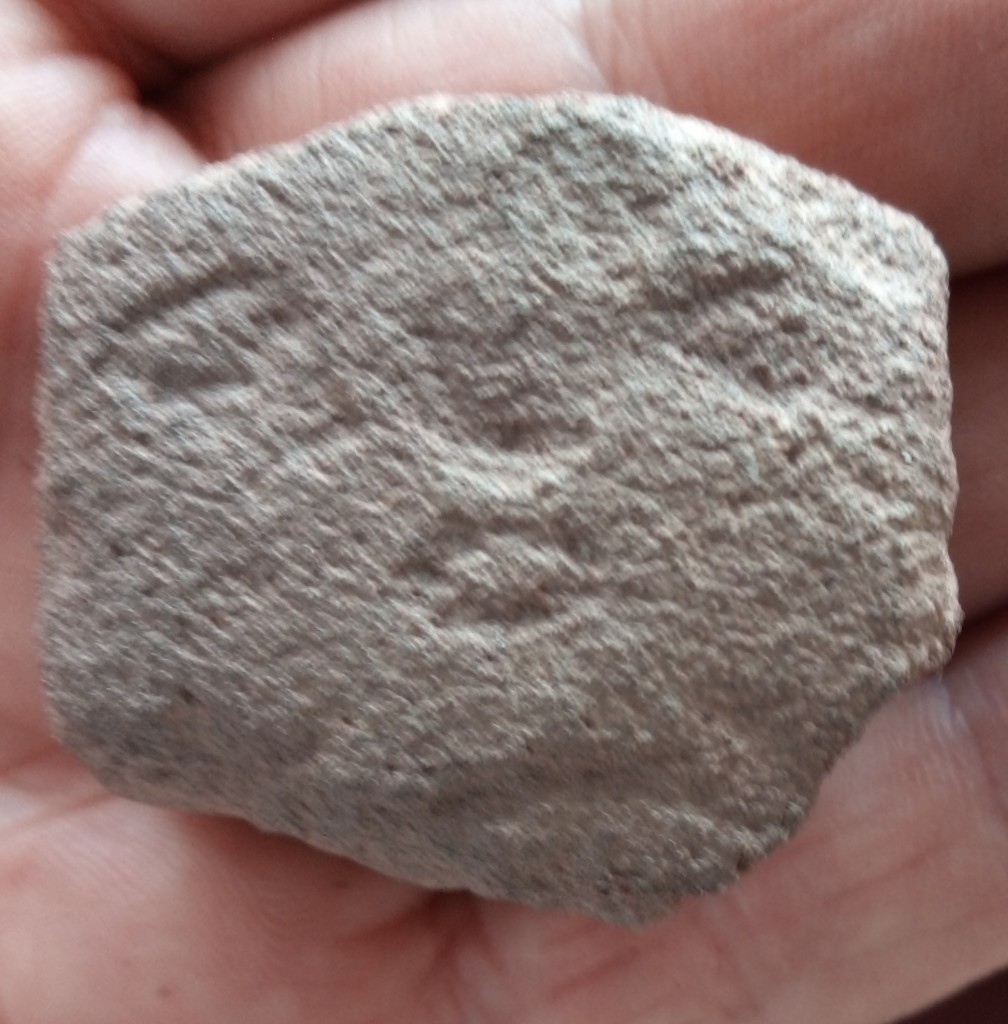


Another head with similarities to the wooden heads from Le Temple de la Foret in France




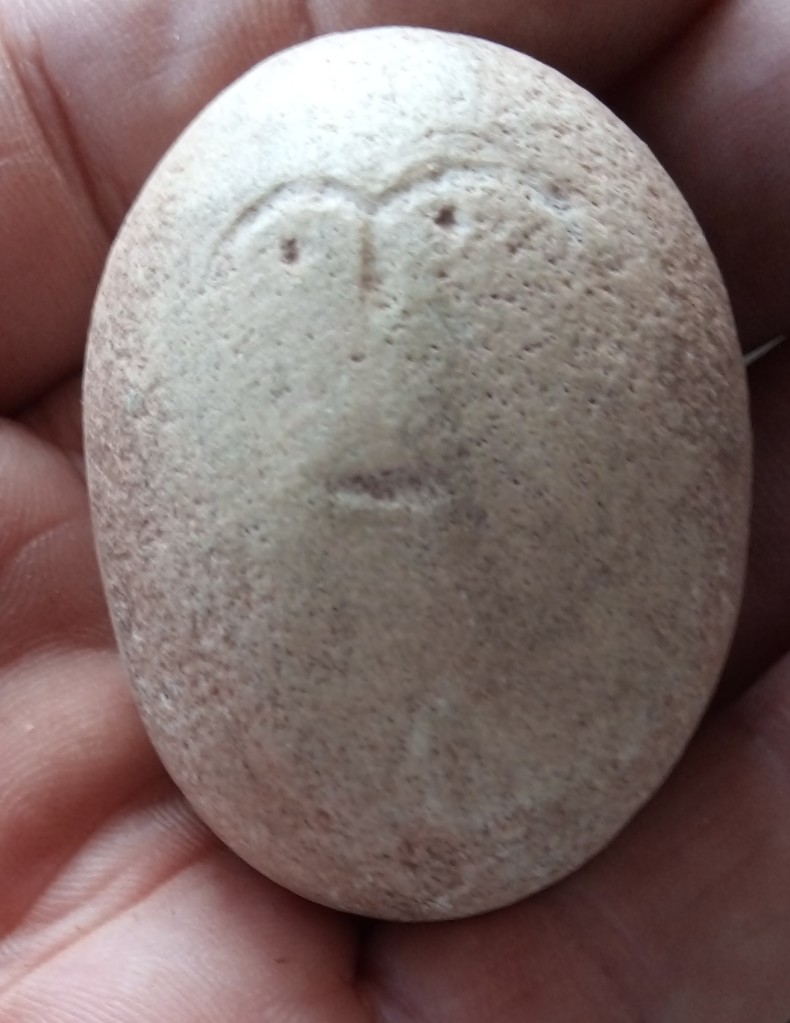

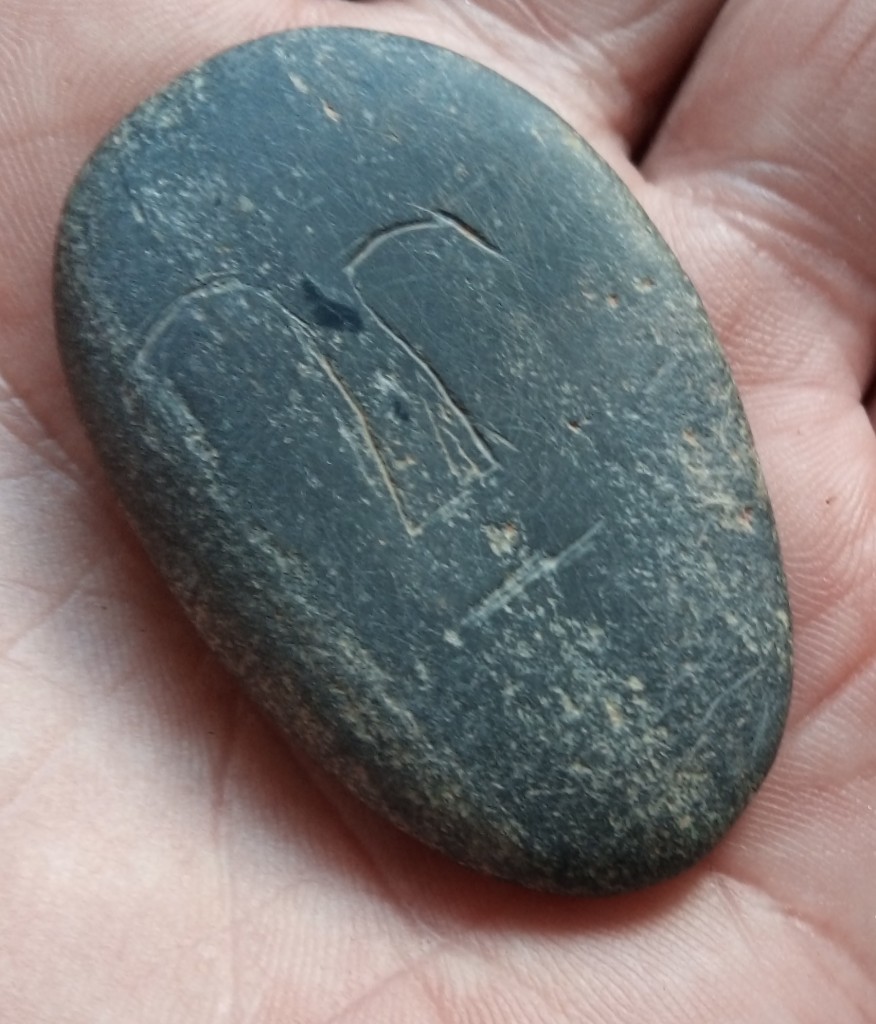


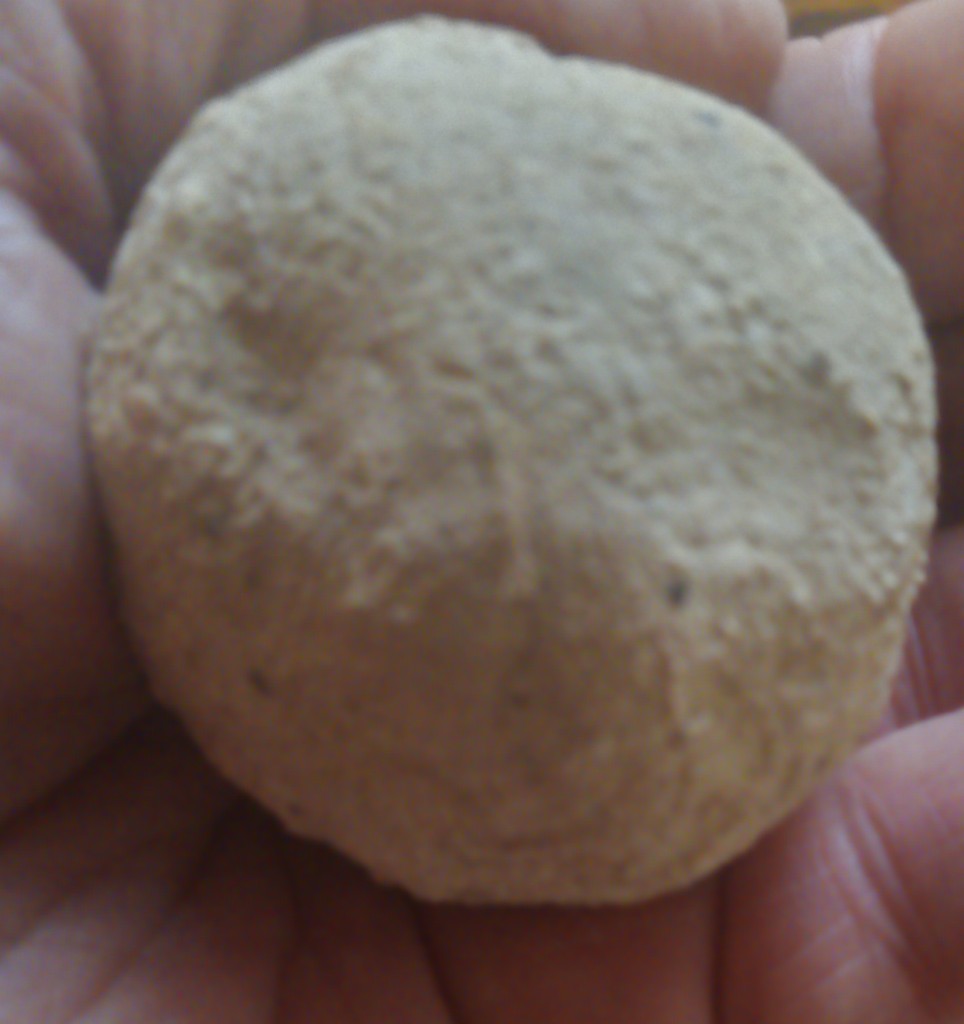




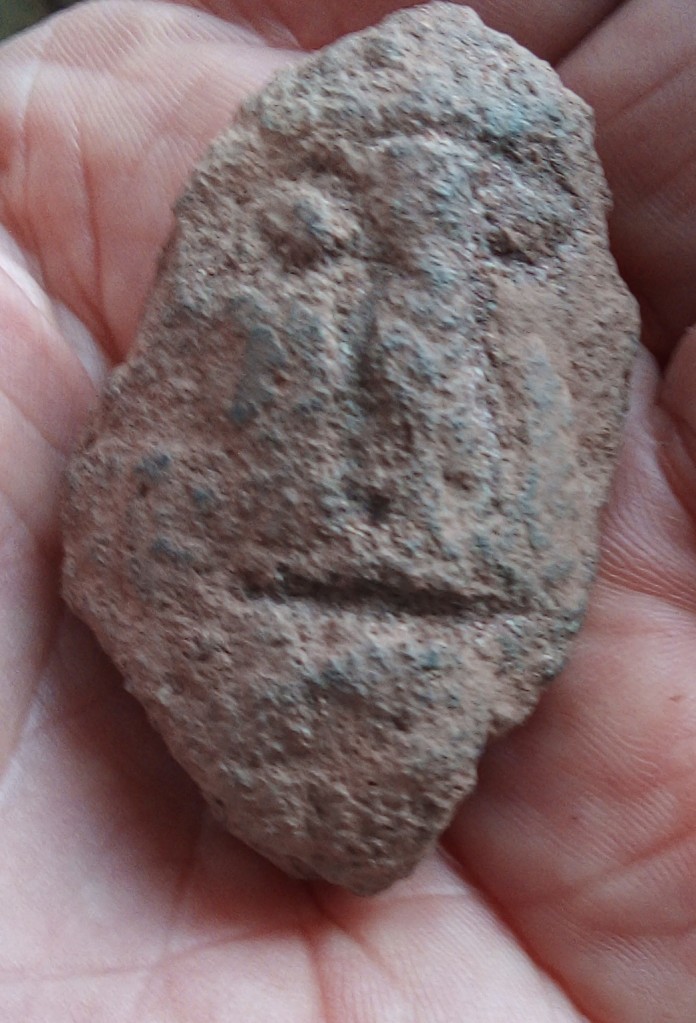
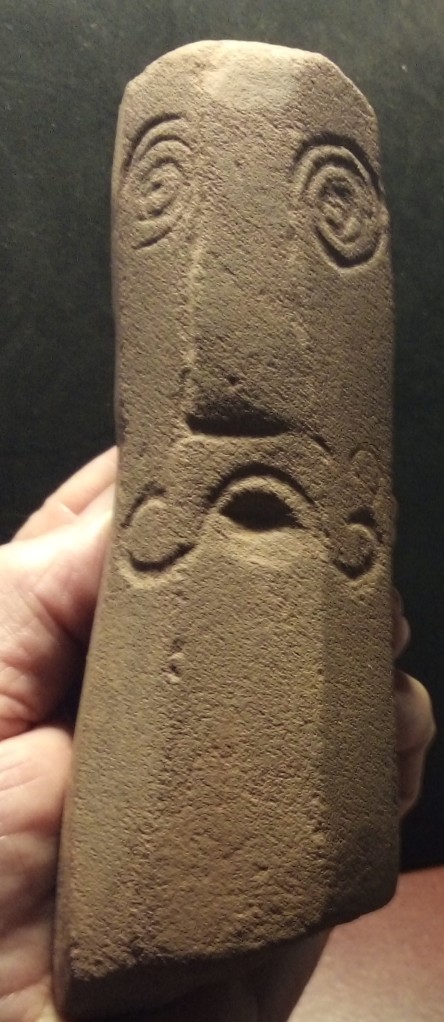
This remarkable head came from Pit 26 in the Iron Age ‘memorial ground’ where eleven pits have been identified and excavated. Nearly all these pits have had a single artefact placed in them and sometimes more. This artefact is a very rare octagonal whetstone (one parallel is from Ballinderry in Ireland). The face shows evidence for continued sharpening use. There is the residual trace of a terminal flourish for an earlier moustache which can be seen in the picture. The decoration is clearly in the La Tene Style and this may be the most important Iron Age artefact from the Littledean Temple. There are two other decorated whetstones from the site, one with a face etched into one end and the other with a ship or boat.

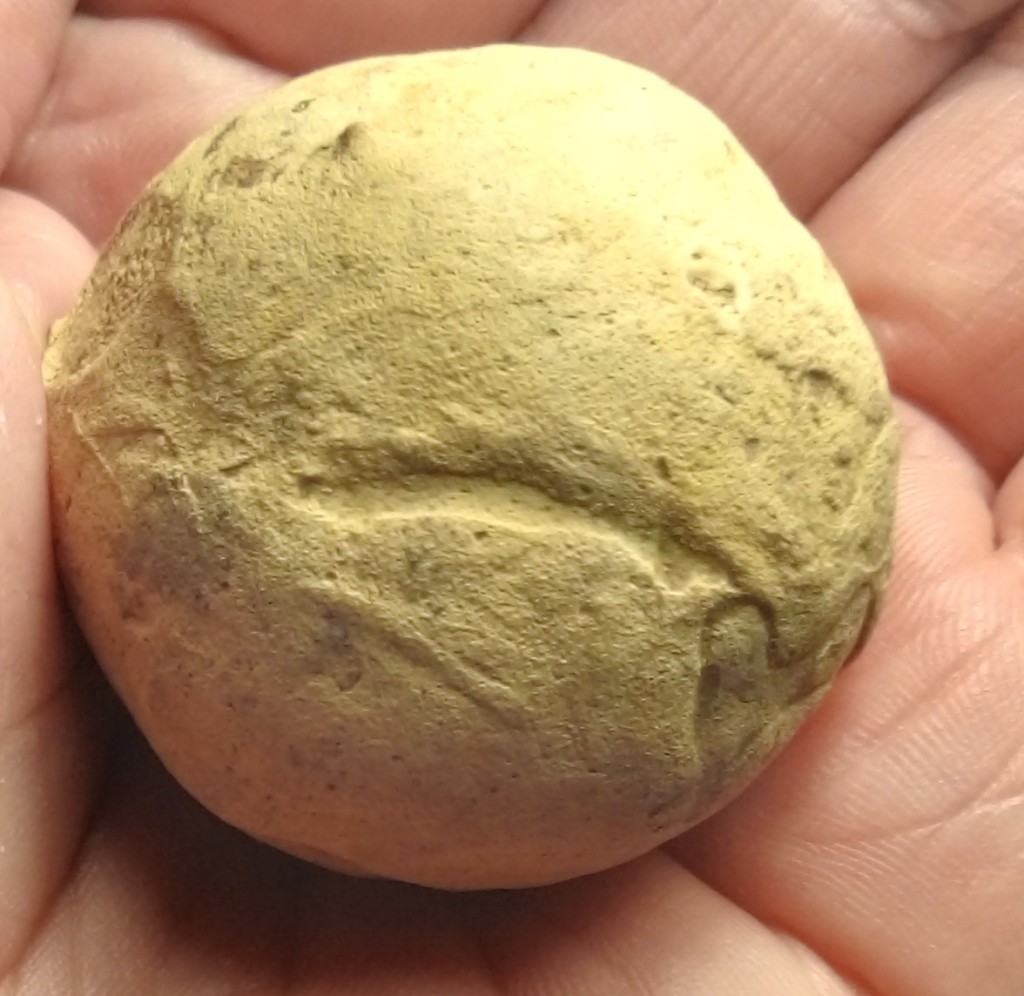
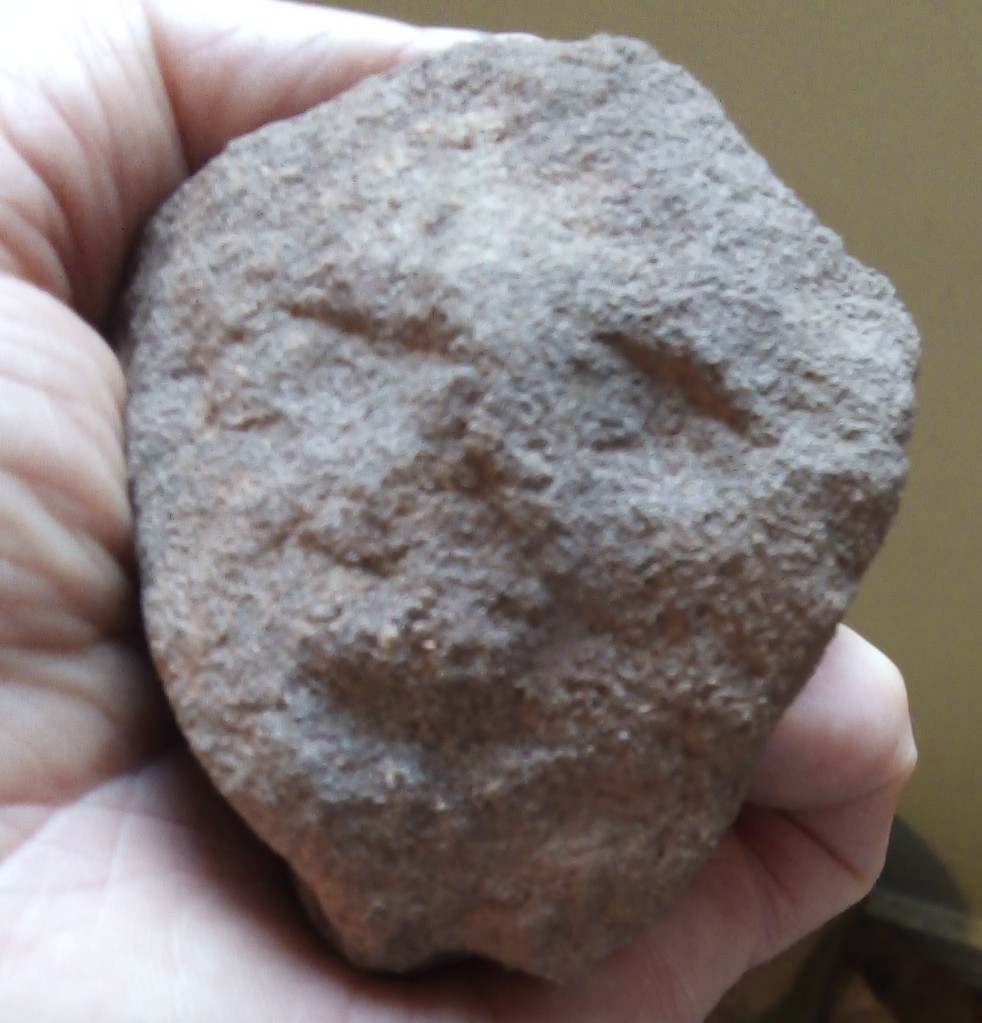


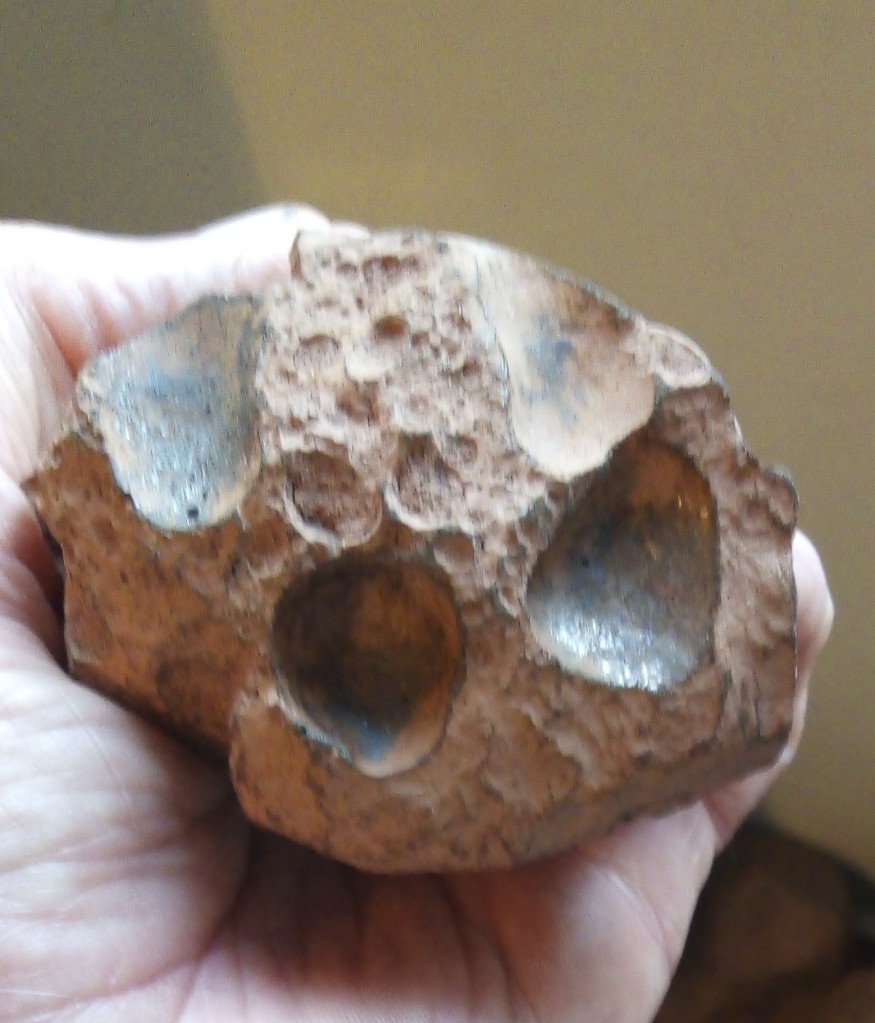

Find Spot within the demolished/robbed wall feature of Late Neolithic Altar structure, west end of temple, placed face down. Helen Hart suggested this primitive looking head may represent a genius cucullatus. This does appear likely and is particularly interesting. The find context suggests this head, with the less certain head below (H.173), were buried by the edge of the early 3rd century aedicula of the Period 3 Roman temple, when the south arm of the neolithic altar was pulled out and the apse was added. The aedicula was the shrine which would have housed the temple’s deity which is assumed to be Sabrina, goddess of the Severn. The genius cucullatus as a spirit of healing is a good explanation given the Littledean temple was a water shrine probably for healing. Both heads had become badly damaged and may be redeposited from the Early Roman period or earlier. In which case early 3rd century Romano Britons were well aware that these primitive examples of heads had been revered votive objects. This sits at complete variance with the Romano British classical heads of the period.


Find Spot adjacent, and touching H.172 above, this putative head was laid at right angles to the head end of 172 above but face upwards, rather than down as in 172. This head is badly damaged and worn. The forehead is shaped and there is the remnant of a protruding stub on one side. The eyes and nose however are badly damaged and worn away. The mouth is not obvious and possibly the tongue is just sticking out or maybe representing teeth.

Find Spot from Neolithic pit (NP2) in sealed context – a small crude head with exaggerated nose.

Find Spot from Neolithic pit (NP2) in sealed context – a small facial representation broken of a larger piece of sandstone. Given its context this is a putative facial image on a stone which the camera angle highlights as a face. Viewed face on it could be seen as natural marks creating an illusionary image

Find Spot from Neolithic pit (NP2) in sealed context – a crude simple face. The same applies to this image as 175 above.

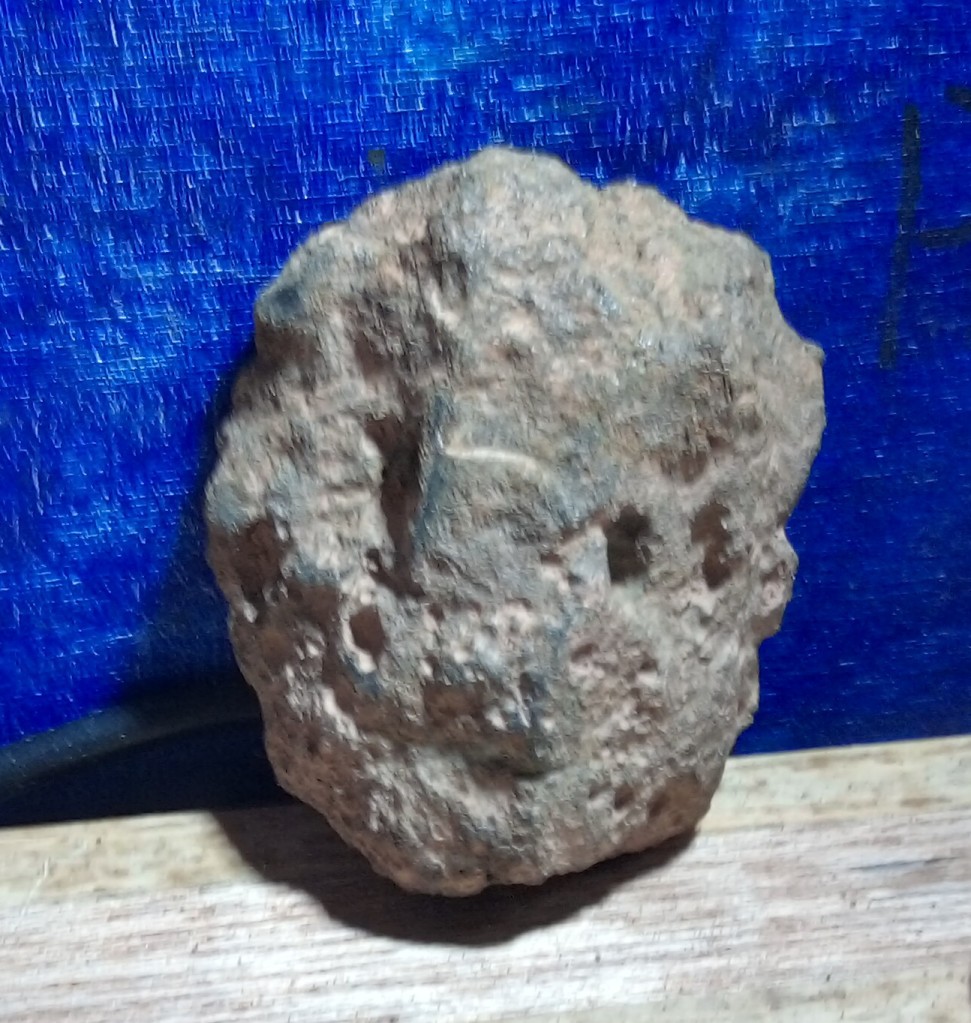
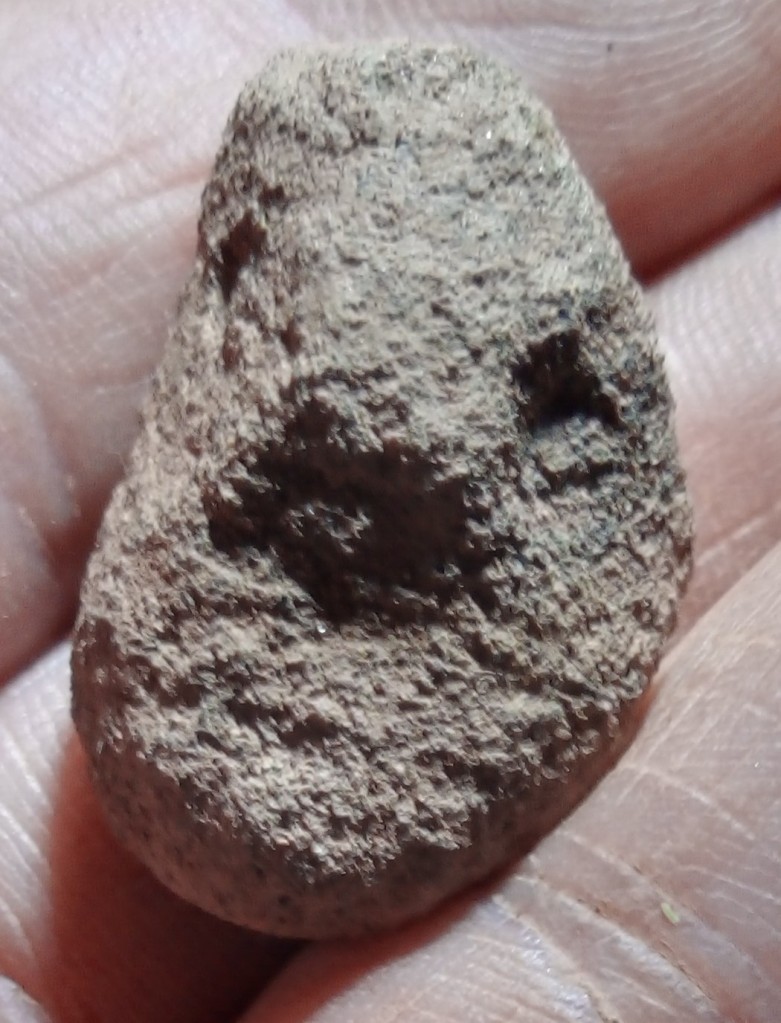


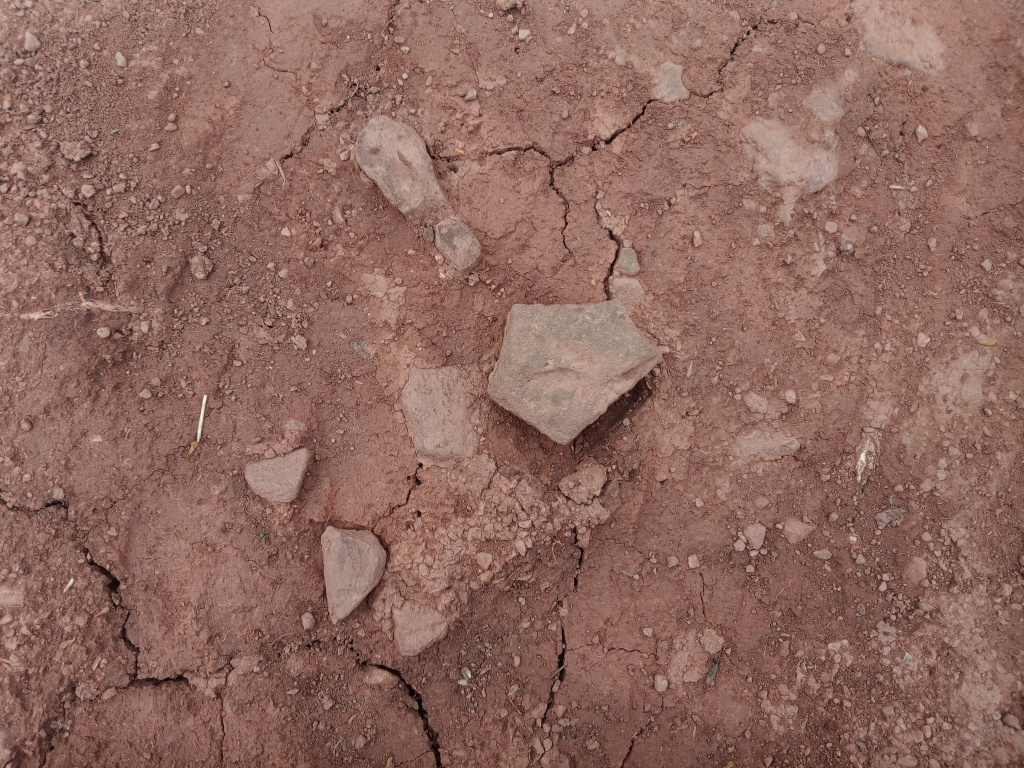





Find Spot a residual find from the silt of Rectangular pit 1. This eroded miniature head was clearly shaped from a piece of red ochre stone with minimal features of two dots for eyes and one for a mouth (see Head 190)

Find Spot disturbed fill near top of pit on the south side of ‘altar pad stone’. The head is uncertain although there are two short incisions possibly representing eyes and residual trace of a mouth. A residual beak like V is seen in other examples (52,59,60,61,62

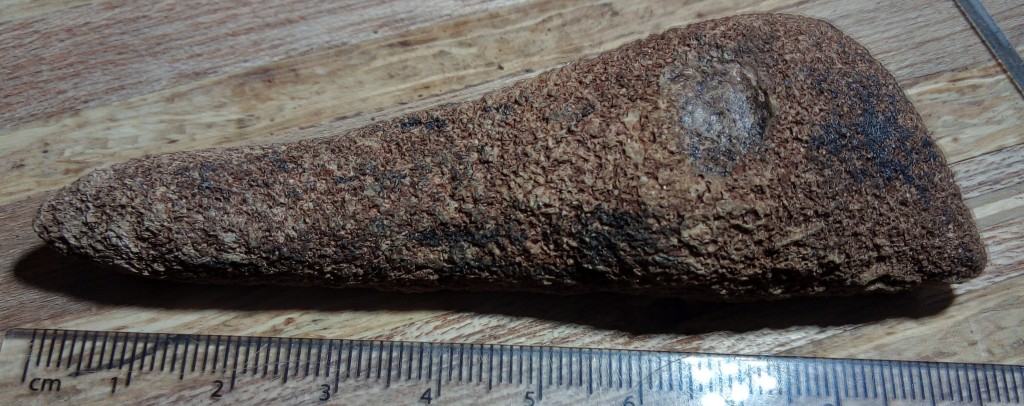
Find spot Pit 45 Bronze Age context closely associated with Heads 190 and 191. If this is a water worn pebble it has striations which may be consistent with grinding and shaping rather than tumbling in water and may be considered man made. The stone possibly came from the cliffs above the beach at Beachley, Chepstow near the Severn Bridge.
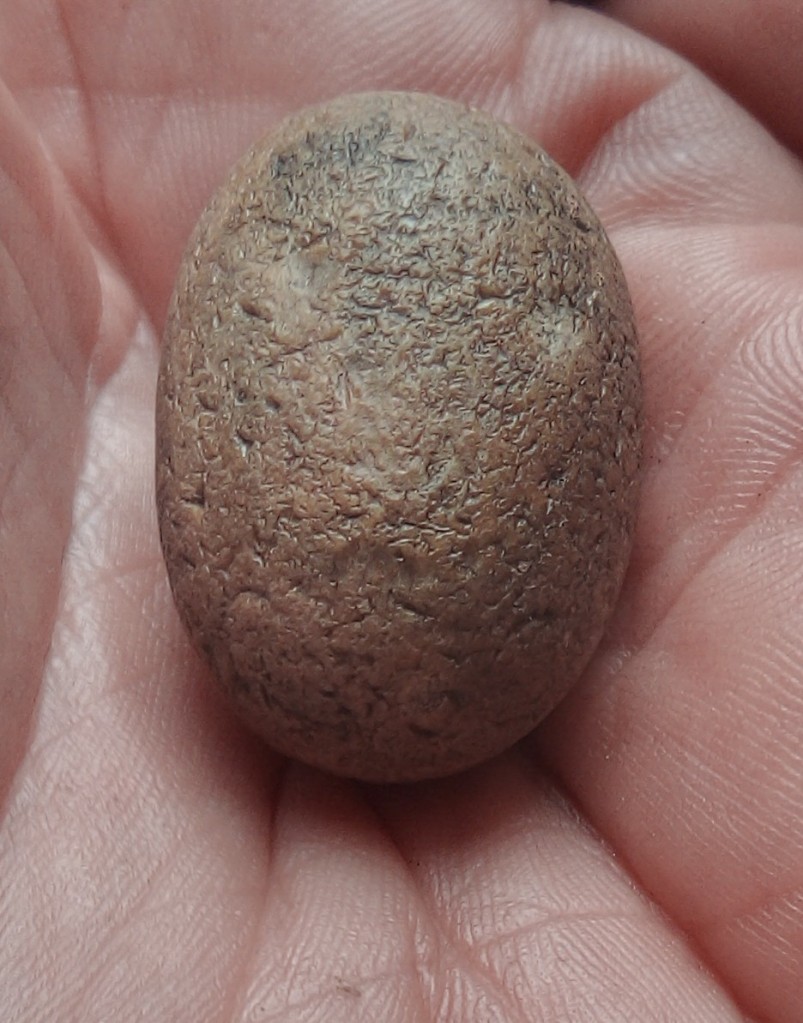
Find spot in silt above Bronze Age Layer 30 adjacent to Head 189. This is possibly a fossil sponge.
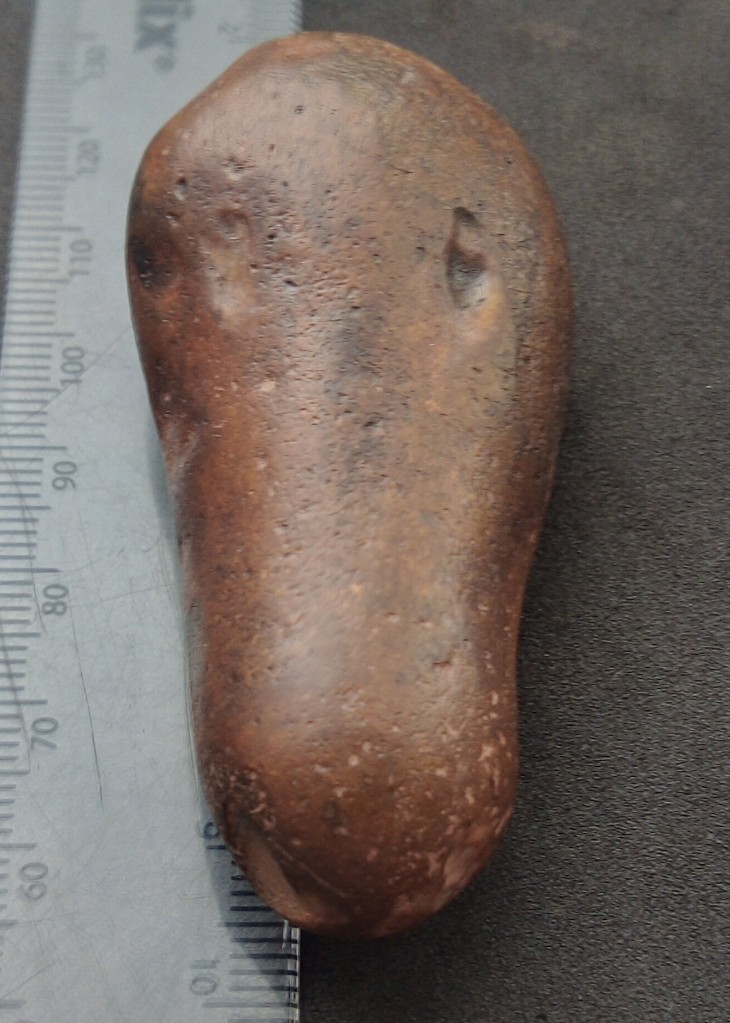
Find spot in silt above Bronze Age Layer 30 and impacted by the base of a possible late Roman water tank. 5 very late Roman coins recovered from the silt indicating all the solid paved and earlier floors had been removedthe same possible disturbed to position a probable wooden tank.

Find spot adjacent to Head 190 in black silt layer over Bronze Age Layer 30.

Find spot Pit 33 Memorial Ground Area A east side of altar this large crude sandstone head, 16 x 12cm has two ground hollows for eyes with raised pupils, was found face down and covered by silt in a water runnel draining from the original springhead pool now broadly dated to the Middle Bronze Age. The stone has areas worked smooth and shaped, including the forehead. There is no mouth and the nose is formed by the natural edge of the stone. Although the head falls broadly into my category ‘Bronderslev’ type with a secondary working retouch to create the eyes rather than use natural features of the stone, as with H.16 the Littledean the exemplar of the type category. There is no mouth and the head is a very good example of the perceived Celtic representation of silence and death (Armit 2006) (Benoit 1964). The head was recovered from a pit in the ‘memorial ground’ – pits with funerary type objects. Both stylistically and contextually it may belong to the latter part of the Middle Bronze Age or later.
the same possible disturbed
Find spot in south water runnel adjacent to ‘fieldstone altar plinth’ exposed by an archaeological sondage in September 2022. The two eyes are well groundand a smoothed and polished area between and below the eyes may represent a nose. The top of the mask is chipped away.
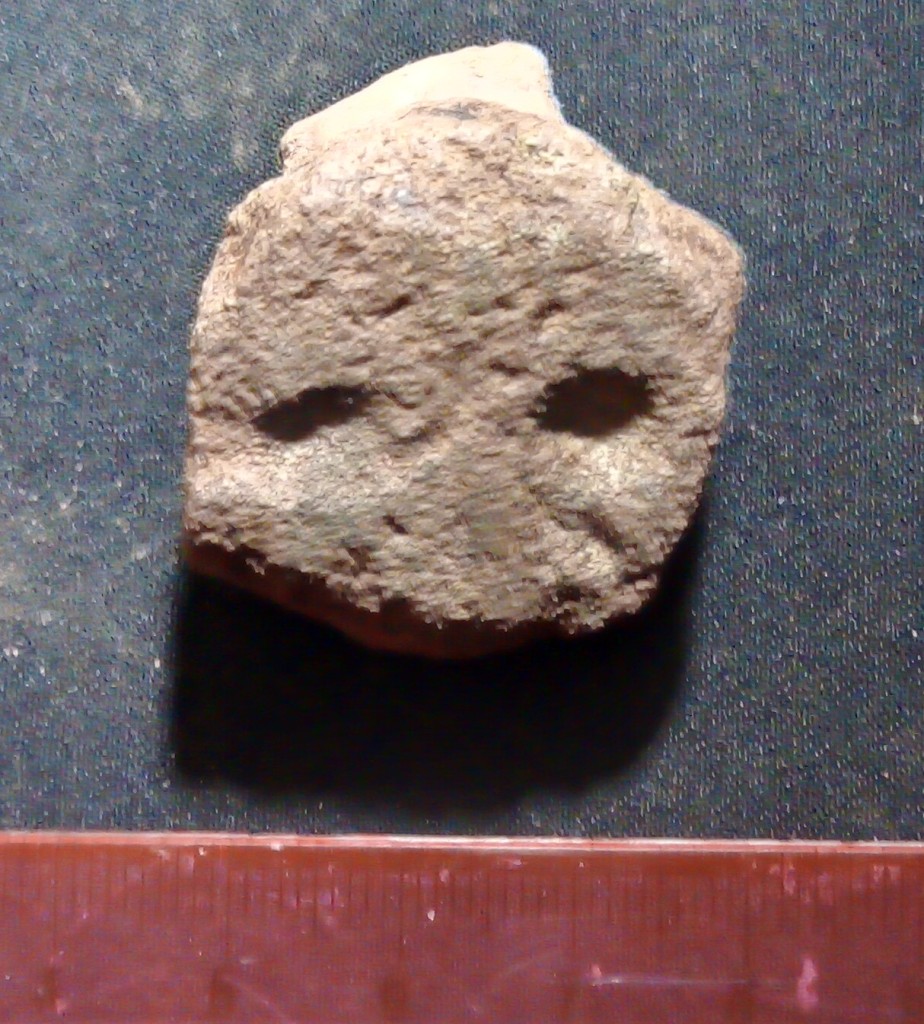
Find spot in water runnel 3 in similar context to Head 193.
Find spot in silt layer above Pit 40. This miniature face mask is ground and bevelled on both sides. The facial features are unfortunately heavily eroded as the mask was clearly very striking when freshly made.


Find spot in sondage east of altar and recovered from Pit 40. The face is framed at the base by a natural hairline crack and natural curve forming the chin. The facial features of right eye and base of nose were covered in ochre coloured deposit and cremation residue. The left eye was as it is. Residual colour is in the eye features. The facial features were ground into the fossil’s surface before becoming covered in cremation residues from the Middle Bronze Age, which probably equate with carbon 14 dating of the associated cemetery to the 13th century BC. It is the first head from the Bronze Age layers that can be securely dated through a combination of context and archaeological surface residues. If the identity as a head is correct it is of the first importance for dating the Littledean heads.
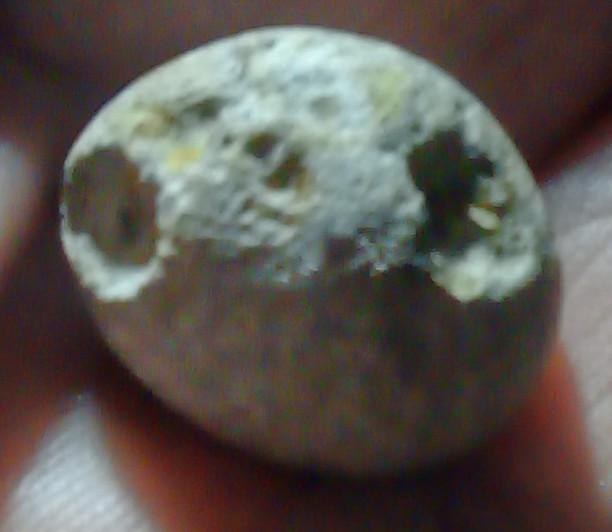
Find spot in Pit 33 Area A. This was the only object in the pit c. 0.35×0.30×0.15m deep and illustrates the practice of single artefact deposits during the Bronze Age had some subtle meaning that currently we can do little more than hazard guesses. It has been shown that during the Early Bronze Age the practice of depositing mortuary objects in pits as grave goods, was complex and advanced. The finds at Littledean from the later Middle Bronze Age are at the opposite scale and clearly have some meaning, but what that is remains elusive. The distinction is that it may be the only site where the association between votive pits and water goes appears to go hand in hand.

Find spot in base of post hole 15 of a putative small timber circle. The ‘slip’ paste covering is well preserved and this particular head has not been washed and has only received a light brush. The slip coat covers all surfaces sufficiently to demonstrate that no effort was made to create a neat finish.

Find Spot east edge of rubble plinth within silts of Pool 12 this miniature head was encased in wet clayey sand. Same context and near H.200 also with a number of very worn and pitted sandstones, all with traces of either burning or natural iron residues. Well defined nose and mouth. Striations to left side where face appears to have been deliberately ground away.
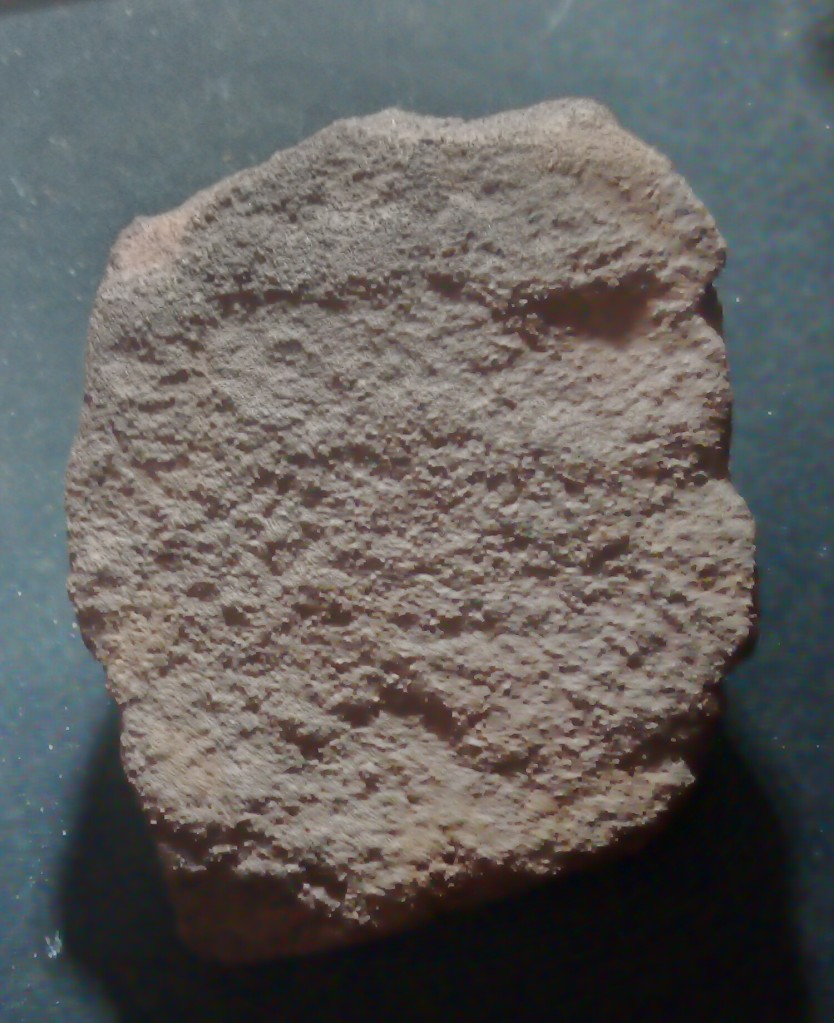
Find Spot east edge of rubble plinth within silts of Pool 12 this possible sandstone face mask was encased in wet clayey sand. Same context and near H.199 also with a number of very worn and pitted sandstones, all with traces of either burning or natural iron residues. This heavily eroded mask has significant traces of pinky/orange ‘slip coat’ colour back and front as if dipped in a west past.

Find spot in base of central channel of Pool 12A and collapse from the north inner bank of Pool 12A. It is the only example of a broken head with parts from separated contexts, probably during a period when the banks were collapsing. The sandstone has traces of surfaces grey-green lias deposits and is from the same type group of stone from the excavation of Pool 12A, which appears to be from Garden Cliff Westbury on Severn.

Find spot over silts of Pool 12C. It is a simple face mask worked into a reused piece of sandstone disturbed from the much earlier pool phase 12A. The sandstone has traces of surfaces grey-green lias deposits and is from the same type group of stone from the excavation of Pool 12A, which appears to be from Garden Cliff Westbury on Severn.


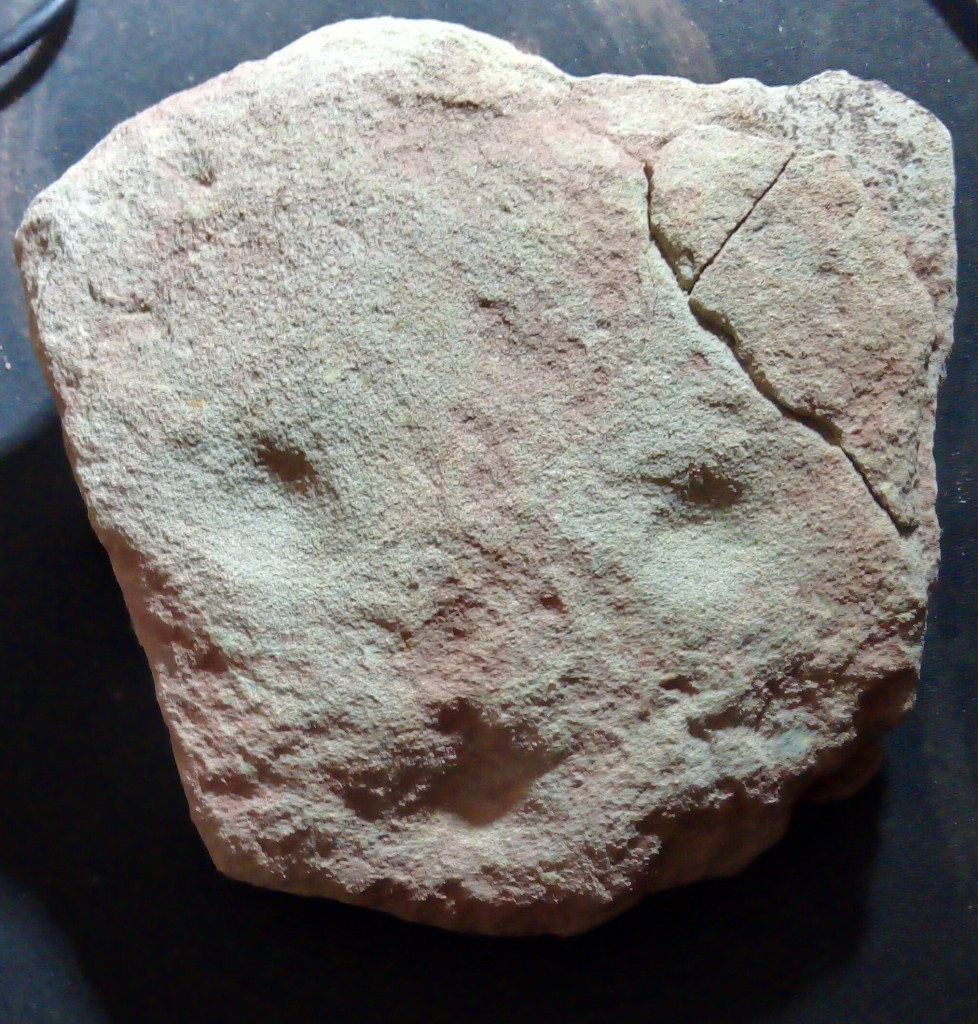
Find spot on edge of collapse from the north inner bank of Pool 12A, where the bank had slumped into central channel. The sandstone has traces of surfaces grey-green lias deposits and is from the same type group of stone from the excavation of Pool 12A, which appears to be from Garden Cliff Westbury on Severn.

Find spot buried within south inner bank of Pool 12A near head 207. The stone has traces of green colour and remnants of grey-green lias and is possibly Triassic sandstone from Garden Cliff at Westbury on Severn.
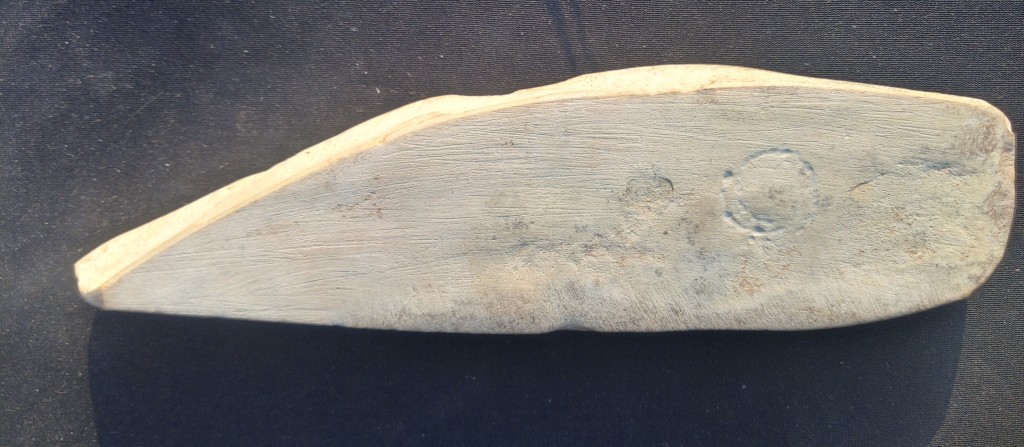
Find spot buried within south inner bank of Pool 12A. Traces of polish on front face and bevelled edges all around and rear indicate this unusual object was highly polished all over and has polishing score marks. When it was found it had a distinct speckling of blue on parts of the front side. The representation of an eye is a spiral. The ‘head’ may represent a water bird. The most likely point of origin for the stone is Garden Cliff at Westbury on Severn and is probably buff coloured lias.

Find spot in south outer bank of Pool 12A west side of nymphaeum wall
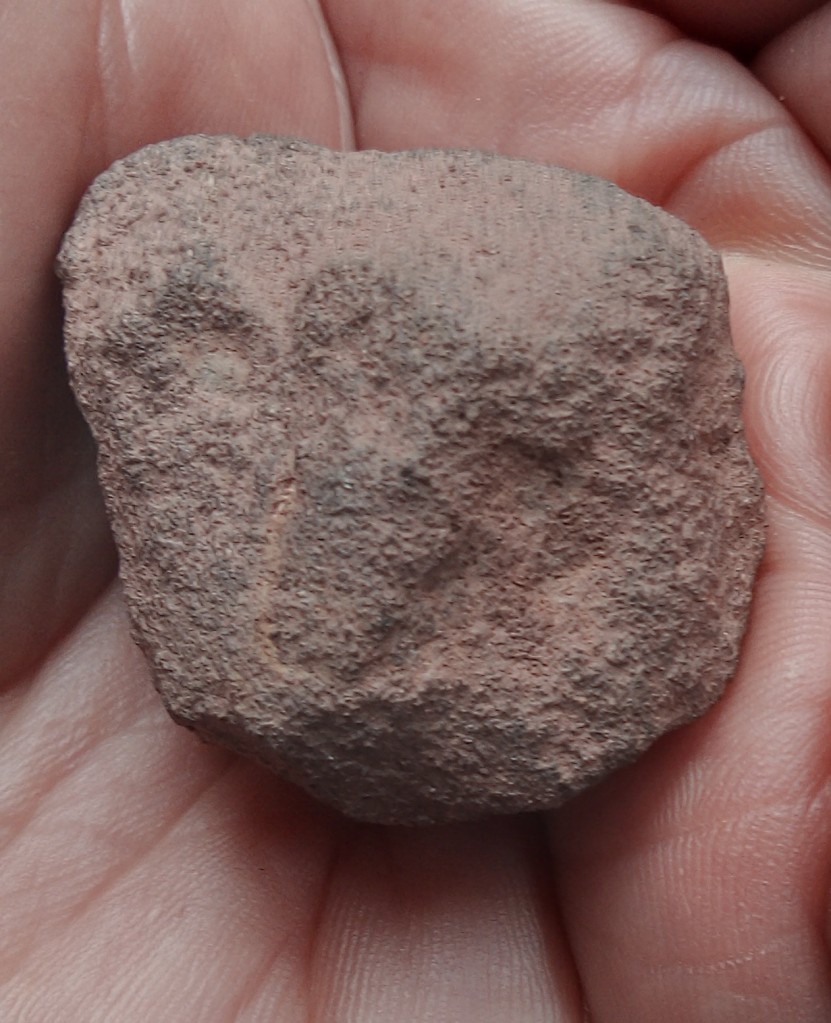



Find spot well sealed in north outer bank of Pool 12A this face mask closely matches heads 206, 205 and 201 all from good contexts sealed below clay silts in Pool 12A. The sandstone has traces of surfaces grey-green lias deposits and is from the same type group of stone from the excavation of Pool 12A, which appears to be from Garden Cliff Westbury on Severn. These heads appear to be all broadly contemporary. A number of heads from Bronze Age/Neolithic contexts appear as facial representations of two circular ground divots for eyes with representations of mouths as straight or curving ground incisions or another divot. Contextually they all belong to an early pool system below the Iron Age levels and appear to belong within a Bronze Age time frame. Along with H.161 and H.196 they are the earliest facial images from the site and may be the earliest representations of facial images found in Britain.
Current research indicates the heads, believed to be associated with the Garden Cliff Triassic Lias beds flanking the shore of the River Severn several kilometres away and visible from the temple site, are all broadly contemporary and lie broadly within a Late Bronze Age time frame. Their geology and find spots mark them out as profoundly important. Other deposited pieces of green and purple coloured sandstone within Pool 12A, closely matches stones fallen from the cliff and currently lying on the Severn foreshore. Combined with this evidence the lowest pool fill of 12A comprises eroded grey-green, red and white/buff fragments of friable grit again very similar to the material of small to tiny grits on the foreshore which is constantly eroding from the cliff. This material therefore appears to have been brought from the cliff and deposited in the pool, probably over time rather than all at once. The ritual implications are difficult to both grasp and understand. However this may be evidence of Bronze Age water ritual and river worship we are yet to understand. Furthermore not one of this group of heads is distinctly human and they are ‘naive’ and animal like. Combined with the fossil nodule type heads Pool 12A appears to be associated with a depositional practice reflecting zoomorphic images.
SUMMARY
With a much larger sample than first listed we can now see a more obvious division of size, style, geology and possible purpose in the Littledean heads. Can we see any evidence to support understanding that to the Celts the head was perceived as the seat of the soul? After viewing a 65 head sample in November 2019 Professor Miranda Aldhouse – Green identified a common theme whereby there is an emphasis on the eyes. Two retired medical authorities have noted this also. A number of heads suggest possible facial trauma and possibly head wounds are depicted. Numerous heads may be anthropomorphic and the head type I have coined as ‘Bronderslev head’ is noteworthy in one find area and rather than solely H.16 can now be identified in a significant number of heads. The miniature heads can also be seen increasingly as truly apotropaic votives and form a group growing in numbers and significance. They are anonymous heads sometimes with eyes nose and mouth, or just eyes and mouth or just eyes. Given the doubt amongst the academic community for a cult of the head represented by iconic imagery, the red ochre stained heads are of the first importance. Both these and several face masks perhaps do not readily fit the concept of healing, but whether they can be taken to be representative of individuals or gods is for specialists to judge. Notably the one mask, cut from the tar bearing sandstones near Telford , which exudes the natural black bitumin, may be the most important artefact of the Littledean typologies. The shape of the nose is strongly consistent with African ancestry and suggests this is a portrait head, in which case others may be also. The putative heads 175 and 176 are from the earliest secure contexts from the the site and should belong to the Bronze Age.The pebble heads 157 to 159 are assumed to be Iron Age, although the face image of 157 is identical to that on a recently discovered Neolithic macehead from the floor of Bronze Age Pool 12A, the exact image found on the Neolithic Folkton chalk drums. However such a simple facial image has currency up to the present day. The corpus of heads from Littledean provides huge potential for research and the development of new theories and concepts of Celtic culture.
As of late 2022 it appeared evident beyond reasonable doubt that the stone heads of Littledean, start appearing in the archaeological record within the Bronze Age layers: as of late 2023 that position has been strengthened by the finds from Pool 12A. Whether or not the miniature and crude heads I dub ‘Bronderslev type’ have any connection to these images the specialists must decide. Particularly notable is head 162 (emoji) which lined the side of a pit with a Middle Bronze Age cremation. That cremation context may have been intruded by an Iron Age pit, if not a post driven through the cremation, and the stone with emoji may have been a packing stone. The chalk ball H.161 is generally accepted as a neolithic artefact and the apparent facial imagery may represent the moon and have no relevance to the heads in general. Likewise the probable double sided figurine etched into a flat fossil (illustrated below), from a possibly disturbed Bronze Age context and alongside a neolithic flint hollow scraper, has facial imagery with no relevance whatsoever to the corpus of heads. The context of Head 196 appears to be definitively Middle Bronze Age and yet its identification as a facial image may be imagined as a result of naturally formed features on the fossil sponge. There are also other figurine type images from Littledean. It is probably reasonable to assume therefore that human imagery, whether of the body or of the head, has been portrayed in some form or other for ever. This is particularly evident in the Old World. Littledean is exceptional for the corpus of stratified stone heads as well as for the more limited number of facial type images etched on fossils such as heads 189,190 and 191 from earlier periods. Another interesting concept now emerging is that of the proxy head. It is becoming evident that single broadly oval/head shaped stones have been noted from time to time in contexts which should imply deliberate burial. Again this has recently been noted with the green/purple sandstone which appears to come from Garden Cliff. It raises questions whether or not it was always considered necessary to define stone heads through sculptural detail and perhaps anonymity was expressed by placing a stone with particular attributes of colour and shape. The Bronderslev type heads are possibly a manifestation of a progression of this concept.
The results of the research project at York University will therefore be very interesting indeed and much untangling of contexts and features will be necessary.

Two eyes, mouth and navel. An hourglass type cross is ‘scratched’ below the navel. Another figure is on the reverse.
This remarkable object c. 80mm high was recovered from adjacent to a Middle Bronze Age cremation pit. Next to it was a late 4th century AD Roman coin demonstrating the difficulty of dating through context.
nb. The editorial content of this page is changed as new evidence appears and the content should be taken as a guide only.